Browse our range of reports and publications including performance and financial statement audit reports, assurance review reports, information reports and annual reports.
Ministerial Statements of Expectations and Responding Statements of Intent

Please direct enquiries through our contact page.
Audit snapshot
Why did we do this audit?
- Regulation is an important function of the Australian Government. High quality regulation is important for society, the environment and the economy.
- Regulators and entities with regulatory functions are expected to have a Statement of Expectations (SOE) and Statement of Intent (SOI) in place.
Key facts
- In April 2021 a revised approach to setting expectations for regulator performance was adopted to improve the extent to which regulators had an SOE in place and up to date.
- The Department of Finance is responsible for regulatory policy and reform. It was funded to deliver oversight through a centrally coordinated and driven approach to supporting entities.
What did we find?
- Effective support is not being provided to ensure regulator SOE and SOI are in place.
- The Department of Finance’s regulator stocktake is not complete or accurate in relation to the regulatory functions that exist (and therefore who should have an SOE and SOI), or the SOE and SOI that are in place.
- Most of the regulator SOE and SOI that are in place have content that is consistent with guidance from the Department of Finance.
What did we recommend?
- There were four recommendations to the Department of Finance to improve the implementation of the regulator performance framework.
- The Department of Finance agreed to two recommendations and agreed in principle with two recommendations. Other entities that responded to the recommendations agreed to them or supported them, or noted them.
103
regulatory functions across 67 regulators with 35 SOE identified in Finance’s regulator stocktake.
21
regulators (at least), and at least 21 SOE, not included in the stocktake.
34
entities with regulatory functions that do not have an SOE.
Summary and recommendations
Background
1. Regulations are sets of rules established by government authorities that aim to deliver better economic, social, and environmental outcomes for Australians and businesses.1 The Australian Government’s regulator performance framework was first established in 2014. In April 2021, to improve the extent to which regulators had a Statement of Expectations (SOE) in place and up to date, a revised approach to setting expectations for regulator performance was adopted. The key element was a renewed focus on the SOE and responding Statement of Intent (SOI), to be updated with every: change in minister, regulatory leadership or Commonwealth policy; or every two years.
2. SOE are issued by responsible ministers to a regulator to provide ‘greater clarity about government policies and objectives relevant to the regulator in line with its statutory objectives and the priorities the minister expects it to observe in conducting its operations’. Statements of Intent (SOI) respond to the expectations set out in Ministerial Statements of Expectations, outlining ‘how the regulator intends to meet those expectations including how it will demonstrate progress.’2 The importance of publication of SOE was highlighted in 2004: ‘allowing the Parliament and the community to be aware of government’s expectations and the responses by statutory authorities.’3
3. From 1 July 2022, responsibility for regulatory policy and reform (including maintenance of the Australian Government regulator stocktake) moved from the Department of the Prime Minister and Cabinet to the Department of Finance (Finance). Finance was provided with $38.19 million in the October 2022–23 Budget for regulatory policy and reform. In the 2023–24 Mid-Year Economic Fiscal Outlook, a further $27.9 million was provided across the forward estimates, with $9.4 million per annum ongoing from 2027–28. With the resources it had been provided, Finance identified that it would be able to deliver oversight through a centrally coordinated and driven approach to support entities to improve regulatory systems.
4. In December 2022 Finance issued Regulator Performance (Resource Management Guide (RMG) 128).4 It replaced the Regulator Performance Guide of July 2021. RMG 128 was updated in July 2023. Finance has also issued a guidance note for RMG 128. The guidance note sets out that Finance’s role involves ‘supporting ministers, departments and regulators to issue or refresh Ministerial Statements of Expectations for regulators, and corresponding Regulator Statements of Intent’, and that this includes assisting entities to apply the definitions to functions within their remit. It also provides SOE considerations for different governance models and information on what SOE and SOI should contain.
5. The regulator performance framework outlines that an SOE and responding SOI ‘should’ be in place and refreshed at least every two years. SOE and SOI are not mandated. In this respect, in February 2025, the Department of Finance (Finance), which has stewardship responsibility for the regulator performance framework advised the ANAO that:
Ultimately, however, ministers and accountable authorities are responsible for identifying and settling the regulatory functions within their responsibilities, and whether a Statement of Expectations is issued to a regulator is a matter for the relevant minister. As such, while Finance will continue to support these activities, it is neither appropriate nor meaningful for Finance to take a compliance role in relation to RMG 128.
6. In a March 2025 report, the Joint Committee of Public Accounts and Audit made findings and a recommendation relating to regulator SOE and SOI. The Committee also made a recommendation to Finance about its approach to stewardship of the framework (see further at paragraphs 1.6 to 1.8).
Rationale for undertaking the audit
7. Regulation is an important function of the Australian Government and high-quality regulation — whether of the private, not-for-profit or public sector — is important for the effective functioning of the economy, society and the environment. Australian government regulators and those responsible for regulatory functions are expected to have a current SOE and SOI in place. SOE and SOI are a key accountability mechanism to ensure regulators fulfil their statutory objectives in line with government expectations and policy, and provide transparency to regulated parties. This audit provides assurance to the Parliament about this element of the regulator performance framework.
Audit objective and criteria
8. The audit objective was to assess the effectiveness of the framework in place to have a regulatory Ministerial SOE and a responding SOI in place.
9. To form a conclusion against the objective, the ANAO examined:
- Which functions are subject to Ministerial Statements of Expectations and responding Regulator Statements of Intent?
- What Ministerial Statements of Expectations and responding Regulator Statements of Intent are in place?
Conclusion
10. Regulator Statements of Expectations and Statements of Intent are not in place to cover all regulatory functions. The extent to which regulatory functions are not covered by an SOE and SOI reflects that Finance’s approach to stewardship has not provided oversight through a centrally coordinated and driven approach to support entities. Where entities with regulatory responsibilities do not have an up-to-date SOE and SOI, it is more difficult for the regulator to have clarity about relevant government objectives and the priorities the minister expects the regulator to pursue. The absence of an up-to-date SOE and SOI also impairs transparency and accountability given the statements are meant to be publicly available and provide the basis for regulator performance reporting.
11. There is not a comprehensive list of Australian Government regulators and regulatory functions. Finance’s regulator stocktake does not provide a complete picture of regulatory functions and regulators as there are at least a further 21 regulatory functions in addition to those included in the stocktake. The stocktake also does not provide a complete picture of the Statements of Expectations and responding Statements of Intent that have been issued. This situation reflects that the framework in place does not mandate SOE and SOI be in place, accountable authorities are not always meeting expectations (in part due to shortcomings in the guidance promulgated by Finance) and Finance’s stewardship approach has not provided oversight through a centrally coordinated and driven approach to supporting entities.
12. As of December 2024, there were 57 SOE and 49 SOI in place across 90 regulators.5 Of the 90 regulators:
- at least6 18 regulators (20 per cent) had an SOE in place that covered all of their regulatory functions;
- at least 14 regulators (15 per cent) had an SOE in place that covered some of their regulatory functions; and
- 34 (38 per cent) did not have an SOE in place.
13. Most of the regulator SOE and SOI that are in place have content that is consistent with guidance from the Department of Finance. The main areas where the guidance is not being met include: SOE not outlining how the responsible minister will engage with the regulator and, similarly, SOI not addressing how the regulator intends to engage with policy departments and the minister at a high level; and SOE not requesting regulators incorporate them into their corporate plan and annual report.
Supporting findings
Regulators and regulatory functions
14. There is no comprehensive list of regulators and regulatory functions. The identification of regulators and regulatory functions required to have a Statement of Expectations and responding Statement of Intent is based on definitions in Regulator Performance (RMG 128). The definitions require improvement so that accountable authorities are able to identify when Statements should be in place. (See paragraphs 2.2 to 2.28)
15. As of December 2024, the Department of Finance’s regulator stocktake identified 67 regulators across 52 Commonwealth entities having one or more regulatory functions, and that there were 35 SOE in place. The stocktake is incomplete as it does not recognise all regulators or Statements that are in place. Of note, there are at least a further:
- 21 regulators with regulatory functions in addition to those included in the stocktake; and
- 21 SOE in place that are not recognised in the stocktake. This comprises a mixture of entities included in the stocktake with the stocktake not recognising the existence of the SOE and regulatory functions not included in the stocktake where there is an SOE. (See paragraphs 2.29 to 2.44)
Regulator statements
16. As of December 2024, there were at least 57 regulatory Statements of Expectations in place. There were regulatory functions identified by the ANAO that were not covered by a Statement of Expectations (either because the entity did not have a Statement of Expectations, or the Statement of Expectations did not cover all regulatory functions). (See paragraphs 3.2 to 3.23)
17. Most of the Statements of Expectations have content that identifies the government’s expectations. The content of the documents is largely consistent with guidance from the Department of Finance. The main areas where the guidance is not being met comprises: SOE not outlining how the responsible minister will engage with the regulator; SOE not requesting the regulator respond with a Statement of Intent; and SOE not requesting regulators incorporate the statements into their corporate plan and annual report. (See paragraphs 3.24 to 3.27)
18. As of December 2024, there were 49 regulatory Statements of Intent in place. Eight of these had been in place for more than two years. (see paragraphs 3.28 to 3.31)
19. The Regulator Statements of Intent that are in place identify how the government’s expectations will be delivered, consistent with guidance from the Department of Finance. (See paragraphs 3.32 to 3.38)
Recommendations
Recommendation no. 1
Paragraph 2.24
The Department of Finance:
- improve the structure and content of its guidance on the regulator performance framework, including the definition of a regulator and regulatory function, so as to better support accountable authorities to meet the expectation that there be a Statement of Expectations and a Statement of Intent in place for regulatory functions; and
- consider whether the policy intent is able to be achieved through the approach set out in Regulator Performance (Resource Management Guide (RMG) 128), including having regard to whether approaches adopted in other jurisdictions may be more effective.
Department of Finance response: Agreed.
Other entities that agreed or supported the recommendation: Australian National University, Department of Defence, Department of Industry, Science and Resources, Department of the Treasury, National Anti-Corruption Commission, Sydney Harbour Federation Trust and Wine Australia.
Other entities that noted or acknowledged the recommendation: Australian Digital Health Agency, Australian Radiation Protection and Nuclear Safety Agency, Department of Agriculture, Fisheries and Forestry, Department of Education, Department of Employment and Workplace Relations, Department of Health, Disability and Ageing, Department of Veterans’ Affairs, IP Australia, Office of the Fair Work Ombudsman and Professional Services Review.
Recommendation no. 2
Paragraph 2.42
The Department of Finance strengthen its approach to the regulator stocktake by:
- undertaking its own research and analysis in addition to seeking input from entities in order that the stocktake is a complete and accurate record of all Australian Government regulatory functions, regulators and Statements of Expectations and Statements of Intent; and
- identifying an appropriate mechanism to ensure accountable authorities inform it when a Statement of Expectations or Statement of Intent has been issued or refreshed.
Department of Finance response: Agreed in principle.
Other entities that agreed or supported the recommendation: Australian National University, Department of Defence, Department of Industry, Science and Resources, Department of the Treasury, Sydney Harbour Federation Trust and Wine Australia.
Other entities that noted or acknowledged the recommendation: Australian Digital Health Agency, Australian Radiation Protection and Nuclear Safety Agency, Department of Agriculture, Fisheries and Forestry, Department of Education, Department of Employment and Workplace Relations, Department of Health, Disability and Ageing, Department of Veterans’ Affairs, IP Australia, Office of the Fair Work Ombudsman and Professional Services Review.
Recommendation no. 3
Paragraph 3.11
The Department of Finance improve the guidance it provides to entities on the circumstances in which entities with a regulatory function are not expected to have a Statement of Expectations or Statement of Intent in order that accountable authorities can provide appropriate support to ministers.
Department of Finance response: Agreed.
Other entities that agreed or supported the recommendation: Australian National University, Department of Defence, Department of Industry, Science and Resources, Department of the Treasury, National Anti-Corruption Commission, Sydney Harbour Federation Trust and Wine Australia.
Other entities that noted or acknowledged the recommendation: Australian Digital Health Agency, Australian Radiation Protection and Nuclear Safety Agency, Department of Agriculture, Fisheries and Forestry, Department of Education, Department of Employment and Workplace Relations, Department of Health, Disability and Ageing, Department of Veterans’ Affairs, IP Australia, Office of the Fair Work Ombudsman and Professional Services Review.
Recommendation no. 4
Paragraph 3.34
The Department of Finance improve the extent to which regulatory functions are covered by Statements of Expectations and Statements of Intent by engaging with all entities that have regulatory functions by:
- where Statements are not in place, working with the entity (and the portfolio department, as appropriate) to develop and publish Statements that accord with the content requirements of Resource Management Guide 128 and cover all regulatory functions of each regulator;
- monitoring the currency of existing Statements, and engage with entities to draw attention to the need for any updates;
- identifying all regulatory functions in the regulator stocktake, including in circumstances where Statements are not in place to cover regulatory functions; and
- identifying opportunities to maximise the value that regulators gain from having Statements of Expectations and Statements of Intent.
Department of Finance response: Agreed in principle.
Other entities that agreed or supported the recommendation: Australian National University, Department of Defence, Department of the Treasury, Sydney Harbour Federation Trust and Wine Australia.
Other entities that noted or acknowledged the recommendation: Australian Digital Health Agency, Australian Radiation Protection and Nuclear Safety Agency, Department of Agriculture, Fisheries and Forestry, Department of Education, Department of Employment and Workplace Relations, Department of Health, Disability and Ageing, Department of Industry, Science and Resources, Department of Veterans’ Affairs, IP Australia, Office of the Fair Work Ombudsman and Professional Services Review.
Summary of entity responses
20. The proposed audit report was provided to the Department of Finance and other regulators. Fifty one regulators provided responses to the ANAO, including 28 regulators that provided formal letter responses set out at Appendix 1. Improvements observed by the ANAO during the course of this audit are listed at Appendix 2.
Department of Finance
The Department of Finance (Finance) welcomes the report and agrees to recommendations 1 and 3, and agrees in principle to recommendations 2 and 4.
Finance’s stewardship role supports government, entities and regulators by providing principles-based advice and guidance to ensure regulatory systems remain fit-for-purpose and easy to navigate and interact with. Finance will continue to provide oversight of regulatory performance by providing specific guidance and support to entities regarding RMG 128, and the development of SOE/SOIs. The findings of the report are instructive, and the recommendations provide an opportunity to take a broader view of how Finance can better support regulatory policy makers and regulators in achieving the policy intent of the regulator performance framework, improve transparency and accountability through the Australian Government regulator stocktake and support regulators to report against the 3 principles of best practice.
Finance is already undertaking work to revise the definition of regulator and regulatory function, improve the completeness and accuracy of the Australian Government regulator stocktake to the extent possible, and refine how we support regulatory policy makers and regulators. We also note report by the Joint Committee of Public Accounts and Audit (JCPAA) inquiry into the administration of Commonwealth regulations (JCPAA Report) on 27 March 2025 makes complementary findings and recommendations.
Australian Energy Regulator
The AER was provided with extracts from the proposed report.
The AER notes that there are no findings or recommendations relating to the AER.
The AER notes the contents of the report, including the key messages. The AER publishes Statements of Expectations and Statements of Intent on the AER website.
Attorney-General’s Department
The department and relevant portfolio entities appreciate the opportunity afforded from the ANAO audit process to improve the operation of Ministerial Statements of Expectations and Responding Statements of Intent. We note the report appropriately reflects commentary provided from the portfolio during the audit process on the available guidance and entity views on being characterised as undertaking regulatory functions under current guidance. We note the four recommendations made to the Department of Finance and the key messages for all Australian Government entities. Further guidance on the definition of regulators, regulatory functions and requirements for Statements of Expectations or Statements of Intent will ensure better understanding and compliance across the Commonwealth.
Australian National University
The Australian National University (the University) welcomes the Australian National Audit Office’s (ANAO) Proposed Audit Report on Ministerial Statements of Expectations and responding Regulator Statements of Intent.
The Australian National University Act 1991 authorises the Council of the University to make statutes for or in relation to the regulation or control of traffic, or of the parking, stopping, standing or leaving of vehicles, on land occupied by the University in the ACT. The University does so through the Australian National University (Parking and Traffic) Statute 2019.
The University agrees with the ANAO’s assessment outlined in Table 2.1 and supports the recommendations within the Audit Report.
Department of Agriculture, Fisheries and Forestry
The Department of Agriculture, Fisheries and Forestry (the department) welcomes the audit report and acknowledges findings and recommendations of the Australian National Audit Office.
The department remains committed to working closely with the Department of Finance (DOF) to strengthen regulatory stewardship. This includes the ongoing implementation of Resource Management Guide 128: Regulator Performance (RMG 128), supported by the Statement of Expectations (SOE) and Statement of Intent (SOI).
The department acknowledges the proactive support and monitoring provided by DOF in progressing the SOE and SOI, including seeking regular updates on progress and valuable advice to help DAFF meet RMG 128 requirements.
The department also appreciates the acknowledgement of its ongoing efforts to establish a current SOE and SOI despite challenges posed by changes in Minister and regulatory leadership. The most recent SOE was signed on 30 January 2025, and while a draft SOI was prepared, it was not finalised before commencement of the caretaker period. Further work will be paused pending the outcomes of the election.
While not directly responsible for the audit recommendations, the department will stay informed of initiatives aimed at addressing audit findings and will support, engage and participate where appropriate.
Department of Defence
Defence welcomes the Auditor-General’s observations and audit findings into Ministerial Statements of Expectations and Responding Statements of Intent, and supports the recommendations.
Defence shares the views expressed by other Commonwealth agencies concerning the ambiguities identified within Resource Management Guide 128. In particular, that the definition of regulatory functions needs to be clarified to ensure consistency of application across agencies.
Department of Education
The department welcomes the report. The report highlights the importance of high-quality regulation and the role of regulator Statements of Expectations and responding Statements of Intent in promoting accountability and transparency. The department will continue to work closely with the Department of Finance as we refresh these documents over the coming year.
Department of Employment and Workplace Relations
The Department of Employment and Workplace Relations (the department) notes the audit’s overall findings and recommendations for the Department of Finance to improve the regulator performance framework, the approach to the regulator stock take, and to ensure Statements of Expectations and Statements of Intent are in place. The department recognises its own responsibilities as a regulator with reporting obligations under Resource Management Guide 128.
The department acknowledges and supports the key audit messages, and welcomes the insights provided by the instances of good practice highlighted in the report. These are essential for all Australian Government entities in ensuring effective governance and risk management in the provision and maintenance of Statements of Expectation and responding Statements of Intent.
The department will respond to any support requested by the Department of Finance in implementing each of the 4 Recommendations to improve the regulator performance framework as set out in Resource Management Guide 128.
Department of Health, Disability and Ageing
The Department of Health and Aged care (the Department) acknowledges the findings in the report and notes the recommendations directed to the Department of Finance.
It was pleasing to note the Departmental SOE met the requirements of Regulator Performance (RMG-128), except for the requirement to refresh the Ministerial Statements of Expectations (SOE) upon change of the Secretary. This will be done following the election when the ministry is known. The Regulator Statements of Intent (SOI) was assessed as fully compliant with RMG128.
There are no recommendations directed to the Department. However, the Department would be indirectly involved to help implement the various recommendations by way of changes or updates to some of our departmental and portfolio regulator’s SoE and responding SOI. To address this the Department has contacted the departmental and portfolio regulators and commenced the work to update the SOEs and SOIs.
Department of Industry, Science and Resources
The Department of lndustry, Science, and Resources (the department) notes the Australian National Audit Office’s proposed audit report on Ministerial Statements of Expectations (SOE) and Responding Regulator Statements of lntent (SOI).
The department notes findings in the report and agrees with the recommendations 1 to 3 made to the Department of Finance (Finance).
The department notes recommendation 4, that Finance improve the extent to which regulatory functions are covered by Statements of Expectations (SOE) and responding Regulator Statements of lntent (SOI). The department considers that the approach taken in resource management guide 128 to minor regulatory functions, is sensible. This is equally applicable to individual regulator SOEs.
Department of the Treasury
Treasury welcomes the report and will continue to work with regulators within its portfolio to support ministers in ensuring Ministerial Statements of Expectations and responding Statements of Intent are current and accessible.
In respect of recommendation 1 (b), Treasury agrees with the ANAO assessment and is of the view that Statement of Expectations and Statement of Intent requirements should be improved and separated from RMG128 into a distinct guide. Linking it to RMG128 provides minimal benefit to performance reporting which is already covered by the better practice principles and could detract from the strength and authority of the entity’s purposes and key activities. Treasury recognises these are important transparency documents developed between the regulator and the Government, but it is unnecessary to link these to the corporate plan and annual report that are owned by the accountable authority. This is particularly significant where the regulator and the accountable authority are different roles.
National Offshore Petroleum Safety and Environmental Management Authority
I acknowledge:
- the NOPSEMA Statement of Expectations was signed by Minister King on 29 June 2022 and NOPSEMAs Statement of Intent was signed on 2 September 2022 by the previous CEO. We look forward to receiving a new Statement of Expectations in due course.
- whilst the statements were both completed prior to my tenure at NOPSEMA in February 2023, I am dedicated to fulfilling the expectations and intentions of the statements. A commitment is made by the position of CEO and therefore I undertake the duties of the CEO including any Statements of Expectations or Intentions. Indeed, when Minister King and I meet, we discuss NOPSEMA’s performance and delivery against these statements.
- the OIR received Minister Bowen’s Statement of Expectations on 19 December 2024. OIR’s Statement of Intent was finalised on 18 March 2025 and is available on the OIR website.
- the statements of expectations and intent for NOPSEMA and OIR are the foundation for NOPSEMA’s delivery strategies and key performance measures.
Office of the Special Investigator
The Office of the Special Investigator (OSI) is an independent Executive Agency under section 65 of the Public Service Act 1999 and is a non-corporate Commonwealth entity under Schedule 1 of the Public Governance, Performance and Accountability Rule 2014. The agency does not have specific enabling legislation. Its authority to act is derived from functions specified in the Executive Order.
Under the Executive Order, the OSI, jointly with the Australian Federal Police (AFP), is investigating allegations of war crimes by members of the Australian Defence Force in Afghanistan from 2005 to 2016. The roles and responsibilities of the OSI include no reference to regulation; the OSI does not administer or enforce any regulations or laws, nor can it.
It is my view as the Accountable Authority of the OSI, that it is not within the scope of the audit objectives and need not be captured by the audit report.
Parliamentary Workplace Support Service
PWSS welcomes the feedback from the Australian National Audit Office (ANAO) and will support the Department of Finance with implementing relevant recommendations.
Professional Services Review
Professional Services Review (PSR) is one small part of the regulation of the provision of Medicare, dental benefits, and Pharmaceutical Benefits Scheme (PBS) services within the Health and Aged Care portfolio. The legislation does not enable PSR to set its own agenda but must respond to the cases referred to it by the Chief Executive Medicare. Consequently, there is no capacity for it (independent of the portfolio department) to develop ‘major projects’ initiate ‘reforms’ or engage in ‘key developments’ of a nature that would be of such significance as to include in a Ministerial Statement of Expectations.
Wine Australia
Wine Australia:
- agrees with each of the recommendations in the proposed report under section 19 of the Auditor-General Act 1997 re Ministerial Statements of Expectations and Responding Statements of Intent dated 17 March 2025; and
- is ready, willing and able to assist and/or engage with the Department of Finance in response to those recommendations as needed.
Key messages from this audit for all Australian Government entities
21. Below is a summary of key messages, including instances of good practice, which have been identified in this audit and may be relevant for the operations of other Australian Government entities.
Governance and risk management
1. Background
The regulator performance framework
1.1 Regulations are sets of rules established by government authorities that aim to deliver better economic, social, and environmental outcomes for Australians and businesses.7 The Australian Government’s regulator performance framework was first established in 2014. It involved voluntary ‘Statements of Expectations’ (SOE)8 and a set of six outcomes-based key performance indicators assessed through annual self-assessment.
1.2 SOE are issued by responsible ministers to a regulator to provide ‘greater clarity about government policies and objectives relevant to the regulator in line with its statutory objectives and the priorities the minister expects it to observe in conducting its operations’. Statements of Intent (SOI) respond to the expectations set out in Ministerial Statements of Expectations, outlining ‘how the regulator intends to meet those expectations including how it will demonstrate progress.’9 The importance of publication of SOE was highlighted in 2004: ‘allowing the Parliament and the community to be aware of government’s expectations and the responses by statutory authorities.’10 Similarly, guidance from the Organisation for Economic Cooperation and Development (OECD) is that defining a regulator’s relationship, responsibilities and lines of accountability through an SOE is ‘central to both external governance arrangements and independence’.11
1.3 In April 2021, the Australian Government was advised by the Department of Prime Minister and Cabinet (PM&C) that one-third of regulators had a publicly available SOE and that 60 per cent of SOE were more than two years old, with 50 per cent having a responding Regulator Statement of Intent (SOI).12 To improve this situation, a revised principles and outcomes-based approach to setting expectations for regulator performance was to be adopted. This approach would apply to stand-alone regulators as well as those that administered regulatory functions within policy departments. The key element was a renewed focus on the SOE and responding SOI, to be updated with every: change in minister, regulatory leadership or Commonwealth policy or every two years.
1.4 The regulator performance framework outlines that an SOE and responding SOI ‘should’ be in place and refreshed at least every two years. SOE and SOI are not mandated through for example, the Public Governance, Performance and Accountability Rule 2014 (PGPA Rule).13 In this respect, in February 2025, the Department of Finance (Finance), which has stewardship responsibility for the regulator performance framework including issuing Regulator Performance (Resource Management Guide (RMG) 128), advised the ANAO that:
Ultimately, however, ministers and accountable authorities are responsible for identifying and settling the regulatory functions within their responsibilities, and whether a Statement of Expectations is issued to a regulator is a matter for the relevant minister. As such, while Finance will continue to support these activities, it is neither appropriate nor meaningful for Finance to take a compliance role in relation to RMG 128.
1.5 Commencing in 2023–24, regulator performance reporting was required to be incorporated into reporting processes through the corporate plan and annual report (including annual performance statements).
1.6 In March 2025, the Joint Committee of Public Accounts and Audits commented that:
not having a ministerial statement of expectations or regulator statement of intent in place is clearly not acceptable and goes to the rigour with which an entity performs its regulatory functions and the seriousness with which it takes them.14
1.7 The Committee recommended (Recommendation 9) that:
the Department of Finance updates the requirements for the Regulator Stocktake to require each entity with regulatory functions to publish a Regulator Statement, on a common template and reviewed annually, that would provide, at a minimum, the following:
- itemised regulatory obligations with reference to legislation
- detail of the regulated population
- the risk-based approach to compliance, including information on how risk is calculated
- the compliance and enforcement process
- the regulatory powers available to the regulator
- offences and penalties under legislation
- regulator measures of impact, and appropriate and robust performance measures.15
1.8 The Committee also made a recommendation (Recommendation 8) to Finance in relation to its approach to stewardship (similar to a recommendation the Committee had made in June 2024 in the report of its inquiry into probity and ethics in the Australian public sector)16:
The Committee recommends the Department of Finance develops an approach, including robust metrics, to provide reasonable assurance that the policy framework it administers with regard to regulatory policy, practice and performance is effective in ensuring regulatory systems remain fit-for-purpose. An update is to be provided to the Committee within six months, including timelines to complete this work.17
Responsibility for regulatory policy and reform
1.9 Until mid-2022, PM&C had responsibility for regulatory policy. In October 2014, PM&C had released the Regulator Performance Framework. Under the revised approach decided upon by the Australian Government in April 2021, PM&C’s key role was to work with ministers and portfolio agencies to update existing SOE and align with the new approach. In July 2021, the October 2014 Regulator Performance Framework document was replaced with the Regulator Performance Guide of July 2021.
1.10 From 1 July 202218, stewardship responsibility for regulatory policy and reform (including maintenance of the Australian Government regulator stocktake first undertaken by PM&C) moved to Finance. Finance was provided with $38.2 million in the October 2022–23 Budget for regulatory policy and reform.19 In the 2023–24 Mid-Year Economic Fiscal Outlook, a further $27.9 million was provided over four years, with $9.4 million per annum ongoing from 2027–28. With the resources it had been provided, Finance identified that it would be able to deliver oversight through a centrally coordinated and driven approach to support entities improve regulatory systems.
1.11 In December 2022 Finance issued RMG 128. It replaced the Regulator Performance Guide of July 2021. RMG 128 was updated in July 2023. Finance has also issued a guidance note for RMG 128. The guidance note sets out that Finance’s role involves ‘supporting ministers, departments and regulators to issue or refresh Ministerial Statements of Expectations for regulators, and corresponding Regulator Statements of Intent’, and that this includes assisting entities to apply the definitions to functions within their remit. The guidance note also provides SOE considerations for different governance models and information on what SOE and SOI should contain.
1.12 In February 2025, Finance advised the ANAO that:
It is important to note that the Government provided funding to Finance for the measure A Revitalised Regulatory Reform Agenda to deliver whole-of-government leadership to modernise Australia’s regulation and ensure it is fit for purpose in the digital era. This is a large and broad-ranging agenda which includes driving priority cross-portfolio regulatory reform priorities for government, such as care sector worker screening, the development of a regulatory reform omnibus legislative package, the revitalisation of the regulatory eco-system, and digital document execution.
The agenda includes supporting and guiding regulatory practice and performance, and uplifting regulatory skills and capability. Within this program of work, Finance provides specific guidance and support to entities by reference to RMG 128, and the development of Statements of Expectations and responding Statements of Intent (SOE/Is). This supports the renewed focus of the guidance and timing of statement renewal agreed … in 2021.
Rationale for undertaking the audit
1.13 Regulation is an important function of the Australian Government and high-quality regulation — whether of the private, not-for-profit or public sector — is important for the protection and effective functioning of the economy, society and the environment. 20 Australian government regulators and those responsible for regulatory functions are expected to have a current SOE and SOI in place. SOE and SOI are a key accountability mechanism to ensure regulators fulfil their statutory objectives in line with government expectations and policy, and provide transparency to regulated parties. This audit provides assurance to the Parliament about this element of the regulator performance framework.
Audit approach
Audit objective, criteria and scope
1.14 The audit objective was to assess the effectiveness of the framework in place to have a regulatory Ministerial SOE and a responding SOI in place.
1.15 To form a conclusion against the objective, the ANAO examined:
- Which functions are subject to Ministerial Statements of Expectations and responding Regulator Statements of Intent?
- What Ministerial Statements of Expectations and responding Regulator Statements of Intent are in place?
Audit methodology
1.16 The audit team:
- examined relevant records held by Finance and met with Finance officials;
- analysed the Australian Government regulator stocktake, Australian Government Organisations Register, the Federal Register of Legislation which includes regulator enabling legislation, the Administrative Arrangements Orders and entity websites and, on the basis of this analysis, obtained input from regulators and entities with regulatory functions; and
- shared the preliminary audit findings with Finance as well as 94 other bodies that were identified as having one or more regulatory functions. A response was received from 62 recipients (including Finance) (individual bodies contacted are set out in Appendix 3).
1.17 The audit was conducted in accordance with ANAO Auditing Standards at a cost to the ANAO of approximately $560,000.
1.18 The team members for this audit were Jocelyn Watts, Katarina Ivanovic-Likic, Tomislav Kesina, Damon Styan, Sharini Arulkumaran, Rowena Thomson, Tracey Bremner and Brian Boyd.
2. Regulators and regulatory functions
Areas examined
The ANAO examined which regulators and regulatory functions are subject to Ministerial Statements of Expectations (SOE) and responding Regulator Statements of Intent (SOI).
Conclusion
There is not a comprehensive list of Australian Government regulators and regulatory functions. The Department of Finance’s (Finance) regulator stocktake does not provide a complete picture of regulatory functions and regulators as there are at least a further 21 regulatory functions in addition to those included in the stocktake. The stocktake also does not provide a complete picture of the Statements of Expectations and responding Statements of Intent that have been issued. This situation reflects that the framework in place does not mandate SOE and SOI be in place, accountable authorities are not always meeting expectations (in part due to shortcomings in the guidance promulgated by Finance) and Finance’s stewardship approach has not provided oversight through a centrally coordinated and driven approach to supporting entities.
Areas for improvement
The ANAO made two recommendations to improve the regulator performance framework and the approach to the regulator stocktake.
2.1 Regulator Performance (Resource Management Guide (RMG) 128 outlines that Statements of Expectations are issued by the relevant minister to provide clarity about government objectives and policies relevant to the regulator’s functions and how it conducts its operations. The responding Statement of Intent is to outline how the regulator will deliver on government expectations. Visibility of the spread of regulatory functions across Australian Government is intended to be provided through Finance’s Australian Government Regulator Stocktake website. The ANAO examined the identification of regulators and regulatory functions as this is necessary for identifying which entities should have an SOE and SOI and whether these were disclosed on the Regulator stocktake.
How are regulators and regulatory functions identified?
There is no comprehensive list of regulators and regulatory functions. The identification of regulators and regulatory functions required to have a Statement of Expectations and responding Statement of Intent is based on definitions in Regulator Performance (Resource Management Guide (RMG) 128). The definitions require improvement so that accountable authorities are able to identify when Statements should be in place.
2.2 There is no complete list of Australian Government regulators or regulatory functions. The regulator stocktake published by Finance is the approach taken to identify Australian Government regulators and regulatory functions. The stocktake is incomplete and inaccurate (refer to paragraphs 2.29 to 2.44). The Administrative Arrangements Order does not identify regulatory functions in each portfolio. The list of Commonwealth entities and companies under the Public Governance, Performance and Accountability Act 2013 (PGPA Act) published by Finance does not identify which have regulatory functions. Neither does the Australian Government Organisations Register.
2.3 By way of comparison, the approach in Victoria has been to publish the list of state regulators covered by its SOE framework as an appendix to the document that sets out the framework.21 The Victorian framework document states that ministers ‘will’ provide an SOE letter to each listed entity. In New Zealand, legislation requires that all Crown entities produce a statement of performance expectations.22
2.4 In August 2024, the Department of Finance advised the ANAO that:
The process for identifying whether a statement of expectation and responding statement of intent need to be in place involves the portfolio department considering the regulatory stocktake, the administrative arrangements orders, relevant scheme legislation to consider whether RMG 128 applies. Departments and entities may seek guidance and advice from Regulatory Reform in Department of Finance, internal governance areas or legal advice as appropriate. The department/entity provides their views to Regulatory Reform who consider the views. Regulatory Reform considers the same materials to consider whether RMG 128 applies. If Regulatory Reform has a different opinion to the department/entity we will share that view. The relevant authorised authority is the decision maker.
2.5 The process was not documented for Finance staff in an internal Standard Operating Procedure. Finance had identified the need for a Standard Operating Procedure and advised the ANAO in August 2024 that one was under development. Finance advised the ANAO in February 2025 that it ‘has developed standard operating procedures and policy documents to ensure consistency of practice. These documents will continue to be reviewed for further enhancements.’ The Standard Operating Procedures stated that the approval date was ‘TBC’23 and identified that two future updates were planned:
- Develop a chapter on assessing whether a Commonwealth entity is a regulator and subject to RMG 128
- Reporting on SOE/SOI published
Definition of ‘regulator’
2.6 The effective implementation of the regulatory performance framework requires appropriate definitions. Finance’s RMG 128 outlines that:
Regulation may be defined as “Any rule endorsed by government where there is an expectation of compliance”. Regulatory functions are exercised across a range of governance arrangements and structures. They may be located within Commonwealth entities not publicly identifiable in their own right as a regulator, and may also hold responsibility for other, non-regulatory functions.24
2.7 This definition was sourced from the former ‘Australian Government Guide to Regulatory Impact Analysis’.25 In September 2022, it was decided to rename the Office of Best Practice Regulation the Office of Impact Analysis (OIA).26 The OIA sits within the Department of the Prime Minister and Cabinet and supports entities to develop evidence based impact analysis for policy proposals. The name change to the OIA reflected a refocus from ‘regulation’ to the impact of regulation (particularly new regulation) on people, businesses or community organisations. The OIA is one of eight priorities in the ‘Progressing Australia’s Regulatory Reform Agenda’ (the agenda), for which Finance has overall responsibility.27 In February 2025, the Department of the Prime Minister and Cabinet advised the ANAO that:
The OIA administer Impact Analysis arrangement for any policy proposal or action of government, with an expectation of compliance, that would result in a more than minor change in behaviour or impact for people, businesses, or community organisations. The name change from the Office of Best Practice Regulation to the Office of Impact Analysis (OIA) was to provide a more accurate reflection of the service the OIA provides to government.
2.8 On 12 July 2024, the Australian Government Regulatory Policy, Practice and Performance Framework28 (the framework) was approved by the Assistant Minister to the Prime Minister and Assistant Minister for the Public Service.29 The document supporting the framework sets-out that: ‘Regulations are sets of rules established by government authorities to deliver better economic, social, and environmental outcomes for Australians and businesses’ and that ‘A regulatory system encompasses:
- regulations;
- the regulator, including its tools, processes, resourcing and operations;
- regulatory policymakers, who continuously monitor and reform the system; and
- the regulated community.30
2.9 RMG 128 remains a key element of the framework, with the supporting document setting-out that: ‘In managing regulation, regulators should consult RMG 128 for best practice advice on taking a risk-based and data-driven approach’. RMG 128 has not been updated.
2.10 In relation to applying the definitions in RMG 128, in October 2024 the Attorney-General’s Department (AGD) advised the ANAO that ‘the definition of regulatory activity available to entities is limited, broad and quite motherhood in nature’ and ‘more robust guidance to the sector on the application of RMG 128 would assist in ensuring greater consistency in the approach to what regulatory functions require to be specified in the SOE/SOI to provide the right balance between focussing on core functions and reflecting the broader regulatory functions that departments in particular undertake’.
2.11 The Australian Communications and Media Authority advised the ANAO in February 2025 that:
The existing definitions and guidance are drafted from a perspective that all are PGPA Act entities, but this will not always be the case. There will be instances where a statutory office holder is a regulator and accountable to the Minister for their statutory obligations including through the requirement in their establishing legislation to prepare an annual report on their activities (see for example section 183 of the Online Safety Act 2021) but is specified as being an official of another entity for the purposes of the finance law (see for example section 170 of the Online Safety Act 2021 which prescribes the eSafety Commissioner as an official of the ACMA for the purposes of the finance law).
For example, the eSafety Commissioner is Australia’s regulator for online safety but is not a PGPA Act entity. As a result, the entity for PGPA purposes is the ACMA, including all staff supporting the eSafety Commissioner. For the purpose of the Finance Law the eSafety Commissioner, who is an independent statutory officer holder is considered an official of the ACMA. In this case the Chair of the ACMA, as the accountable authority, is responsible for the activities of the statutory office holder as they relate to the PGPA Act including performance, planning and reporting. As a result, the Minister recognises the eSafety Commissioner as a regulator in her own right (and has issued the eSafety Commissioner with a Statement of Expectations (and the eSafety Commissioner has responded with a Regulator Statement of Intent)), but the eSafety Commissioner is not captured in the Regulator Stocktake, the purpose of which is to provide visibility of the spread of regulatory functions across the Australian Government and support greater transparency on the issuing of Ministerial Statements of Expectations (SOE) and Regulator Statements of Intentions (SOI).
2.12 Challenges with the existing definitions under the RMG 128 framework were also reflected in evolving advice from some entities to the ANAO over the course of the audit. For example, in October 2024, the Department of Agriculture, Fisheries and Forestry (DAFF) advised the ANAO that the National Residue Survey was a regulatory function within the meaning of RMG 128. Further advice from the department to the ANAO in February 2025 was that:
the National Residue Survey (NRS) is a voluntary program for residue monitoring that supports other regulatory programs such as those related to exports but is not in itself a regulatory function of the department within the meaning of RMG28 [sic]. Where an industry opts to use the NRS, they are levied to fund the monitoring and compliance costs, the collection of which is then regulated by DAFF under the Primary Industries Levies and Charges Collection Act 2024, which is described in our SOE. However, the activities of the NRS do not impose rules in relation to which there is an expectation of compliance.
Characteristics of regulators
2.13 RMG 128 also sets out that regulatory functions ‘may include’ administering (for example, providing approvals, making operational rules about, handling complaints on), monitoring, promoting compliance with and enforcing regulations. This approach to definitions is less precise than the approach taken in other frameworks for which Finance is responsible:
- the Commonwealth Procurement Rules includes a clear definition of what a procurement ‘is’ as well as identifying transactions that are not a procurement31 and
- similarly, the Commonwealth Grants Rules and Principles identifies what a grant ‘is’ as well as identifying ‘arrangements that are taken not to be grants’.32
2.14 Entity advice to the ANAO reflected the ambiguity within Finance guidance regarding whether one or more of these regulatory characteristics were required for RMG 128 to apply. Regarding this definition, the Department of Health, Disability and Ageing (DHDA) advised the ANAO in November 2024:
We note that under RMG128, regulatory function is defined as any rule endorsed by government where there is an expectation of compliance. Due to its broad definition, there would be countless activities within the department which would be captured by this definition where performance reporting and compliance with RMG128 would not be feasible.
2.15 DHDA further advised the ANAO it considers ‘the department’s activities to have a regulatory function’ if legislation provides the department with investigative powers to investigate a third party and legislation provides the department with powers to enforce the third party to comply. DHDA advised the ANAO that it did not consider the following activities to constitute a regulatory function:
- where the department is given the power to investigate but cannot enforce compliance;
- where the department merely provides advice or education to third parties on matters of compliance; and
- where the department investigates a third party’s conduct with their consent but does not have the power to mandate investigation.
2.16 Later advice from DHDA was that this working definition should be disregarded. February 2025 advice from DHDA to the ANAO was that:
This definition was initially provided to the ANAO to ensure the department aligned with the intent of the audit. The department’s response was subsequently updated following internal consultation with the Best Practice Policy and Regulation Section, Finance Branch. The updated response and the operations of the department aligns with RMG 128.
Law enforcement agencies
2.17 In PM&C’s January 2015 guidance on the coverage of the Regulator Performance Framework, ‘law enforcement agencies as defined by the Crimes Act 1914, such as the Australian Federal Police’ were identified as not subject to the framework.33
2.18 When the framework was replaced by Regulator Performance Guide of July 2021, it did not include the previous exemptions for a law enforcement agency, a regulator ‘jointly owned by the Commonwealth with other Governments’, or an activity to ‘primarily maintain programme integrity or eligibility’. It stated that:
the application of this Guide is broader than that of the 2014 Regulator Performance Framework, and supports alignment with the Government’s program of work to lift performance, capability and culture across all Commonwealth regulatory functions.
2.19 Notwithstanding this statement, the definition of regulator and regulatory functions did not change from the Regulator Performance Guide of July 2021 to RMG 128. Two law enforcement agencies raised concerns with the ANAO about the application of RMG 128 to them.34
- The Australian Federal Police (AFP) advised the ANAO in October 2024 in relation to its functions under, for example, the Criminal Code Act 1995 that ‘AFP’s role is an enforcement body. AFP’s involvement is not considered a regulatory function within the meaning of the RMG 128.’ Further advice from the Australian Federal Police to the ANAO in February 2025 was that:
The AFP would value a more comprehensive definition of regulatory functions to support clear identification of regulators. We are committed to conducting a review of the AFP’s functions on whether any would constitute regulatory activities once improved definitions are issued by the Department of Finance.
- The Office of the Director of Public Prosecutions (CDPP) advised the ANAO in February 2025 that:
the current definition in RMG 128 is overly broad and not aligned with common or practical understanding of government regulation or regulators. While the CDPP does not consider that the office itself meets the current definition, the broad terms encourage the inclusion of non-regulatory entities or functions when performing a high level or cursory analysis.35
Other entity feedback on RMG 128 guidance
2.20 Other entities also advised the ANAO of a lack of clarity in the RMG 128 framework where legislation is administered by more than one agency. For example, the Australian Taxation Office (ATO), which has regulatory responsibilities under various Acts without an SOE in place36:
There is likely to be various legislation that are regulatory functions or are administered by more than one agency. There is a lack of clarity in the differences between a regulator and administrators role which may be adding complexity …
2.21 The Department of Veterans’ Affairs (DVA), which does not have an SOE or SOI in place for its regulatory function (see Table 2.1), referred to the Administrative Arrangement Orders not RMG 128 when advising the ANAO on whether or not it had regulatory functions under four pieces of legislation administered by the portfolio. DVA advised the ANAO that it had no regulatory functions under the four pieces of legislation and that:
Under the Administrative Arrangements Order, the matters dealt with by the Department of Veterans’ Affairs include no reference to ‘regulation’. Where a department has responsibility for regulation, this is expressly stated under the matters dealt with by the department. See, for example, the Department of Climate Change, Energy, the Environment and Water (p. 8), the Department of Education (p. 12), the Department of Employment and Workplace Relations (p. 14) and the Department of Health and Aged Care (p. 21).
2.22 The stewardship approach adopted by Finance has not involved mandating an SOE and SOI, with accountable authorities responsible for identifying whether an SOE and SOI is required (based on the framework promulgated by Finance) and then advising ministers on the development of an SOE and then preparing the responding SOI. The engagement process with the ANAO as part of this performance audit led some entities to undertake a review of their adherence to the regulator performance framework. Entities did not point to Finance or, prior to the transfer of policy responsibility in mid-2022, PM&C having been active in seeking to promote greater adherence to the expectation for an SOE and SOI. For example:
- The Department of Employment and Workplace Relations: ‘DEWR had not previously appreciated the breadth of RMG 128 and had considered that ASQA was the National VET Regulator. Consequently, DEWR did not appreciate that it should have identified itself as having a regulatory role for the purposes of the Vet Student Loans program.’
- The National Indigenous Australians Agency: ‘Following further review we now consider that NIAA’s administration of the Low Aromatic Fuel Act 2013 does form a regulatory function within the scope of RMG 128’.
- The National Disability Insurance Agency: ‘The NDIA considered RMG 128, the RMG 128 Guidance Note, and the PM&C Australian Government Guide to Regulatory Impact Analysis. It is on the basis of these definitions that the NDIA advised you on 10 October that we will consider whether our responsibilities for implementing the National Disability Insurance Scheme Act 2013 amount to the performance of a regulatory function. At this stage, we are unable to speculate on what the outcome of this review might be.’ 37
- The Department of Social Services: ‘is in the process of considering if it does have a regulatory function in regard to the Marriage Act Part 1A in terms of what is normally seen as a regulatory role. An internal review to assess if the Department does have a regulatory role under the Act, as previously advised, is underway. We have commenced liaising with AGD as part of this review. This internal review is expected to be completed by early to mid-2025.’
2.23 In July 2024, Finance advised the ANAO:
The definitions provided sufficiently capture those that perform regulatory functions and therefore are required to develop SOE/I’s and adhere to RMG 128 and the best practice principles. Working with portfolios and regulators over the last 18 months has indicated that iterating the definition of regulators, regulatory functions and the guidance around the definition and its application is worthy of further consideration which the Division is currently undertaking.
Recommendation no.1
2.24 The Department of Finance:
- improve the structure and content of its guidance on the regulator performance framework, including the definition of a regulator and regulatory function, so as to better support accountable authorities to meet the expectation that there be a Statement of Expectations and a Statement of Intent in place for regulatory functions; and
- consider whether the policy intent is able to be achieved through the approach set out in Regulator Performance (Resource Management Guide (RMG) 128), including having regard to whether approaches adopted in other jurisdictions may be more effective.
Department of Finance response: Agreed.
2.25 Finance is progressing a suite of tools to provide guidance and advice to regulatory policy makers and regulators to operationalise the Regulatory Policy, Practice and Performance Framework released in August 2024. This program of work includes updating RMG 128: Regulator Performance and the Guidance Note: Statements of Expectations & Intent.
Other entities that agreed or supported the recommendation: Australian National University, Department of Defence, Department of Industry, Science and Resources, Department of the Treasury, National Anti-Corruption Commission, Sydney Harbour Federation Trust and Wine Australia.
2.26 Department of the Treasury: in respect of recommendation 1(b), Treasury agrees with the ANAO assessment and is of the view that Statement of Expectations and Statement of Intent requirements should be improved and separated from RMG128 into a distinct guide. Linking it to RMG128 provides minimal benefit to performance reporting which is already covered by the better practice principles and could detract from the strength and authority of the entity’s purposes and key activities.
2.27 National Anti-Corruption Commission: We also advised that we agreed that the Department of Finance should reconsider the definitions that underpin the identification of Australian Government regulators and regulatory functions, and that further clarity should be provided regarding the scope of the two exceptions (particularly regarding regulation of Commonwealth employees and tribunals) would be beneficial.
2.28 Wine Australia: Wine Australia agrees with this recommendation. Wine Australia is ready, willing and able to assist the Department of Finance in response to this recommendation (if needed).
Other entities that noted or acknowledged the recommendation: Australian Digital Health Agency, Australian Radiation Protection and Nuclear Safety Agency, Department of Agriculture, Fisheries and Forestry, Department of Education, Department of Employment and Workplace Relations, Department of Health, Disability and Ageing, Department of Veterans’ Affairs, IP Australia, Office of the Fair Work Ombudsman and Professional Services Review.
What regulators and regulatory functions are subject to Statements of Expectations and Statements of Intent?
As of December 2024, the Department of Finance’s regulator stocktake identified 67 regulators across 52 Commonwealth entities having one or more regulatory functions, and that there were 35 SOE in place. The stocktake is incomplete as it does not recognise all regulators or statements that are in place. Of note, there are at least a further:
- 21 regulators with regulatory functions in addition to those included in the stocktake; and
- 21 SOE in place that are not recognised in the stocktake. This comprises a mixture of entities included in the stocktake with the stocktake not recognising the existence of the SOE and regulatory functions not included in the stocktake where there is an SOE.
2.29 The regulator stocktake is one of the eight priorities of the Australian Government’s ‘Progressing Australia’s Regulatory Reform Agenda’. The aim of the regulator stocktake is to provide ‘visibility of the spread of regulatory functions across the Australian Government and supports greater transparency on the issuing of Ministerial Statements of Expectations (SOE) and Regulator Statements of Intentions (SOI)’. Finance is responsible for updating the regulator stocktake.
Regulators
2.30 As of December 2024, the stocktake published on Finance’s Regulatory Reform website38 identified 103 regulatory functions.39 These related to 67 regulators40 or 52 Australian Government entities reflecting that some entities have multiple regulatory responsibilities.41
2.31 Not included in the stocktake were at least 21 regulators that either advised the ANAO that they have a regulatory function or may have a regulatory function according to ANAO analysis of entities’ functions against the characteristics of regulators set out in RMG 128 (see Table 2.1).42
Table 2.1: Identified instances of entities with regulatory functions not included in the stocktake
|
Entity |
Regulatory function(s) |
Status of SOE/SOI |
|
Anindilyakwa Land Council |
Regulation of land under Aboriginal Land Rights (Northern Territory) Act 1976 |
No SOE |
|
Australian Digital Health Agency |
Healthcare Identifiers Act 2010; My Health Records Act 2012; Electronic Prescriptions Information Technology Requirements 2019 under the National Health (Pharmaceutical Benefits) Regulations 2017; and Public Governance, Performance and Accountability (Establishing the Australian Digital Health Agency) Rule 2016. |
December 2024 advice from the entity to the ANAO was that drafts of the SOE and SOI have been developed in consultation with the portfolio department and Finance and the approval process will commence in early 2025. Further advice in February 2025 was that ‘drafts of the SOE and SOI are with senior officials in the Department of Health and Aged Care and the Agency as part of the internal approval process ahead of ministerial review.’ |
|
Australian Human Rights Commission (AHRC) |
Australian Human Rights Commission Act 1986a |
Initial SOE issued April 2024 with responding SOI in May 2024. With change in President, new SOE received September 2024 with responding SOI in October 2024. |
|
Australian National University |
Regulation of parking and traffic under Australian National University Act 1991 |
No SOE |
|
Australian Radiation Protection and Nuclear Safety Agency (ARPANSA) |
Australian Radiation Protection and Nuclear Safety Act 1998 |
Entity advice of October 2024 was that its regulatory functions were too small to require an SOE or SOI. Nonetheless, regulatory functions were addressed in an SOE from July 2020.b An updated SOE was signed in October 2024. |
|
Central Land Council |
Regulation of land under Aboriginal Land Rights (Northern Territory) Act 1976 |
No SOE |
|
Department of Social Services |
Disability Services and Inclusion Act 2023 |
October 2024 advice from entity to the ANAO was that development of SOE and SOI was underway. |
|
Department of Veterans’ Affairs |
Protection of Word “Anzac” Act 1920 |
Ministers agreed in 2021 that an SOE and SOI was not required due to the small regulatory footprint of the portfolio (see further at paragraph 2.32). |
|
Fair Work Commission |
Fair Work (Registered Organisations) Act 2009 |
SOE issued November 2024 |
|
Independent Parliamentary Expenses Authorityc |
Administer, oversee and assure the travel and related expenses of parliamentarians as well as staff employed under the Members of Parliament (Staff) Act 1984 |
Entity advice of March 2025 was that it was seeking advice from Finance on its status in regard to RMG 128. |
|
National Anti-Corruption Commission |
National Anti-Corruption Commission Act 2022 (see further at paragraph 3.10) |
No SOE (refer to paragraph 3.10 for further discussion of NACC advice it views itself as exempt from RMG 128) |
|
National Capital Authority |
Regulation of parking under the Australian Capital Territory (Planning and Land Management) Act 1988 |
SOE issued March 2024 |
|
National Disability Insurance Agency |
National Disability Insurance Scheme Act 2013 |
No SOE |
|
National Health and Medical Research Council |
Prohibition of Human Cloning for Reproduction Act 2002 and Research Involving Human Embryos Act 2002 |
Entity advice of October 2024 was that, in relation to the first Act, its portfolio department had informed it that it was not a ‘participating regulator’ for RMG 128 whereas, in relation to the second Act, it was ‘taking steps to facilitate’ an SOE and SOI for the Embryo Research Licensing Committee. A SOE was issued in November 2024. |
|
Northern Land Council |
Regulation of land under Aboriginal Land Rights (Northern Territory) Act 1976 |
No SOE |
|
Office of the Special Investigator |
PGPA Rule 2014 |
No SOE |
|
Parliamentary Workplace Support Service |
Parliamentary Workplace Support Service Act 2023 including legislated enforcement functions such as including details of a parliamentarian’s failure to comply in a public report, impose sanctions and refer serious conduct of a Parliamentarian to the Privileges Committee |
No SOE (refer to Table 3.2 for PWSS’ advice it considers itself exempt from RMG 128) |
|
Tiwi Land Council |
Regulation of land under Aboriginal Land Rights (Northern Territory) Act 1976 |
No SOE |
|
Wreck Bay Aboriginal Community Council |
Regulation of land under Aboriginal Land and Waters (Jervis Bay Territory) Act 1986 |
No SOE |
|
Offshore Infrastructure Registrar (DISR)d |
Under the Offshore Electricity Infrastructure Act 2021 the registrar is responsible for receiving and assessing applications for licences, advising the Minister for Climate Change and Energy as the decision-maker on licence applications, maintaining the register and ongoing licence compliance |
SOE issued February 2024 |
|
Offshore Infrastructure Regulator (NOPSEMA)d |
Under the Offshore Electricity Infrastructure Act 2021 the regulator is responsible for overseeing work health and safety, infrastructure integrity, and environmental management for offshore renewable energy infrastructure and offshore electricity transmission infrastructure in the Commonwealth offshore area |
SOE issued December 2024 |
Note a: AHRC’s functions relating to the positive duty in relation to sex discrimination were incorporated into the AHRC Act through the Anti-Discrimination and Human Rights Legislation Amendment (Respect at Work) Act 2022.
Note b: ARPANSA’s responding SOI of 22 October 2020 states, under the heading, ‘Regulatory Framework’ that ‘ARPANSA is committed to the adoption of a risk informed approach to regulation that minimises unnecessary regulatory burden, whilst ensuring the safe use of radiation by Commonwealth entities. ARPANSA will also continue to promote the adoption of nationally consistent regulation particularly to enable a consistent level of safety for all Australians, while also eliminating unnecessary complexity for licensed users of radiation across Australia.’
Note c: February 2025 advice to the ANAO from IPEA was that it was ‘not relying on the guidance note for RMG 128, but rather the information on the RMG 128 landing page on the Finance website about applicability of RMG 128, in forming our view that we regulate Commonwealth employees and are therefore out of scope … Please note that IPEA is currently preparing a public facing Assurance Strategy which will address the regulatory best practice contained in RMG 128. March 2025 advice to the ANAO from IPEA was that it was seeking advice from Finance ‘on its status in regard to RMG 128, and this will if appropriate include options for the Ministerial Statement of Intent.’
Note d: Blue shading indicates regulatory functions within departments with external governance arrangements.
Source: ANAO analysis and advice from entities to the ANAO.
2.32 As illustrated in Table 2.1, ANAO analysis indicated that DVA has a regulatory function under the Protection of Word “Anzac” Act 1920. Although it does not have an SOE or SOI, the department publishes a Word Anzac Regulator Framework report. The most recent report, for 2022–23, included the following findings:
- 63 applications were received of which 41 were approved, two were declined, three were withdrawn, one was still under consideration and three were closed administratively (due to nil response from applicants). The other 13 applications did not require approval.
- 59 complaints were received about potential misuse of ‘Anzac’. The majority of the complaints were found by the department to not to be a breach and required no further action. Twelve ‘compliance actions’ were undertaken, involving the contacting of offending parties to explain the rules around using the word ‘Anzac’.43
2.33 Table 2.1 does not include some entities who informed the ANAO that they consider they do not have a regulatory function. For example, Food Standards Australia New Zealand (FSANZ) was established by the Food Standards Australia New Zealand Act 1991.44 The entity’s corporate plan for 2024–25 describes the ‘fundamentals’ of FSANZ’s work as being ‘setting food standards, monitoring the safety of the food supply, supporting consumers to make informed choices and coordinating food incidents and recalls in Australia’.45 FSANZ advised the ANAO in October 2024 that it did not consider itself to be a regulator given, in relation to food standards:
FSANZ develops draft standards for others to approve, amend or reject. Once approved and gazetted, those standards then become part of Australian and New Zealand food laws for which FSANZ is not responsible. Nor does FSANZ administer or enforce those laws. Nor can it. FSANZ’s role and responsibilities in this regard generally end once a draft standard is provided to Food Ministers. At that point, there is and can be no expectation of compliance with the draft standards.46
2.34 There were also instances where an entity that accepted it had some regulatory functions although not to the full extent identified by the ANAO’s analysis. For example, the Department of Social Services’ initial October 2024 response to the ANAO was that the approval of voluntary organisations47 under Part IA ‘Marriage education’ of the Marriage Act 1961 was subject to RMG 128 and that preparation of an SOE and SOI was underway. Subsequent (December 2024) advice to the ANAO from the department was that RMG 128 was not ‘enlivened’ as:
As it is clear that these provisions relate to the approval of grants, our view is that RMG–128 does not apply. Therefore a Statement of Intent is not required.
[Section] 9C does not require the administration of a grant to provide approval, though the only effect of this approval (in terms of actions by the Minister under Part 1A) is that an organisation has the status of an approved organisation which thus qualifies them for a grant under section 9B.
… the Minister’s power to make such an approval is intrinsically connected and confined to the qualification for a grant under Part IA.
Regulatory functions
2.35 As noted at paragraph 2.30, as of December 2024 the stocktake identified 103 regulatory functions across 67 regulators. The ANAO’s engagement with entities as part of this audit identified that there are regulators with multiple regulatory functions where some of those functions have not been identified in the stocktake.
2.36 For example, the stocktake identifies a single regulatory function for the Department of Employment and Workplace Relations being the Federal Safety Commissioner. In October 2024, the department advised the ANAO that it also has a regulatory function in relation to the VET Student Loans program. The department further advised the ANAO that:
DEWR had not previously appreciated the breadth of RMG 128 and had considered that ASQA was the National VET Regulator. Consequently, DEWR did not appreciate that it should have identified itself as having a regulatory role for the purposes of the VSL program.
We are progressing as matter of priority, the issuing of a Ministerial Statement of Expectations in close consultation with the Secretary and will then respond with a regulator Statement of Intent on how the department will deliver on the Government’s expectations. We are aiming to complete these by early 2025.
2.37 Another example was the Department of Defence (Defence). The stocktake identifies two regulatory functions in Defence, one relating to export trade controls and the other relating to the Woomera Protected Area, with the stocktake reporting that no SOE or SOI is in place for either regulatory function. The ANAO’s analysis identified seven Acts where the Department of Defence advised the ANAO in October 2024 that there was a regulatory function subject to RMG 128. In relation to those regulatory functions, Defence advised the ANAO that an SOE (and SOI) was planned but not yet commenced for regulatory functions under four Acts and was not planned for the regulatory functions under the other three Acts. Further advice was provided by Defence in relation to two of the Acts:
Defence is currently working on ensuring that, where required, necessary steps are taken to ensure compliance with RMG 128, including that appropriate action on Ministerial Statements of Expectation (SOEs) and Regulator Statements of Intent (SOI) are undertaken. In relation to the Defence Trade Controls Act 2012 (DTC Act) and Weapons of Mass Destruction (Prevention of Proliferation) Act 1995, Defence notes that the DTC Act was substantially amended in 2024, following a formal review of the Act in late 2023. The amended Act and Regulations came into force on 1 September 2024. Penalties for new offences will commence on 1 March 2025. Defence is due to provide Ministerial updates on the new legislation by the end of 2024. Accordingly, Defence will be best placed to develop the Ministerial SOEs and Regulator SOI for both the DTC Act and Weapons of Mass Destruction (Prevention of Proliferation) Act 1995 in 2025.
2.38 Further work is required by Finance to ensure a consistent approach to identifying regulatory ‘functions’ in the stocktake published on its website, and whether these are ‘internal’ or ‘external’ to the entity. For example, there are five internal functions reported in the Agriculture, Fisheries and Forestry portfolio including biosecurity, export, illegal logging, imported food and levies as ‘regulators’. In contrast, the Australian Taxation Office (ATO) is reported as being a single ‘external’ regulator, notwithstanding that the ATO has regulatory functions under at least four pieces of legislation.
Statements of Expectations and responding Statements of Intent
2.39 Finance set an internal target for 30 June 2024 for 70 per cent of known regulators to have a current SOE/SOI published. This target was set in December 2023, when Finance estimated that ‘only 28% of SOE’s were published, therefore an increase to 70% without legislation mandating the requirement to produce statements, was considered a reasonable target.’ As of December 2024, Finance’s stocktake identified that 52 of the 103 listed ‘regulatory functions’ (50 per cent) were covered by an SOE48 and 35 of 67 identified regulators had SOE in place (52 per cent).49 The stocktake also identified 33 SOI.
2.40 The stocktake reported that 32 of the listed regulators did not have an SOE. The stocktake was incomplete as it did not recognise that some of those 32 entities had an SOE. In total, as illustrated by Table 2.2, there were at least a further 21 SOE belonging to 21 regulators not recognised by the stocktake. In February 2025, Finance advised the ANAO that:
In reference to Table 2.2 Finance notes that its role as steward is to support regulators in the development of Statements. Accuracy of the Regulator Stocktake relies on support from regulators which includes notifying Finance upon publication of Statements which in turn can be reflected in the Regulator Stocktake.
Since providing evidence to ANAO during the fieldwork stage of the audit on 4 July 2024, we have updated evidence of our engagements with entities on SOE/I and RMG 128 This includes over 200 engagements with entities between 5 July 2024 and 31 January 2025.
Table 2.2: Identified instances of regulators with a Statement of Expectations not recognised in the stocktake
|
Regulator |
Regulatory function(s) |
SOE status |
|
Australian Fisheries Management Authority |
Functions under Fisheries Administration Act 1991 and Torres Straight Fisheries Act 1984 |
Issued in May 2024 |
|
AHRC |
Australian Human Rights Commission Act 1986 |
Issued September 2024 |
|
Australian Maritime Safety Authority |
Regulatory functions across multiple Acts |
Issued September 2024 |
|
ARPANSA |
Regulation under the Australian Radiation Protection and Nuclear Safety Act 1998 |
Issued October 2024 |
|
Australian Securities and Investments Commission |
Regulatory functions across multiple Acts |
Issued in August 2021 |
|
Clean Energy Regulator |
Clean Energy Regulator Act 2011 |
February 2022 and a further SOE issued in October 2024 |
|
Department of Agriculture, Fisheries and Forestry |
Regulatory functions in relation to biosecurity, export, illegal logging, imported food and levies |
In October 2024, entity advised the ANAO (and provided the ANAO with copies of) three SOE that had been issued since February 2022. At that time, the most recent SOE was signed by the minister in July 2024. A new minister was sworn in on 29 July 2024. In February 2025, the department provided the ANAO with its current SOE which was signed by the minister on 30 January 2025. |
|
Department of Climate Change, Energy, the Environment and Water (DCCEEW) |
30 August 2024: Minister for Climate Change and Energy issued SOE in relation to seven regulatory schemes covering: greenhouse and energy minimum standards; buildings energy efficiency; fuel quality; fuel security; Ministerial exemptions under the Gas Market Code; emergency use of liquid fuels; and petroleum and other fuel reporting. 4 November 2024: Minister for the Environment and Water issued SOE in relation to nine regulatory schemes covering: environment and cultural heritage protection; water efficiency; wildlife trade; biodiversity conservation; ozone protection and greenhouse gases; waste and recycling; pollution and chemicals; engine emissions; and Antarctica.a The department further advised the ANAO that ‘Separate statements will be issued addressing expectations for independent functions that sit within DCCEEW (the Director of National Parks and the Inspector-General of Water Compliance) and for portfolio agencies’ (see separate entries below in this table). |
|
|
Director of National Parks |
Established under the Environment Protection and Biodiversity Conservation Act 1999 |
Issued in October 2024 |
|
Fair Work Commission |
Regulatory functions under the Fair Work (Registered Organisations) Act 2009 |
Issued November 2024 |
|
Murray–Darling Basin Authority |
Providing a Basin-wide framework for water management, establishment of a Basin-wide Environmental Watering Strategy, accreditation of Water Resource Plans and establishment of, and accounting against, Sustainable Diversion Limits |
Issued December 2024 |
|
National Capital Authority |
Regulation over National Land |
Issued March 2024 |
|
National Health and Medical Research Council |
Prohibition of Human Cloning for Reproduction Act 2002 and Research Involving Human Embryos Act 2002 |
Issued November 2024 |
|
Reserve Bank of Australia |
Payment Systems Board |
Issued in 2018. Entity advised the ANAO that ‘Amendments to the Payment Systems (Regulation) Act 1998 (PSRA), which would change the RBA’s regulatory scope and functions, have been under consideration for several years, and a Bill to amend the PSRA is currently going through the Parliament (see Treasury Laws Amendment (Better Targeted Superannuation Concessions and Other Measures) Bill 2023). We understand from Treasury that an update to the minister’s SOE in relation to the RBA’s payment system regulatory functions under the PSRA and the Reserve Bank Act 1959 is planned for when the changes to the PSRA are implemented.’ |
|
Services Australia |
Regulatory functions in its capacity as the primary delivery agency of government services to individuals |
Issued late 2024 |
|
Australian Space Agency (DISR)b |
Regulatory functions under the Space (Launches and Returns) Act 2018 |
Issued in February 2022 |
|
Inspector-General of Water Compliance (DCCEW)b |
Water Act 2007 |
SOE signed by minister in September 2024 |
|
National Measurement Institute (DISR)b |
National Measurement Act 1960 |
February 2022, and a further SOE issued in November 2024 |
|
Offshore Infrastructure Registrar (DISR)b |
Established under the Offshore Electricity Infrastructure Act 2021 to administer the offshore electricity infrastructure licensing scheme |
Issued in February 2024 |
|
Offshore Infrastructure Regulator (NOPSEMA)b |
Established under the Offshore Electricity Infrastructure Act 2021 to oversee the offshore renewables industry |
Issued December 2024 |
|
Tax Practitioners Board (ATO)b |
Administration of the system for the registration of registered tax agents and Business Activity Statement agents |
Issued 2014 |
Note a: The minister had approved a Statement of Expectations for the nine regulatory schemes in August 2023, anticipating the formation of Environment Protection Australia.
Note b: Blue shading indicates regulatory functions within departments with external governance arrangements. These regulators were issued with separate SOE to the portfolio department.
Source: ANAO analysis and advice from entities to the ANAO.
2.41 The ANAO identified that Finance counts each entry that has an SOE link as being a separate SOE, whereas the ANAO’s analysis counted each unique SOE once only. For example, the Department of Education has four entries in the stocktake and all four entries contain a link to the same SOE. Other issues with Finance’s reporting of SOE identified as part of the audit included that some of the links are not correct: the SOE link in the stocktake for the Safety, Rehabilitation and Compensation Commission goes to the wrong webpage on the Commission’s site (an outdated link) and the SOE link for the ACNC goes to the wrong entity’s SOE (the Federal Safety Commissioner’s).
Recommendation no.2
2.42 The Department of Finance strengthen its approach to the regulator stocktake by:
- undertaking its own research and analysis in addition to seeking input from entities in order that the stocktake is a complete and accurate record of all Australian Government regulatory functions, regulators and Statements of Expectations and Statements of Intent; and
- identifying an appropriate mechanism to ensure accountable authorities inform it when a Statement of Expectations or Statement of Intent has been issued or refreshed.
Department of Finance response: Agreed in principle.
2.43 Finance’s stewardship approach supports government, agencies and regulators by providing principles-based advice and guidance to support regulatory systems remaining fit-for-purpose and easy to navigate and interact with. Finance provides guidance, advice and support to both independent regulators and those which form part of a department of state to establish and maintain good governance and modern, best practice regulation, including through Statements of Expectations and Statements of Intent.
2.44 Finance considers there are opportunities to improve the accuracy and completeness of the stocktake to the extent possible noting Ministers, secretaries and heads of regulators are responsible for identifying and settling what are the regulatory functions within their responsibilities. Finance will undertake consultation with policy makers and regulators on improvements that could be made.
Other entities that agreed or supported the recommendation: Australian National University, Department of Defence, Department of Industry, Science and Resources, Department of the Treasury, Sydney Harbour Federation Trust and Wine Australia.
Other entities that noted or acknowledged the recommendation: Australian Digital Health Agency, Australian Radiation Protection and Nuclear Safety Agency, Department of Agriculture, Fisheries and Forestry, Department of Education, Department of Employment and Workplace Relations, Department of Health, Disability and Ageing, Department of Veterans’ Affairs, IP Australia, Office of the Fair Work Ombudsman and Professional Services Review.
3. Regulator statements
Areas examined
The ANAO examined whether regulators and entities with regulatory functions have Ministerial Statements of Expectations (SOE) and Statements of Intent (SOI).
Conclusion
As of December 2024, there were 57 SOE and 49 SOI in place across 90 regulators. Of the 90 regulators:
- at leasta 18 regulators (20 per cent) had an SOE in place that covered all of their regulatory functions;
- at least 14 regulators (15 per cent) had an SOE in place that covered some of their regulatory functions; and
- 34 (38 per cent) did not have an SOE in place.
Most of the regulator SOE and SOI that are in place have content that is consistent with guidance from the Department of Finance (Finance). The main areas where the guidance is not being met include: SOE not outlining how the responsible minister will engage with the regulator and, similarly, SOI not addressing how the regulator intends to engage with policy departments and the minister at a high level; and SOE not requesting regulators incorporate them into their corporate plan and annual report.
Areas for improvement
The ANAO made two recommendations for Finance, as part of its stewardship responsibilities, to take a more active role in ensuring Statements of Expectations and Statements of Intent are in place and current, cover all regulatory functions of each entity and reflect the best practice content guidance set out in Resource Management Guide 128.
Note a: ANAO contacted entities as part of audit fieldwork and examined the coverage of each SOE for those entities based on regulatory functions they advised to the ANAO and whether these were covered in each entity SOE. Further regulators and further regulatory functions were identified as the audit proceeded. The same analysis was not undertaken of regulators/regulatory functions identified later in the audit process, which is why the numbers in the first two dot points are ‘at least’ and the total number does not add to 90.
3.1 The ANAO examined the extent to which Statements of Expectation and responding Statements of Intent are in place because of the important role that those documents are to perform in:
- providing clarity about government objectives and policies relevant to the regulator’s functions and how it conducts its operations, and how the regulator will deliver on government expectations; and
- setting performance expectations in corporate plans and reporting on performance in annual reports.
How many regulators have a Statement of Expectations in place?
As of December 2024, there were at least 57 regulatory Statements of Expectation in place. There were regulatory functions identified by the ANAO that were not covered by a Statement of Expectations (either because the entity did not have a Statement of Expectations, or the Statement of Expectations did not cover all regulatory functions).
3.2 Finance guidance to entities is that
Ministerial Statement of Expectations are issued by the responsible minister to a regulator to provide greater clarity about government policies and objectives relevant to the regulator in line with its statutory objectives and the priorities the minister expects it to observe in conducting its operations.50
3.3 Figure 3.1 illustrates that there were at least 57 regulatory SOE in place as at December 2024 across portfolios.51 The number of SOE disclosed on the Regulator Stocktake was lower (35).52 There were at least 34 regulators53 with no SOE as of December 2024.
3.4 Finance guidance to entities also sets out that SOE should be made publicly available on the regulator website or on the Transparency portal as part of the corporate plan and/or annual report.54 The number of SOE published on departmental websites was 50. There were seven SOE provided to the ANAO by entities during the ANAO’s audit work that were not published as of December 2024.55
Figure 3.1: Number of SOE by portfolio
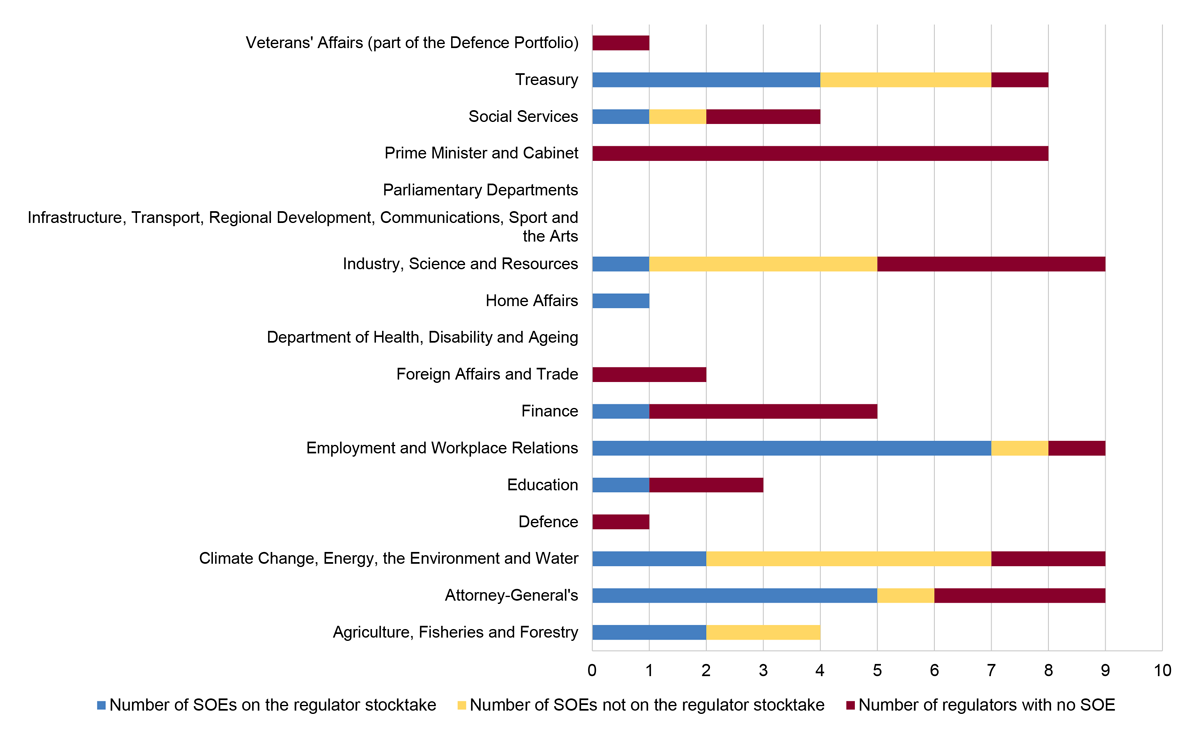
Source: ANAO analysis of SOE and Finance’s regulator stocktake.
Reasons why SOE are not in place (as advised to the ANAO)
Reliance on the minister, portfolio department or both
3.5 A reason provided by some regulators for the absence of an SOE was reliance on the involvement of lead portfolio departments in developing SOE on behalf of portfolio entities or ‘ongoing negotiations’ with the relevant minister. Examples of entity responses are at Table 3.1.
Table 3.1: Entity responses: reliance on the minister, portfolio department or both
|
Portfolio |
Entity |
Entity response |
|
Climate Change, Energy, Environment and Water |
Clean Energy Regulator (CER) |
‘DCCEEW led the engagement with the minister, inviting CER in early May 2024 to be part of their submission of portfolio SOE to the Minister, the CER’s draft Statement of Expectations was provided to DCCEEW on 12 June 2024.’ |
|
Finance |
Australian Electoral Commission (AEC) |
‘Work commenced on drafting the ministerial Statement of Expectations in 2022 however it was not finalised prior to the Government entering caretaker period ahead of the 2022 federal election. The Electoral Policy Unit in the Department of Finance is leading the preparation of the Statement for the AEC. It has engaged with the AEC in recent weeks to re-commence consideration and finalisation of the Statement.’ |
|
Department of Health, Disability and Ageing |
National Health and Medical Research Council (NHMRC) |
‘The Department of Health and Aged Care advises that National Health and Medical Research Council is not a participating regulator for the purposes of the Regulator Performance Guide.’ |
|
Industry, Science and Resources |
IP Australia |
‘IP Australia’s last SOE was signed by Minister Porter in September 2021. An SOI was not able to be sent to the minister before his resignation. An SOE was prepared and sent to Minister Taylor in November 2021, but a signed copy was not received and published before the federal election was called. Upon the change of government and minister, staffing changes within the IP Australia team and lack of clarity from the portfolio on the process to follow has hampered the Agency’s ability to progress the SOE/SOI. The content was revised with policy teams internally to reflect our regulatory obligations, critical operational activities, agency initiatives and observed best practice from other published SOE/SOI, and further supported through an external review of our Strategy and Performance Systems. In April 2024, on advice from DoF as part of the Regulatory Reform IDC, we commenced additional consultation with staff in DoF and DISR to update the SOE/SOI to reflect the priorities of the new government and the requirements of RMG 128. After fulsome consultation, and taking into account other priorities requiring ministerial review and endorsement, we progressed the drafts to the Minister’s Office last Tuesday for their review and feedback.’ In April 2025, the portfolio department advised the ANAO that: ‘While DISR acknowledges there was some delay working collaboratively with IP Australia in relation to the preparation of the SOE, we do not consider this overtly hampered the progress of the SOE given the fairly lengthy timeframes described.’ |
|
Prime Minister and Cabinet |
Workplace Gender Equality Agency (WGEA) |
‘PM&C instigated the draft Statement of Expectations on behalf of the Minister. We received a draft last year that was not progressed and then a new draft this year.’ The ‘new draft’ was provided to WGEA in September 2024. |
|
Treasury |
Australian Taxation Office (ATO) |
Advice from the ATO to the ANAO set out that the Department of the Treasury (Treasury) requested input on a first draft of a refreshed Statement of Expectations, provided by the ATO on 31 May 2023. Further advice from the ATO to the ANAO in February 2025, with supporting evidence provided, was that ‘The ATO has continued to request updates from Treasury on the progress of the Ministerial Statement of Expectations. In January 2024 the Treasury advised the ATO they intended to revisit the draft with the Assistant Treasurer’s and Treasurer’s offices’. |
|
Treasury |
Australian Securities and Investments Commission (ASIC) |
‘Drafts of the SOI/SOE have been exchanged between ASIC and Treasury across the past 12 months … ASIC has no visibility on discussions between Treasury and the minister or his office on the SOE.’ |
Source: ANAO analysis and entity advice to the ANAO between October 2024 and April 2025.
RMG 128 exemptions
3.6 RMG 128 does not apply in two circumstances:
- an entity is only responsible for the setting of policy, standards, the approval of grants or is a tribunal; and
- the regulatory function is only to regulate Commonwealth entities or employees.56
3.7 Finance guidance sets out that officials should consider the information in the guidance and determine the applicability of the principles. Seven regulators contacted by the ANAO identified one of these reasons as the basis for not having put an SOE in place (see Table 3.2).
Table 3.2: Entities contacted who claimed exemptions from having an SOE
|
Entity |
Regulatory function |
Reason |
Rationale for reason provided by the entity |
|
Australian Radiation Protection and Nuclear Safety Agency (ARPANSA) |
Makes decisions relating to the transport of radioactive material |
2 |
Licences are only provided to Commonwealth employees. Private contractors to licence holders are regulated by states and territories. |
|
Department of the Prime Minister and Cabinet |
Can invoke powers for the Defence force over the civilian population in the event of a Defence force ‘call out’ |
2 |
‘Powers can be provided to the ADF to undertake domestic activities which may involve application to the civilian population.’ |
|
Food Standards Australia New Zealand (FSANZ) |
Establishes an effective, transparent and accountable regulatory framework within which the food industry can work efficiently |
1 |
‘the Food Regulation System is a cross-jurisdictional regulatory function … FSANZ’s role in that System is limited, primarily to develop of draft standards for others to approve, amend or reject, and, if approved, for others to administer and enforce.’ |
|
Independent Parliamentary Expenses Authority (IPEA) |
Regulates payment and entitlements to current and former senators and members of Parliament; and persons employed under the Members of Parliament (Staff) Act 1984 |
2 |
Initial advice to the ANAO in October 2024 was that: ‘Having regard to the intent of RMG 128, IPEA has interpreted the status of parliamentarians, for this purpose, to be aligned with that of a Commonwealth employee.’ In March 2025, IPEA advised the ANAO that it was seeking advice from Finance on IPEA’s status in relation to RMG 128. |
|
National Anti-corruption Commission (NACC) |
See paragraph 3.10 |
1 and/or 2 |
See paragraph 3.10 |
|
Parliamentary Workplace Support Service (PWSS) |
Provides human resource advice to ‘create and maintain safe, respectful and inclusive workplaces’ |
2 |
‘PWSS considers that the regulatory functions for which we have responsibility are not subject to the need for a Statement of Expectation (SOE) or a responding Statement of Intent (SOI), as the people impacted by the regulatory functions are overwhelmingly current or former employees of the Commonwealth which under RMG 128 does not require an SOE/SOI’. |
|
Torres Strait Regional Authority (TSRA) |
Able to take such reasonable action as it considers necessary to protect Torres Strait Islander and Aboriginal cultural material and information relating to the Torres Strait area if the material or information is considered sacred or otherwise significant by Torres Strait Islanders or Aboriginal persons |
1 and 2 |
TSRA is only responsible for the setting of policy, standards, the approval of grants and the regulatory function is only to regulate Commonwealth entities or employees. |
Source: ANAO analysis.
3.8 The scope of the RMG 128 Commonwealth entities and employees exemption has been interpreted differently by entities. For example: in relation to its interpretation of RMG 128 that ‘parliamentarians’ are to be aligned with that of a ‘Commonwealth employee’ (see Table 3.2) IPEA also advised the ANAO in October 2024 that ‘IPEA has consulted with the Governance and Resource Management Division of the Department of Finance.’ Finance advised the ANAO in February 2025 that IPEA had sought guidance from Finance in October 2024.
3.9 ARPANSA also advised the ANAO in October 2024 that:
In terms of ARPANSA’s regulatory responsibilities intersecting with private operators, this occurs only with Silex Systems due to their operation being at ANSTO’s Lucas Heights precinct and private entities who seek a permit for the import or export of radioactive material (in line with Prohibited Import/Export Regs). We have tested both of these with the Department of Health (then the Best Practice Regulation Section) and Department of Finance for both the former Regulator Performance Framework and the current RMG 128, however the advice has consistency [sic] been that as these activities are small in nature and the bulk of our regulatory activities relate to the regulation of Commonwealth entities, we were not required to apply them. The last guidance we received was in 2021 when PM&C sent a request on status of SOEs and SOI and stocktake of regulatory functions. During this process PM&C again confirmed that advice.
3.10 In relation to the coverage of RMG 128, in February 2025 the NACC advised the ANAO that it did not consider that it undertakes any regulatory functions for the purposes of the regulator performance framework and that Finance should ‘reconsider the definitions that underpin the identification of Australian Government regulators and regulatory functions, and that further clarity should be provided regarding the scope of the two exceptions (particularly regarding regulation of Commonwealth employees and Tribunals) would be beneficial’. In relation to those particular exemptions, the NACC commented that:
- ‘the NACC’s regulatory function (if there is one) only applies to Commonwealth entities or employees (public officials)’57 and that the NACC ‘is able to investigate alleged corrupt conduct involving Commonwealth public officials. Although third parties may be involved and may also engage in corrupt conduct under the Act, the touchstone is always the involvement of a Commonwealth official’; and
- ‘the NACC, as a Commission, holds the power under the Act to examine witnesses on oath and may therefore be considered a Tribunal.’
Recommendation no.3
3.11 The Department of Finance improve the guidance it provides to entities on the circumstances in which entities with a regulatory function are not expected to have a Statement of Expectations or Statement of Intent in order that accountable authorities can provide appropriate support to ministers.
Department of Finance response: Agreed.
3.12 The ANAO audit findings and recommendations will inform the program of work referenced in response to recommendation 1, which will include clarification on the definitions of a regulator and regulatory functions. This work will include considering whether Statements of Expectations and Statements of Intent are the best way to achieve the policy intent in all circumstances.
Other entities that agreed or supported the recommendation: Australian National University, Department of Defence, Department of Industry, Science and Resources, Department of the Treasury, National Anti-Corruption Commission, Sydney Harbour Federation Trust and Wine Australia.
Other entities that noted or acknowledged the recommendation: Australian Digital Health Agency, Australian Radiation Protection and Nuclear Safety Agency, Department of Agriculture, Fisheries and Forestry, Department of Education, Department of Employment and Workplace Relations, Department of Health, Disability and Ageing, Department of Veterans’ Affairs, IP Australia, Office of the Fair Work Ombudsman and Professional Services Review.
Currency of SOE
3.13 The guidance in RMG 128 sets out that ‘SOE should be refreshed with every change in minister, change in regulator leadership, change in Commonwealth policy or every two years’.58 Of the regulatory SOE examined by the ANAO, nine SOE (16 per cent) were more than two years old as of December 2024. The oldest published SOE was the Tax Practitioners Board’s (TPB), more than 10 years old as of December 2024. TPB advised the ANAO in October 2024 that ‘we anticipate that an updated Statement of Expectations may issue to the TPB imminently.’
3.14 There were 11 SOE (19 per cent) that had not been updated as a result of a change in minister as of December 2024. This included four SOE that were not updated following the change of Government at the May 2022 Federal Election. For example:
- the ASIC published SOE is dated August 2021. ASIC advised the ANAO in October 2024 that ’drafts of the SOI/SOE have been exchanged between ASIC and Treasury across the past 12 months (one series of exchanges in October/November 2023, and another in June/July 2024). ASIC has no visibility on discussions between Treasury and the minister or his office on the SOE.’
- the Reserve Bank of Australia advised the ANAO in October 2024 in relation to the Payment Systems (Regulation) Act 1998 and the Reserve Bank Act 1959 (in so far as it covers the functions of the Payments System Board) that it was planning but had not yet commenced an update of an SOE (and SOI) that had been issued in 2018 (see more information in Table 2.2).
3.15 In addition to those 11 SOE, there were 15 SOE where the minister had been appointed in June 2022 with a delay of 12 months or longer before the SOE was issued.
3.16 As at December 2024, there were eight SOE (14 per cent) that had not been updated following a change in regulator leadership. Three related to changes of regulatory leadership in 2024: Australian Pesticides and Veterinary Medicines Authority (APVMA)59 (new Chair of the Board appointed in July 2024), NDIS Quality and Safeguards Commission (new Commissioner commenced in October 2024) and Sport Integrity Australia (Acting Chief Executive Officer appointed from August 2024). More significant delays were evident with five regulators, for example: ASIC (not updated since August 2021), Department of Health, Disability and Ageing (DHDA) (18 months since retirement of Secretary), National Offshore Petroleum Safety and Environmental Management Authority (22 months since appointment of new Chief Executive Officer), Reserve Bank of Australia (15 months since appointment of new Governor) and Tax Practitioners Board (not updated since 2014).
3.17 Advice from the Department of Agriculture, Fisheries and Forestry (DAFF) addressed the requirement to refresh regulator SOE following a change in minister and regulator leadership.
During the period June 2022-July 2024 … and noting various machinery-of-government changes following the election and then the appointment of Secretary Fennessy in place of Secretary Metcalfe on 18 September 2023, Minister Watt signed two SOE … The process has recommenced following the appointment of Minister Collins on 29 July 2024.60
Coverage of SOE
3.18 There is no requirement within RMG 128 for entities to list all Acts under which they are conferred regulatory functions. RMG 128 does set out that:
Some regulatory functions within a department can be quite small, diffuse or have low visibility. Departments may consider covering these through a more generic Statement of Expectations from the minister to the secretary that outlines the minister’s broad expectations for the conduct of regulatory functions undertaken within the department. It may make sense to include this as part of a Statement of Expectations to the secretary about broader functions of the department. Again the expectations articulated by the minister can then be communicated by the secretary to senior leaders in the regulatory functions. A responding Statement of Intent could then be provided by the secretary to the minister, setting out how the department will exercise its general regulatory functions to meet the minister’s expectations (and can be included in the department’s corporate plan and annual report).61
3.19 There were at least 14 SOE that did not address the full range of regulatory functions. For those 14 SOE, either the SOE listed some regulatory functions or Acts (but did not cover all Acts) or functions were outlined in broad or generic terms. For example, the Department of Infrastructure, Transport, Regional Development, Communications, Sport and the Arts had regulatory responsibilities in relation to three aspects of Federal airports, with incomplete coverage by its SOE and SOI, as set out in Table 3.3.
Table 3.3: Regulation of federal airports
|
Legislation |
Entities regulated |
Coverage in SOE and SOI |
|
Adelaide Airport Curfew Act 2000 and Sydney Airport Curfew Act 1995 |
Aircraft operators |
Not addressed in SOE and SOI. Entity advice of October 2024 suggested a general reference to regulating in accordance with ‘all applicable laws’ provided coverage. |
|
Sydney Airport Demand Management Act 1997 |
Aircraft operators |
Not addressed in SOE and SOI. October 2024 advice from entity was that this responsibility will be included in the SOE and SOI once a legislative review process is completed. |
|
Airports Act 1996 |
Airport operators |
Addressed in SOE and SOI |
Source: ANAO analysis and Infrastructure advice.
3.20 Eight entities identified functions being small, diffuse or having low visibility as a reason for not having an SOE that addressed the regulatory function. These were: Attorney-General’s Department (AGD), ARPANSA, Department of Climate Change, Energy, the Environment and Water, Department of Education, DHDA, Department of Industry, Science and Resources, Department of Veterans’ Affairs (DVA) and National Indigenous Australians Agency.
3.21 For example, the AGD’s 2023 SOE addresses seven of the department’s regulatory responsibilities. In relation to a further five pieces of legislation62 involving a regulatory function the department advised the ANAO in October 2024 that these were not referenced in the SOE and SOI because:
these functions are small, low visibility and limited in scope. In accordance with RMG 128 guidance, we’d consider these functions to be covered in the SOE under the broader sections The Government’s policy priorities and objectives that notes the called out regulatory functions to be core functions, but goes on to set expectations for regulation more broadly. Our SOI responds to this.
3.22 In relation to DVA, ANAO analysis of DVA functions indicated a regulatory function under the Protection of Word “Anzac” Act 1920. The department advised the ANAO in October 2024 that ‘The former Minister for Veterans’ Affairs and Assistant Minister to the Prime Minister formalised an agreement through Department of the Prime Minister and Cabinet, that the Minister was not expected to prepare a Statement of Expectations or Statements of Intent as the Minister for Veterans’ Affairs does not have responsibility for key regulatory agencies or functions.’ This was the only instance of an entity providing evidence that it has obtained Ministerial agreement to not having an SOE (noting that the department has not taken steps to ascertain if its current Minister, and the current minister responsible for oversight of the regulator performance framework, support this situation continuing).
3.23 Machinery of government changes can see changes in entity responsibility for regulatory functions. At the time of the audit, the Machinery of Government Changes Guide63 published jointly by the Australian Public Service Commission and Finance includes no guidance relevant to SOE and SOI. In February 2025, Finance advised the ANAO that:
Finance undertakes a number of activities in relation to the accuracy and completeness of the regulatory stocktake which provides visibility of the spread of regulatory functions across the Australian government and supports greater transparency on SOE/I, including:
- proposing RMG 128: Regulatory performance, and Guidance Note: Statements of Expectation & Intent information be included in the Machinery of Government Changes Guide
- providing information about the Government’s regulatory reform agenda including SOE/I to newly appointed accountable authorities and heads of regulators.
Do the Statements of Expectations identify the government’s expectations?
Most of the Statements of Expectations have content that identifies the government’s expectations. The content of the documents is largely consistent with guidance from the Department of Finance. The main areas where the guidance is not being met comprises: SOE not outlining how the responsible minister will engage with the regulator; SOE not requesting the regulator respond with a Statement of Intent; and SOE not requesting regulators incorporate the statements into their corporate plan and annual report.
3.24 RMG 128 ‘provides factors for consideration … to support consistency across portfolios’ in the content of an SOE.64 There are seven factors relevant to SOE outlined in RMG 128 which are summarised in Figure 3.2 below. The ANAO assessed the alignment of 55 SOE that were in place as of December 2024 against the factors.65
Figure 3.2: Content of Statements of Expectations
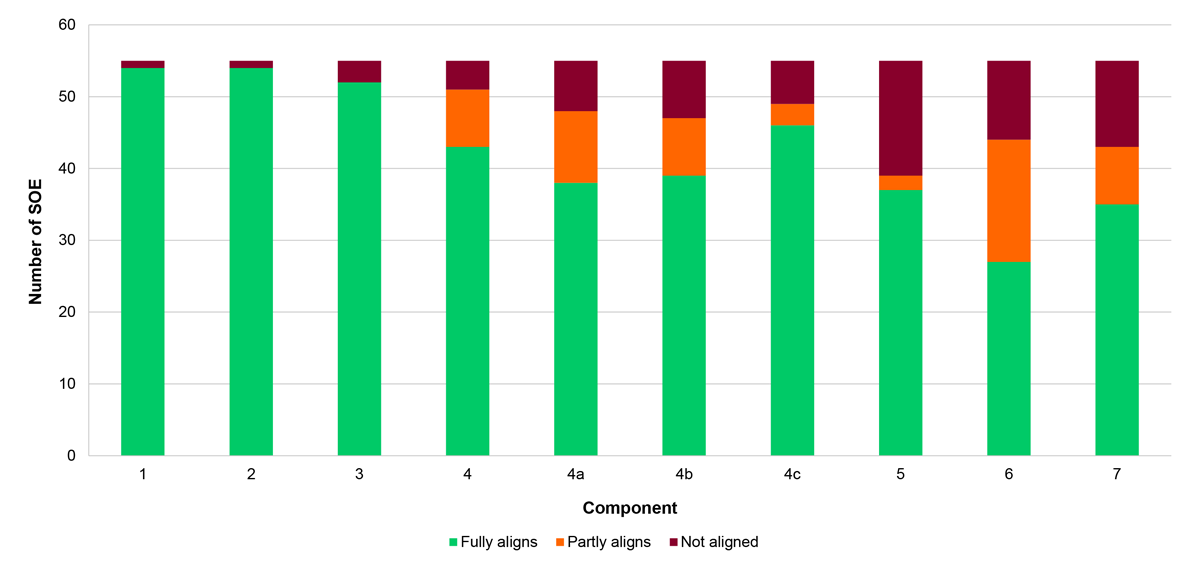
Note: RMG 128 states that an SOE should:
Component 1: consider the economic and social environment in which the regulator operates, and the Government’s policy objectives and priorities, including the regulatory reform agenda
Component 2: provide strategic direction (to the extent allowed by legislation) on the conduct of the regulator, its role, and how the regulator should engage with business, the community, other regulators and policy departments including the states and territories
Component 3: reference any major projects, reforms, and key developments (for example, cost recovery, implementation of reviews) the regulator will be progressing over the next 2 years and the Minister’s expectations for these, including considering whether the Statement of Expectations needs to be delayed until a review is finalised
Component 4: expect regulators to act in accordance with best practice, embedding the Government’s principles of regulator best practice, striving for continuous improvement against these principles and considering international best practice, as relevant
Component 4a: Best Practice Principle 1: Continuous improvement and building trust
Component 4b: Best Practice Principle 2: Risk based and data driven
Component 4c: Best Practice Principle 3: Collaboration and engagement
Component 5: propose how the responsible minister will engage with the regulator, including undertakings on how the minister will help provide an enabling environment for the regulator to consistently implement best practice
Component 6: request the regulator responds via a Regulator Statement of Intent, outlining how it will deliver on the minister’s expectations and both the Statement of Expectation and Statement of Intent be made publicly available on the regulator’s website
Component 7: request that the Statement of Expectation be incorporated into PGPA Act processes (that is, corporate plan and annual report).
Source: ANAO analysis of SOE.
3.25 Figure 3.2 illustrates that a high proportion of SOE addressed the first three factors for consideration (98 per cent of SOE addressed the first and second factor and 95 per cent of SOE addressed the third factor). In relation to the exceptions:
- Services Australia’s SOE did not consider the economic and social environment in which the regulator operates or provide strategic direction on the conduct of the regulator; and
- the Offshore Infrastructure Registrar, the Offshore Infrastructure Regulator and the Professional Services Review SOE did not address any major projects, reforms or key developments the regulator would be progressing over the next two years.
3.26 Entities SOE’s were less likely to align with the final three components outlined in RMG 128:
- 29 per cent of SOE did not set out how the responsible minister would provide an enabling environment for the regulator to consistently implement best practice.
- 20 per cent of SOE did not request the regulator respond via SOI and make both documents publicly available on the regulator website. Despite not always addressing this requirement, 86 per cent of SOE examined against best practice principles were published on the departmental or regulator website.
- 22 per cent of SOE examined did not request the SOE be incorporated into PGPA Act processes.
3.27 Figure 3.3 sets out that there were 13 SOE (23 per cent of SOE examined) which fully addressed all components set out in RMG 128 guidance. The 13 SOE were those of: the Aged Care Quality and Safety Commission, Australian Criminal Intelligence Commission, Australian Financial Security Authority, Australian Human Rights Commission, Comcare, Safety, Rehabilitation and Compensation Commission, DAFF, Inspector-General of Water Compliance, Director of National Parks, Fair Work Commission, Murray–Darling Basin Authority, Seafarers Safety, Rehabilitation and Compensation Authority and Wine Australia. There were seven SOE that fully addressed less than five components set out in RMG 128. These were: Australian Prudential Regulation Authority, National Capital Authority, Sydney Harbour Federation Trust, NDIS Quality and Safeguards Commission, Australian Communications and Media Authority, Professional Services Review and Services Australia.
Figure 3.3: SOE that fully addressed all components of the RMG 128 guidance
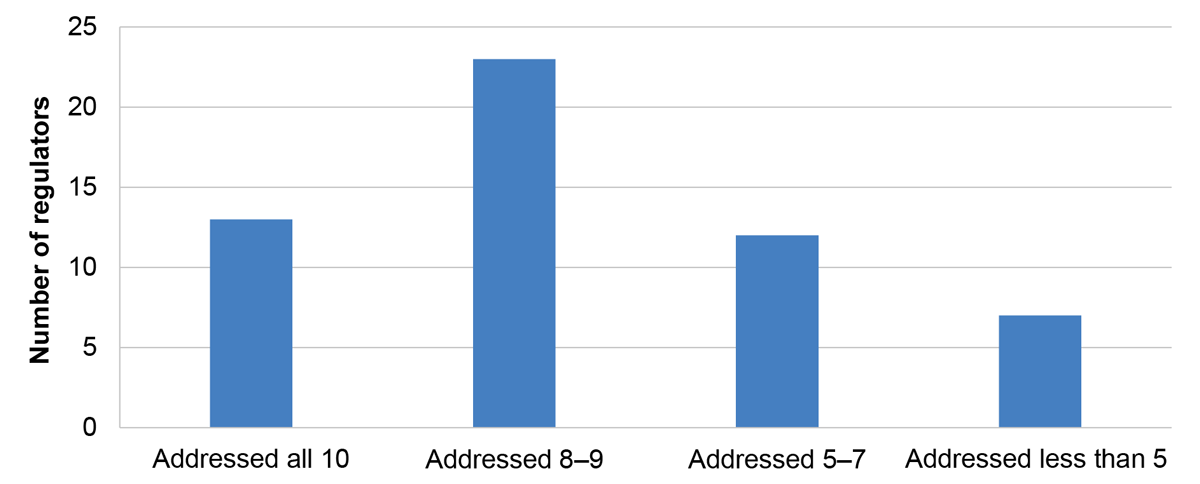
Source: ANAO analysis of Statements of Expectations.
Which regulators have a current Statement of Intent?
As of December 2024, there were 49 regulatory Statements of Intent in place. Eight of these had been in place for more than two years.
3.28 Accountable authorities of entities respond to an SOE with an SOI, which ‘outlines how the regulator intends to meet those expectations including how it will demonstrate progress’. As with SOE, the SOI should be made publicly available.
3.29 There were 49 SOI in place as of December 2024. The regulator stocktake indicates that there were 33 SOI in place as of December 2024 (a difference of 16).66 There were eight SOI that had been in place for more than two years as of December 2024. Four of these were issued prior to 2022 and four were issued in 2022.
3.30 Three entities did not have an SOI in place responding to the latest SOE. For all entities, these were in circumstances where ministers had provided updated SOE to Commonwealth entities in 2024: May 2024 SOE for the Australian Fisheries Management Authority (AFMA), October 2024 for ARPANSA and December 2024 for Australian Communications and Media Authority.67 Regarding the seven-month delay, AFMA advised the ANAO in February 2025 that:
An SOE was issued by Minister Watt to me in May 2024 … We commenced preparation of an SOI, and this was reviewed by the AFMA Commission at its meeting in July 2024 … We were in the final stages of clearing the SOI with DAFF when Minister Watt moved to a different portfolio, and Minister Collins assumed the AFF portfolio. We are awaiting advice from DAFF and Minister Collins on her preferred approach to the SOE.
3.31 Finance guidance does not specify the timeframe or when corresponding SOI should be issued following receipt of an SOE. ANAO analysis of SOI indicates that:
- 37 SOI were issued by entities within three months of receipt of an SOE;
- six SOI were issued by entities between three and six months following receipt of an SOE; and
- one SOI was issued more than six months following receipt of an SOE (Australian Energy Regulator68).69
Which regulators have a current Statement of Intent that identifies how the government’s expectations will be delivered?
The Regulator Statements of Intent that are in place identify how the government’s expectations will be delivered, consistent with guidance from the Department of Finance.
3.32 The guidance to RMG 128 sets out that SOI should have four components in responding to the Statement of Expectations.70 The ANAO assessed the 46 SOI that were in place as of December 2024 (and had been issued after April 202171) against the four components. As illustrated by Figure 3.4, regulators are developing SOI that are consistent with the RMG 128 guidance. The one exception of note relates to the guidance that the SOI should outline how the regulator intends to engage with policy departments and the minister at a high level, note how progress against meeting the minister’s expectations will be measured and reported on by the regulator.
Figure 3.4: Content of Statements of Intent
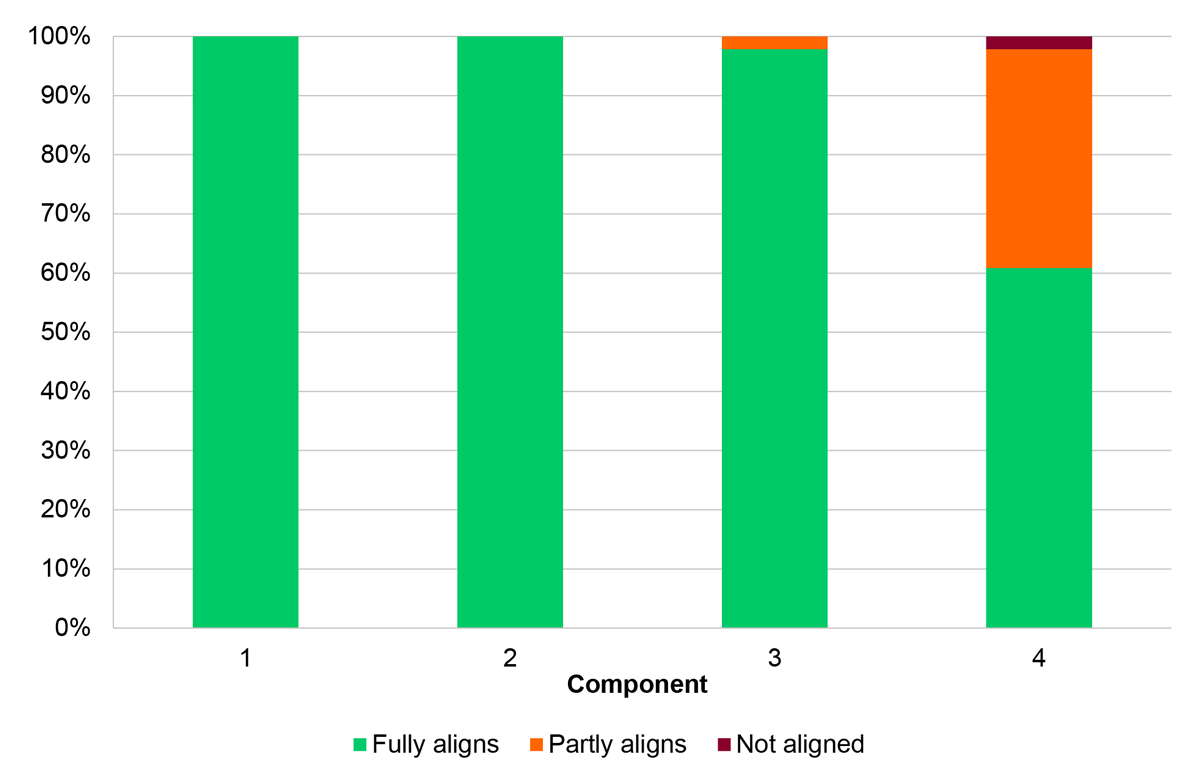
Note: RMG 128 states that an SOI should:
Component 1: In responding to the Statement of Expectations, provide regulator perspective on its purpose, strategic direction and delivery of statutory objectives.
Component 2: Articulate how the regulator intends to deliver against the minister’s expectations set out in the Statement of Expectations in practical terms. This can include describing internal initiatives or structures, changes in systems or governance, efforts to build staff capability and to foster an organisational culture that supports regulator best practice.
Component 3: Outline how the regulator intends to engage with regulated entities, other regulators and other stakeholders.
Component 4: Outline how the regulator intends to engage with policy departments and the minister at a high level, note how progress against meeting the minister’s expectations will be measured and reported on by the regulator.
Source: ANAO analysis of Statements of Intent.
3.33 As illustrated by Figure 3.5. ANAO analysis of regulator SOI indicated there were 27 SOI (55 per cent of SOI examined) which addressed all four components and 19 SOI that fully addressed three of the four components. The 27 comprised the SOI of: Aged Care Quality and Safety Commission, Australian Communications and Media Authority, eSafety Commissioner, Australian Fisheries Management Authority, Australian Maritime Safety Authority, Civil Aviation Safety Authority, Clean Energy Regulator, Coal Mining Industry (Long Service Leave Funding) Corporation, Department of Climate Change, Energy, the Environment and Water (two SOI), Australian Energy Regulator, Department of Education, Department of Health, Disability and Ageing, Department of Home Affairs, Offshore Infrastructure Registrar, Department of Infrastructure, Transport, Regional Development, Communications, Sport and the Arts, National Capital Authority, National Health and Medical Research Council, National Offshore Petroleum Safety and Environmental Management Authority, NDIS Quality and Safeguards Commission, Office of the Australian Information Commissioner, Office of the Fair Work Ombudsman, Professional Services Review, Services Australia, Sport Integrity Australia, Sydney Harbour Federation Trust and Wine Australia.
Figure 3.5: SOI that fully address all components of the RMG 128 guidance
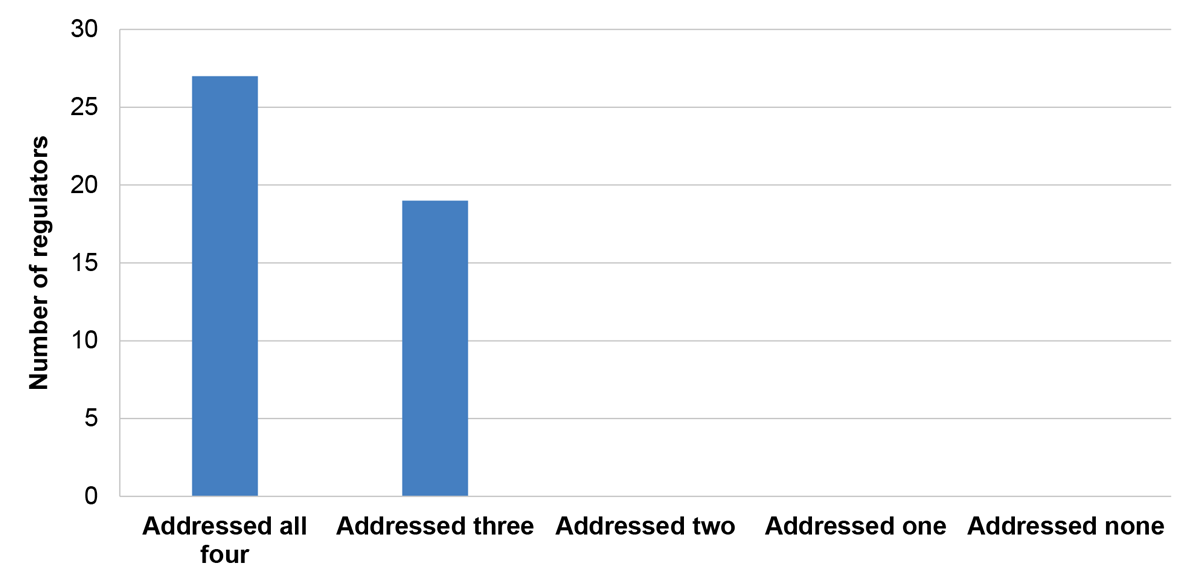
Source: ANAO analysis of Statements of Intent.
Recommendation no.4
3.34 The Department of Finance improve the extent to which regulatory functions are covered by Statements of Expectations and Statements of Intent by engaging with all entities that have regulatory functions by:
- where Statements are not in place, working with the entity (and the portfolio department, as appropriate) to develop and publish Statements that accord with the content requirements of Resource Management Guide 128 and cover all regulatory functions of each regulator;
- monitoring the currency of existing Statements, and engage with entities to draw attention to the need for any updates;
- identifying all regulatory functions in the regulator stocktake, including in circumstances where Statements are not in place to cover regulatory functions; and
- identifying opportunities to maximise the value that regulators gain from having Statements of Expectations and Statements of Intent.
Department of Finance response: Agreed in principle.
3.35 Finance supports Ministers, policy makers and regulators to understand the value and opportunity of developing Statements of Expectations and Statements of Intent.
3.36 Ultimately, ministers and accountable authorities are responsible for identifying and settling the regulatory functions within their responsibilities, and whether a Statement of Expectations is issued to a regulator is a matter for the relevant minister. Relevant accountable authorities and ministers remain responsible for maintaining the currency of any Statements of Expectations they put in place.
3.37 Finance guides developers of Statements of Expectations and Statements of Intent to address the posture of the regulator including how they will maintain their independence and work with the relevant Minister and department. Statements of Expectations and Statements of Intent are part of the suite of best practice regulatory governance tools a regulator can use to transparently communicate. Statements of Expectations and Statements of Intent are part of an ongoing productive and close partnership between regulators, departments and Ministers.
3.38 Finance will continue to explore opportunities to maximise the value of Statements of Expectations and Statements of Intent including through broad consultation with the Regulator Leadership Cohort, Regulatory Reform Inter-Departmental Committee, regulated entities and the community. Finance invites the ANAO to present their audit findings to the Regulator Leadership Cohort and Regulatory Reform Inter-Departmental Committee to support this objective.
Other entities that agreed or supported the recommendation: Australian National University, Department of Defence, Department of the Treasury, Sydney Harbour Federation Trust and Wine Australia.
Other entities that noted or acknowledged the recommendation: Australian Digital Health Agency, Australian Radiation Protection and Nuclear Safety Agency, Department of Agriculture, Fisheries and Forestry, Department of Education, Department of Employment and Workplace Relations, Department of Health, Disability and Ageing, Department of Industry, Science and Resources, Department of Veterans’ Affairs, IP Australia, Office of the Fair Work Ombudsman and Professional Services Review.
Appendices
Appendix 1 Entity responses
Department of Finance
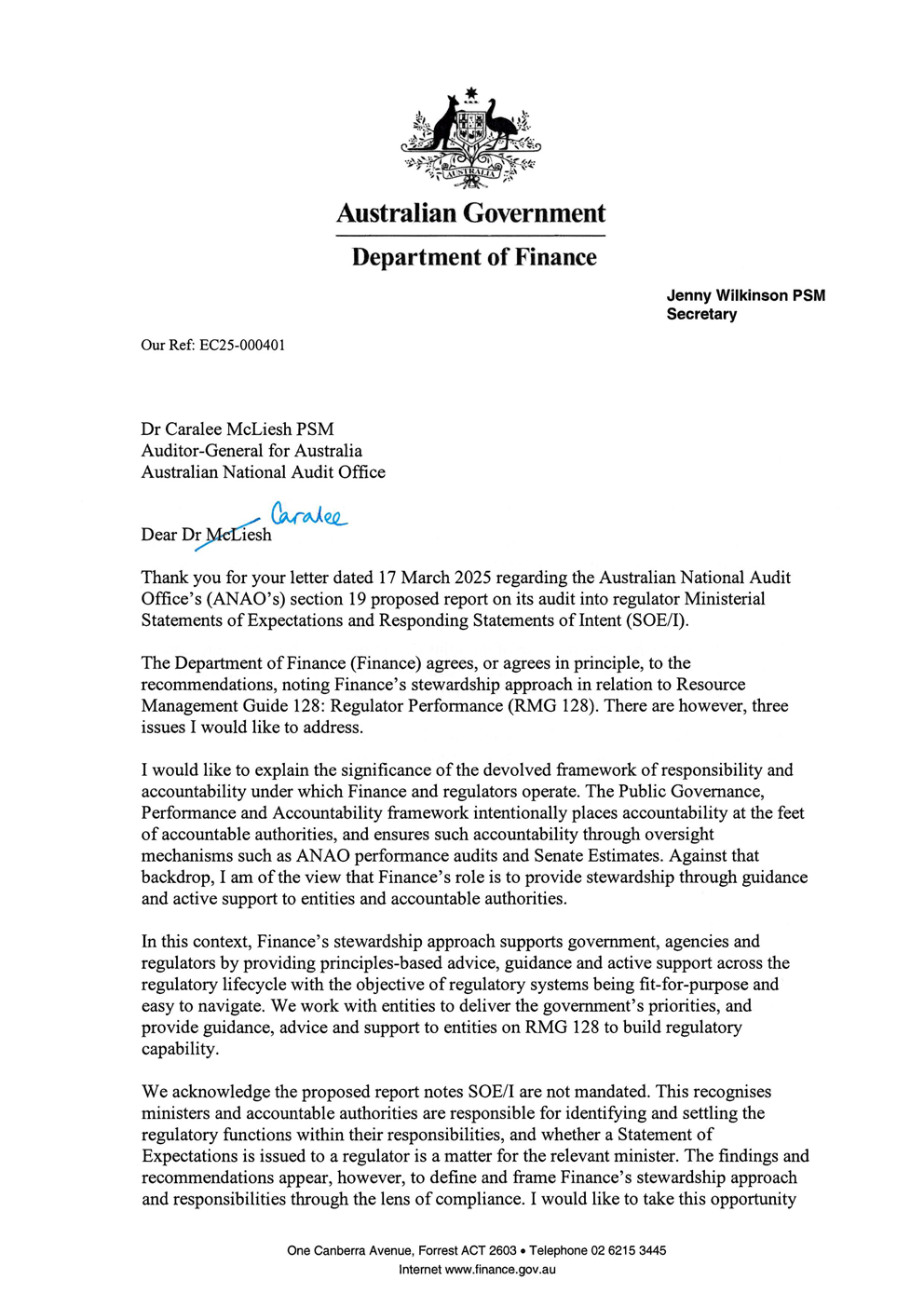
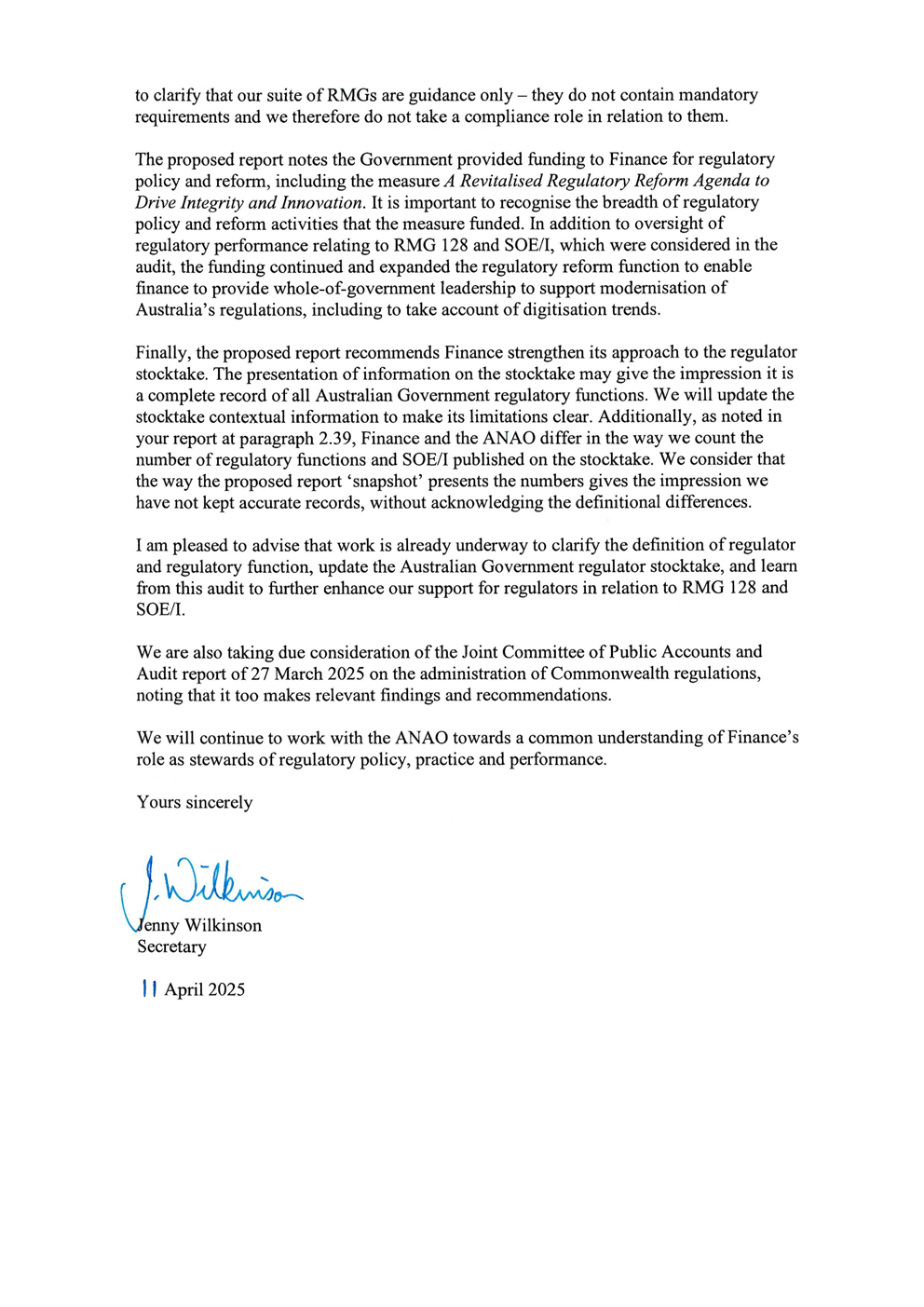
Aged Care Quality and Safety Commission
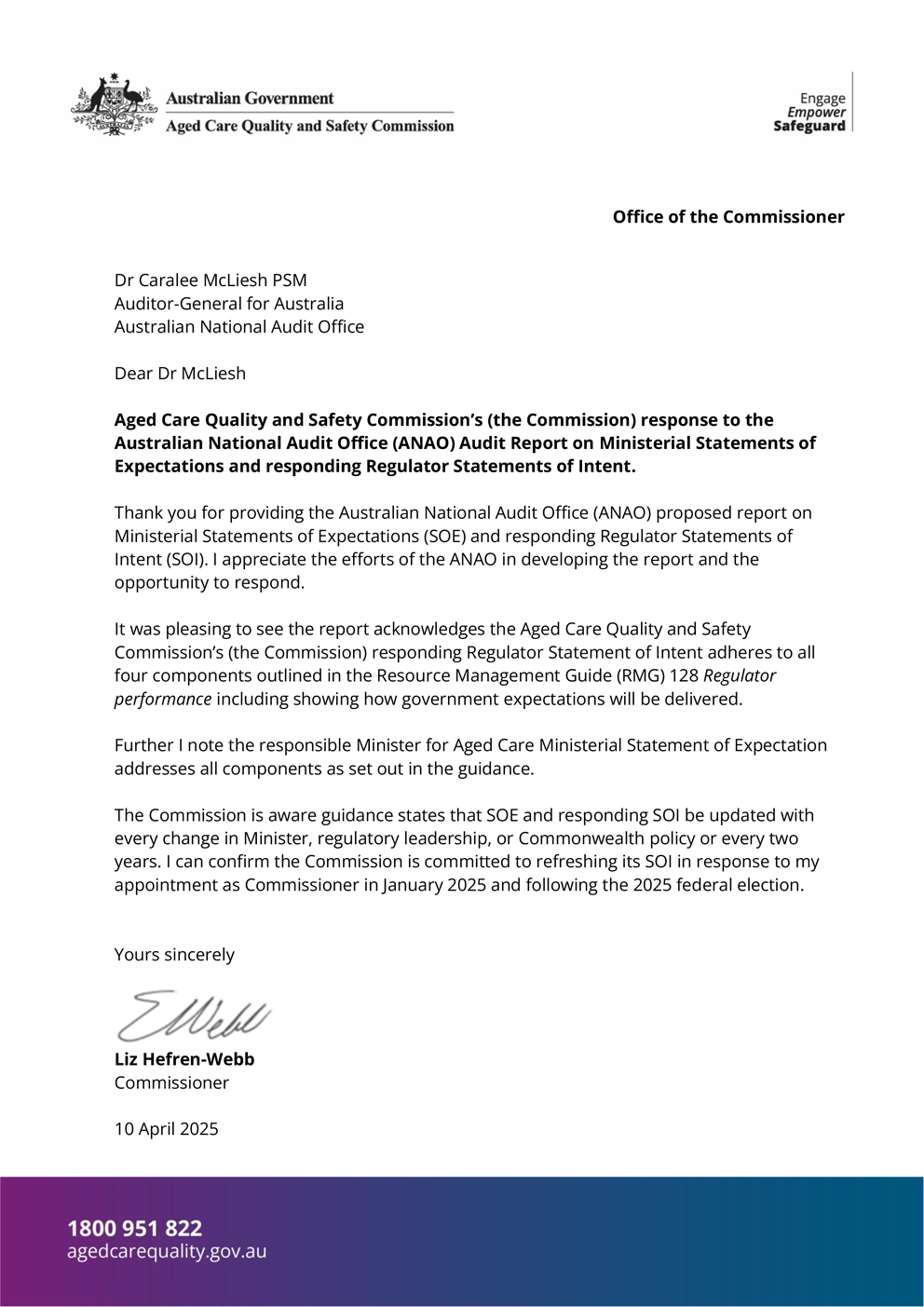
Attorney-General’s Department
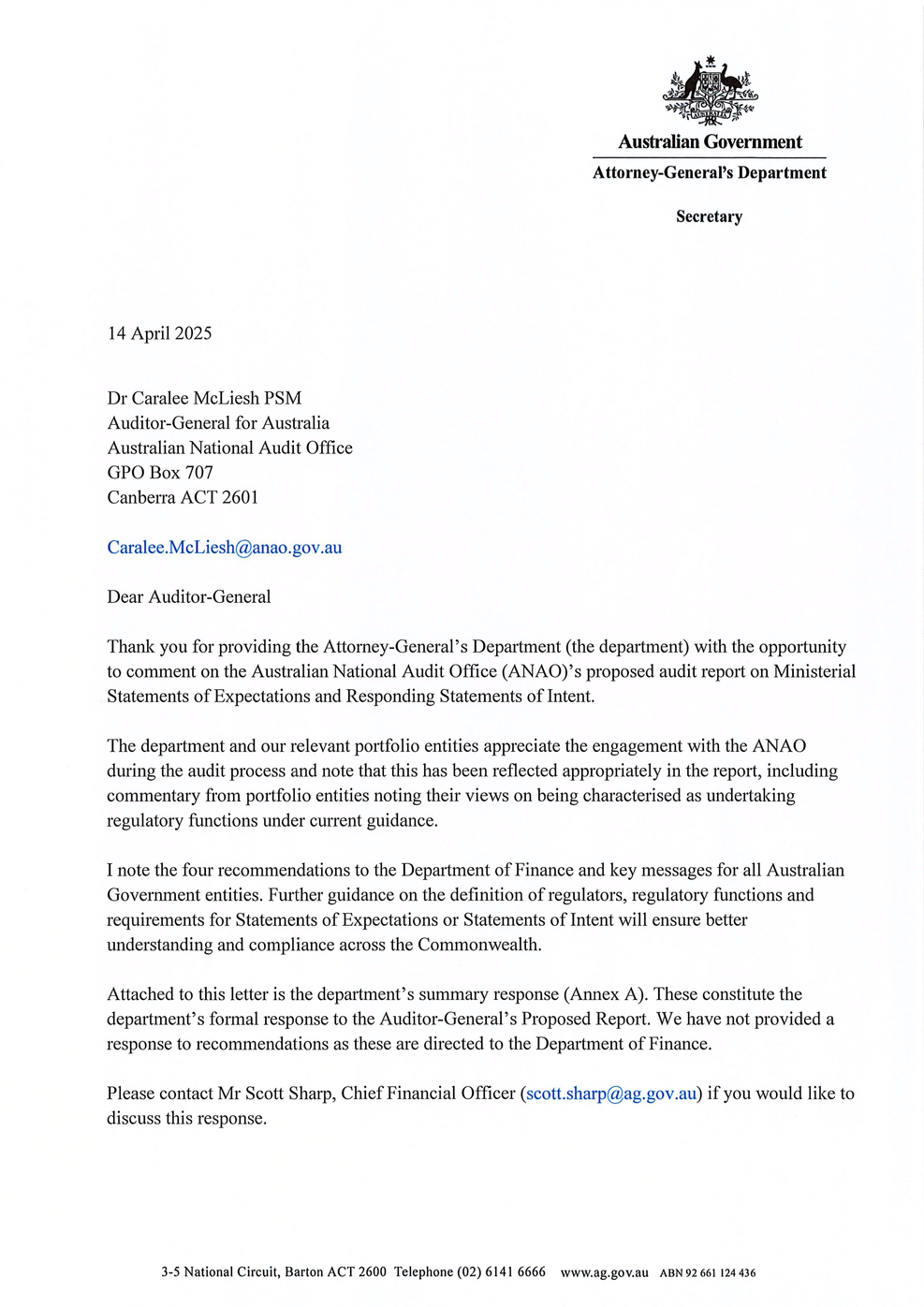
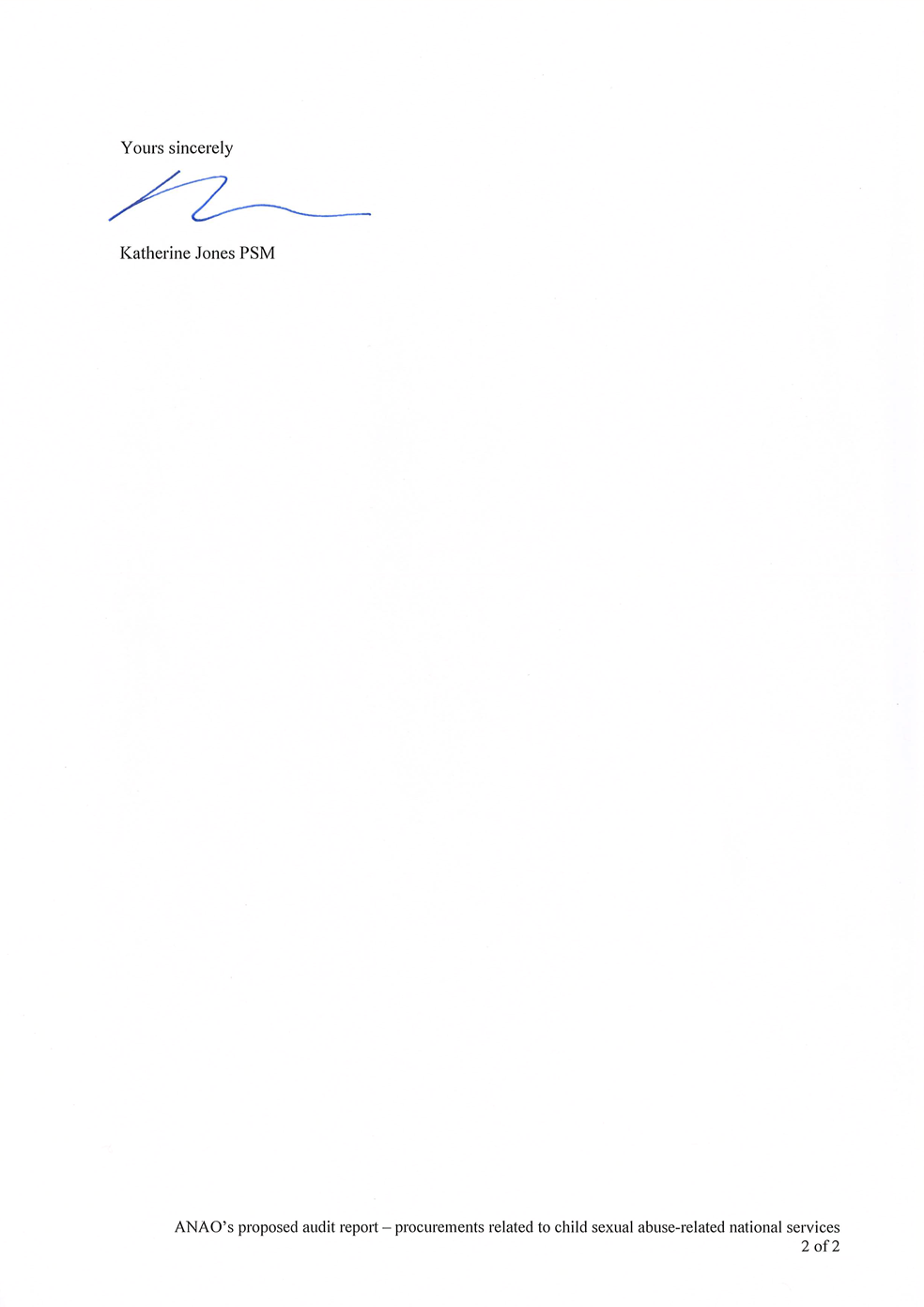
Australian Digital Health Agency
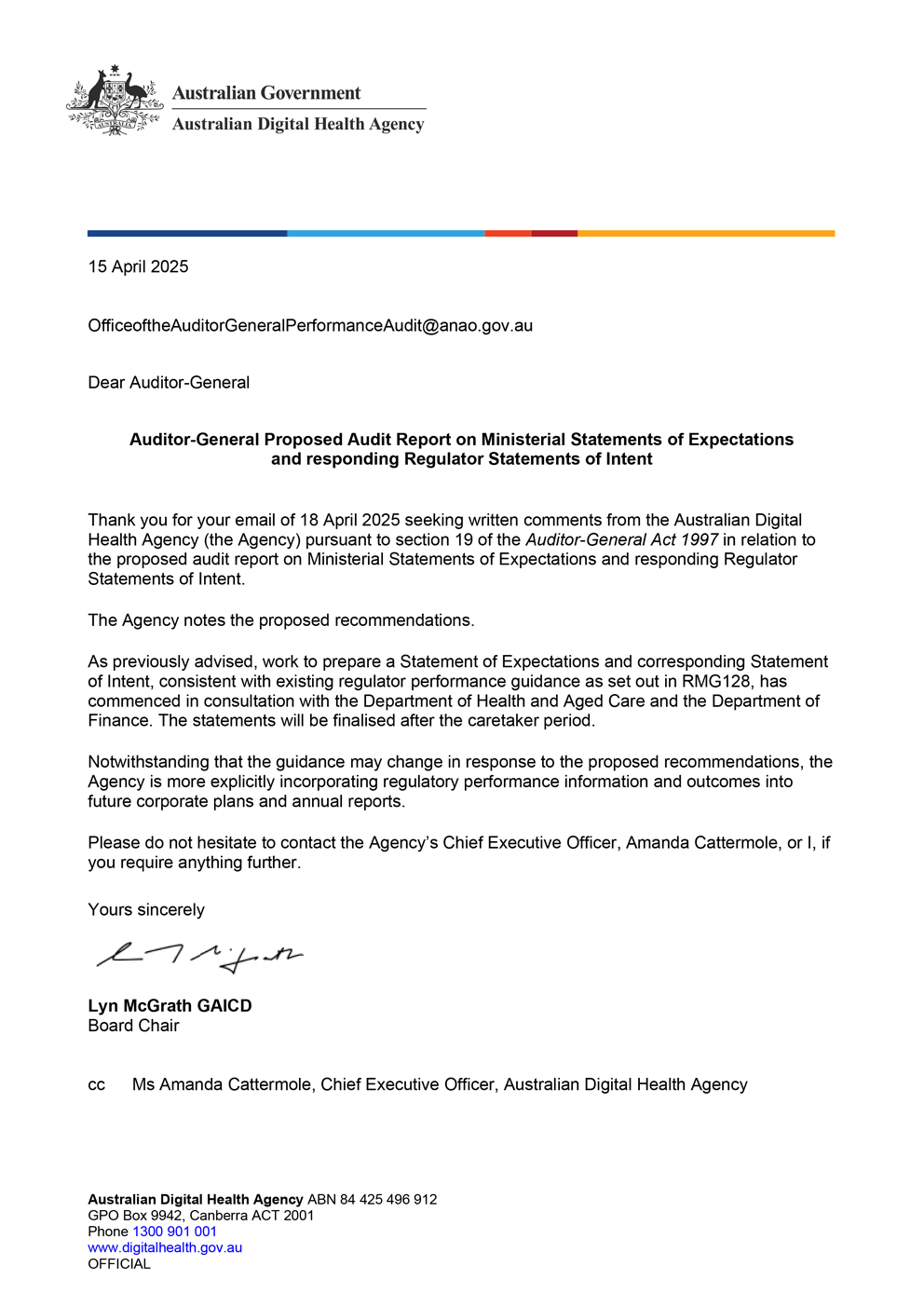
Australian Electoral Commission
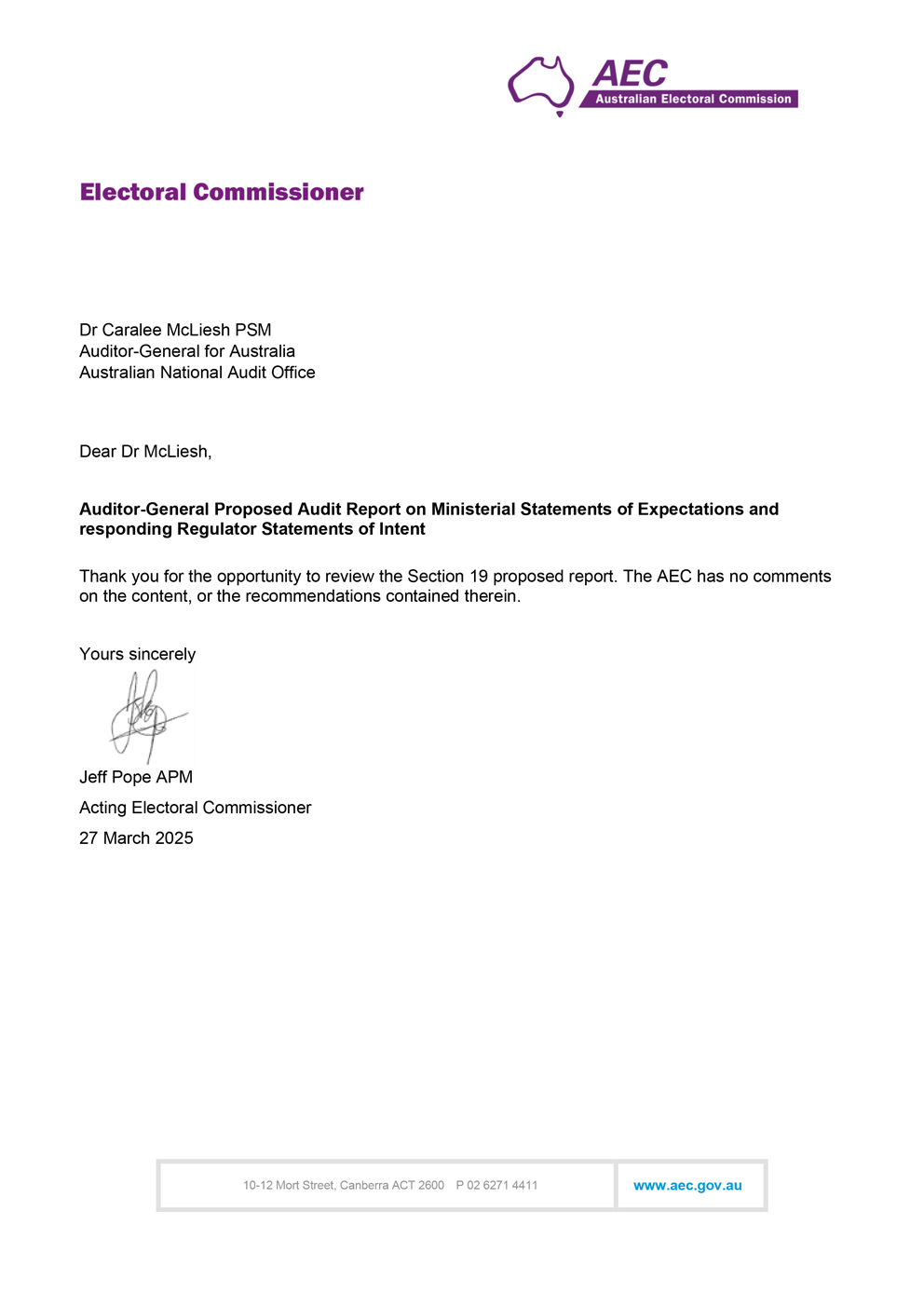
Australian Energy Regulator
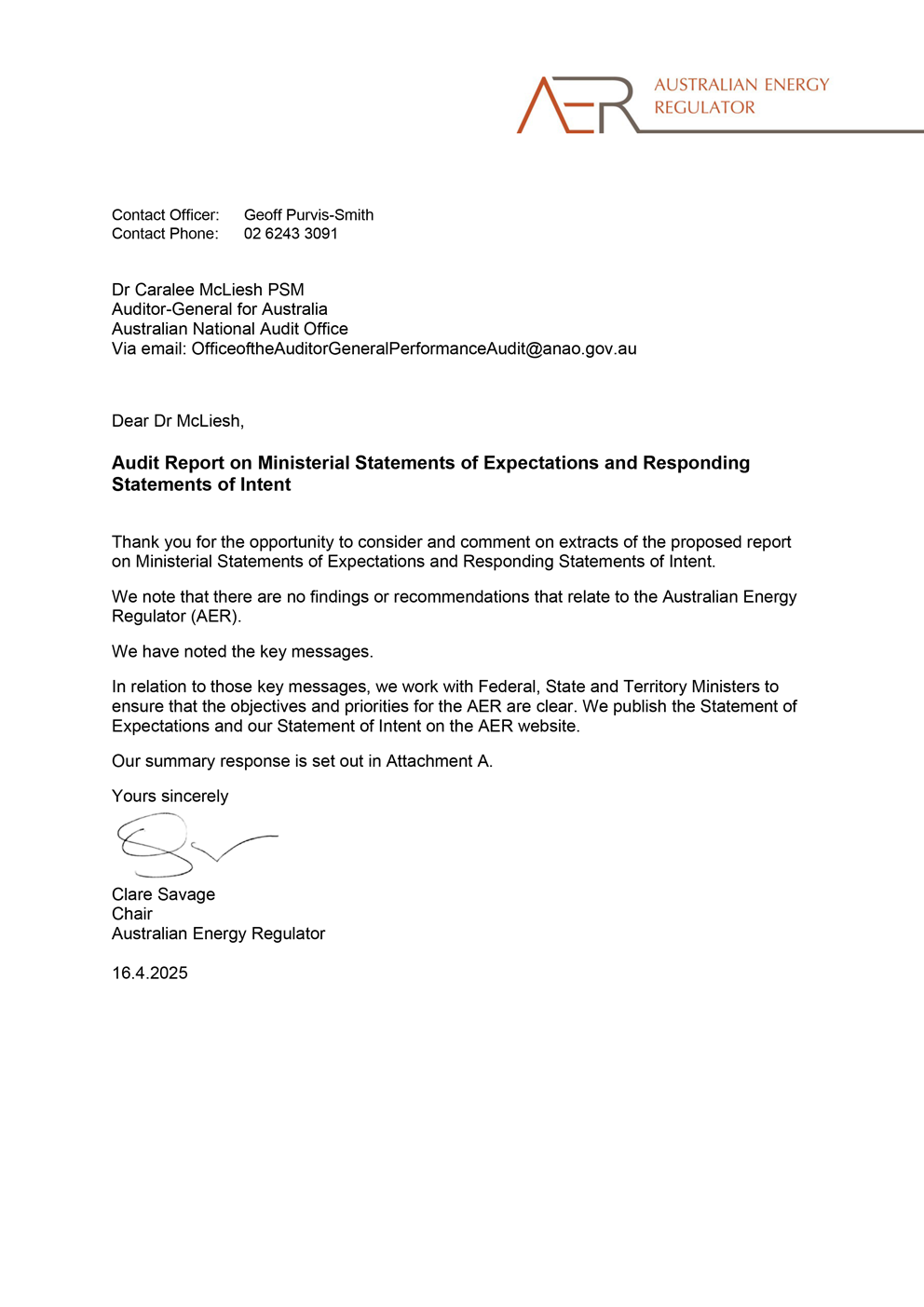
Australian Federal Police
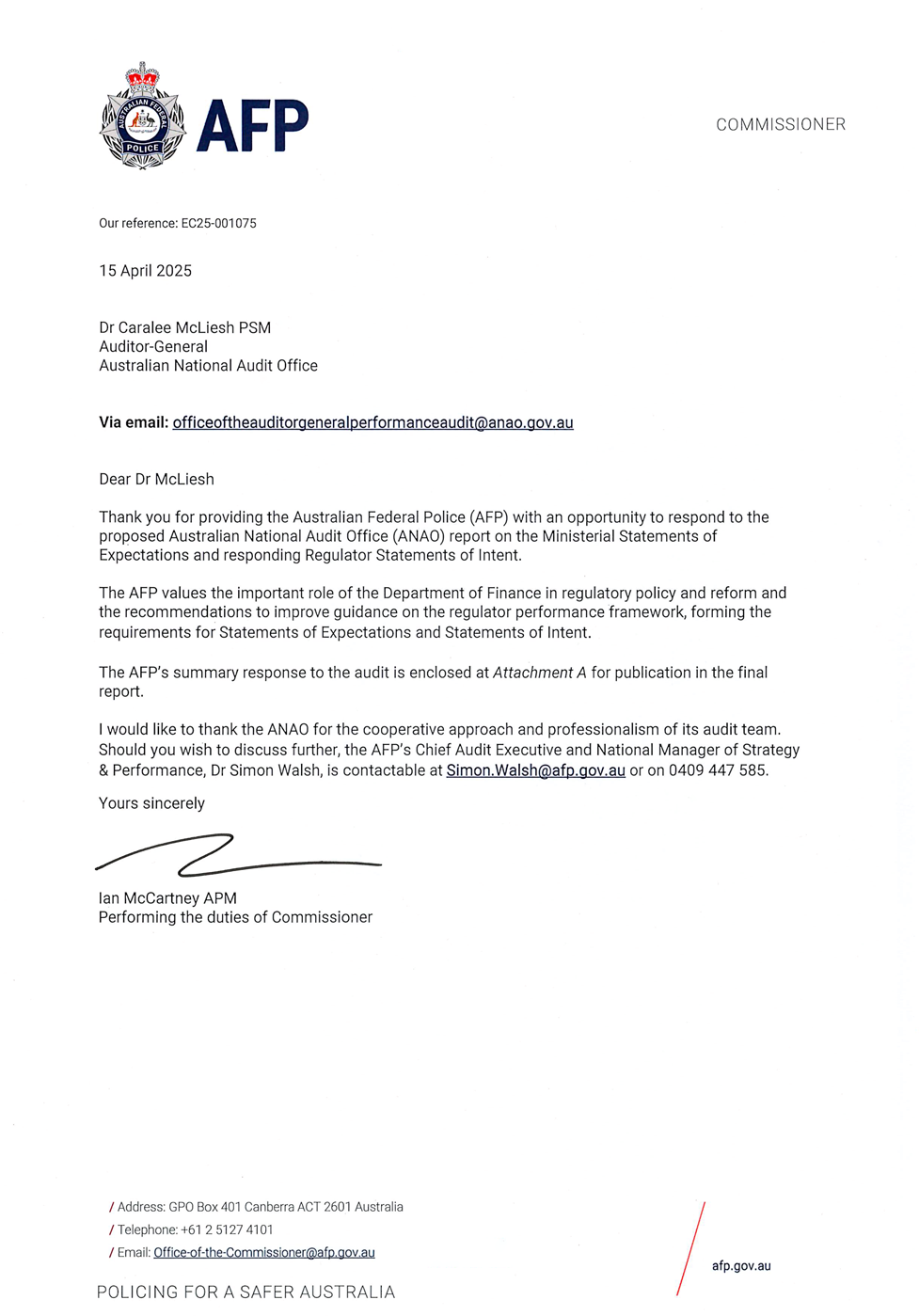
Australian Financial Security Authority
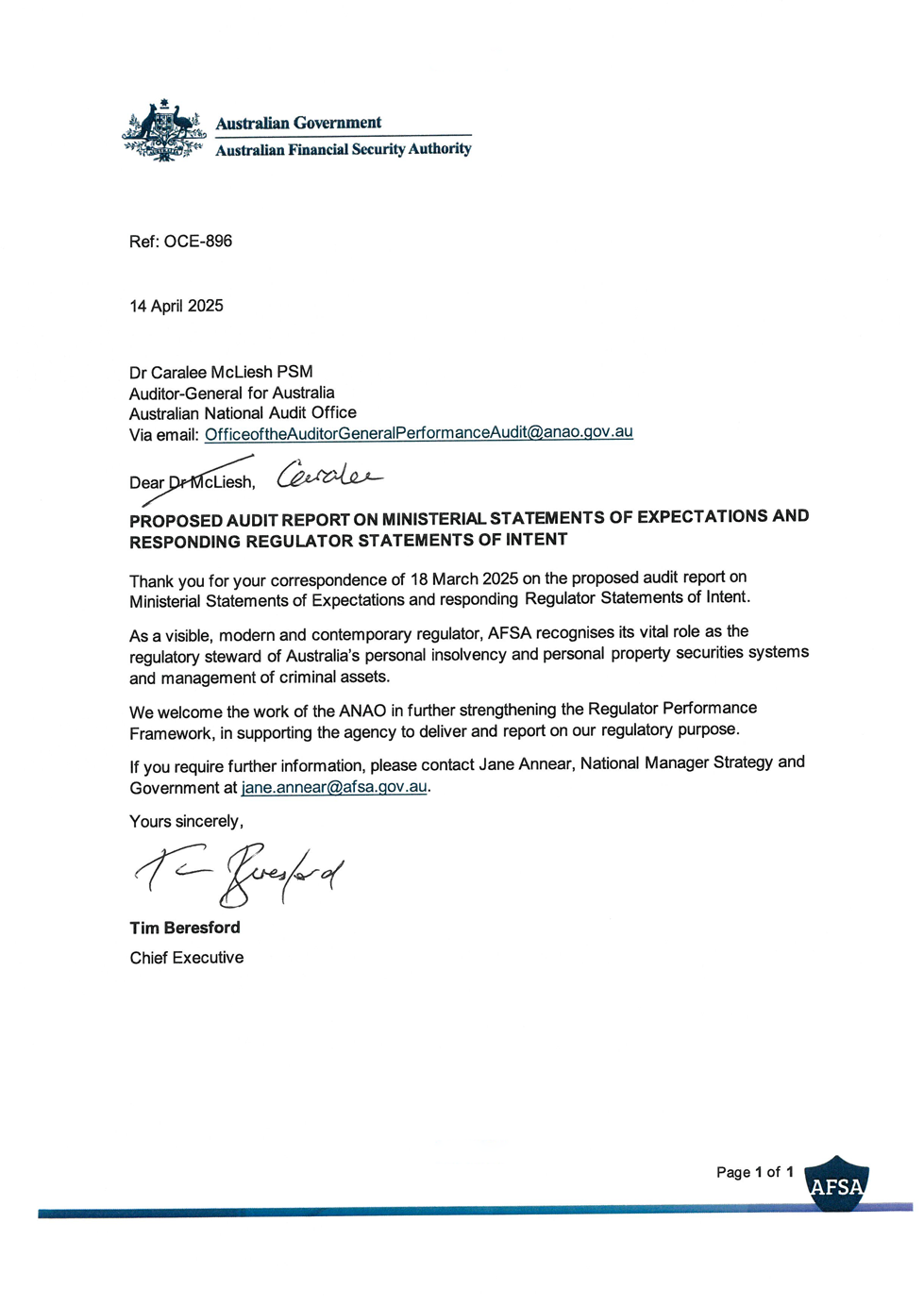
Department of Agriculture, Fisheries and Forestry
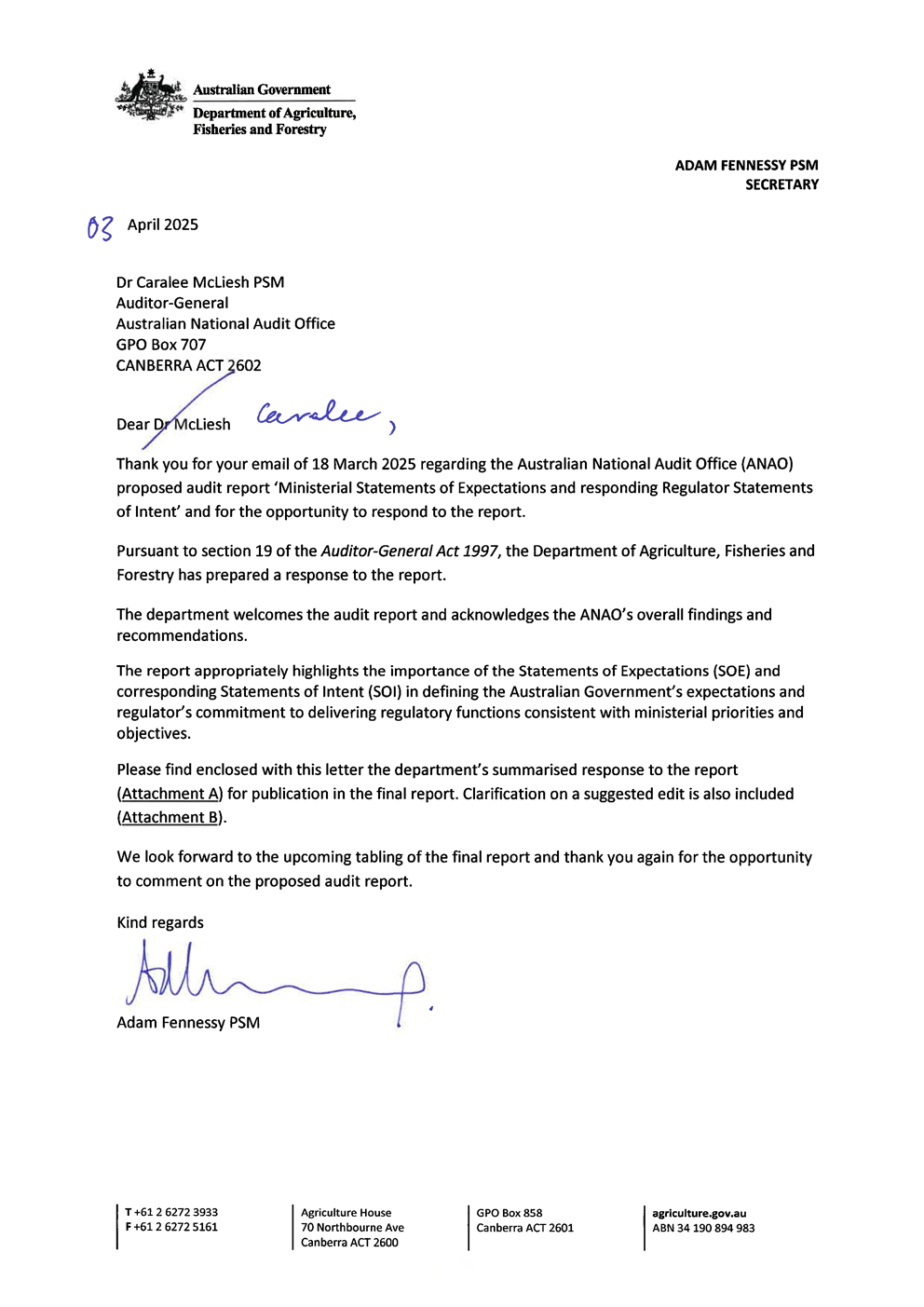
Department of Climate Change, Energy, the Environment and Water
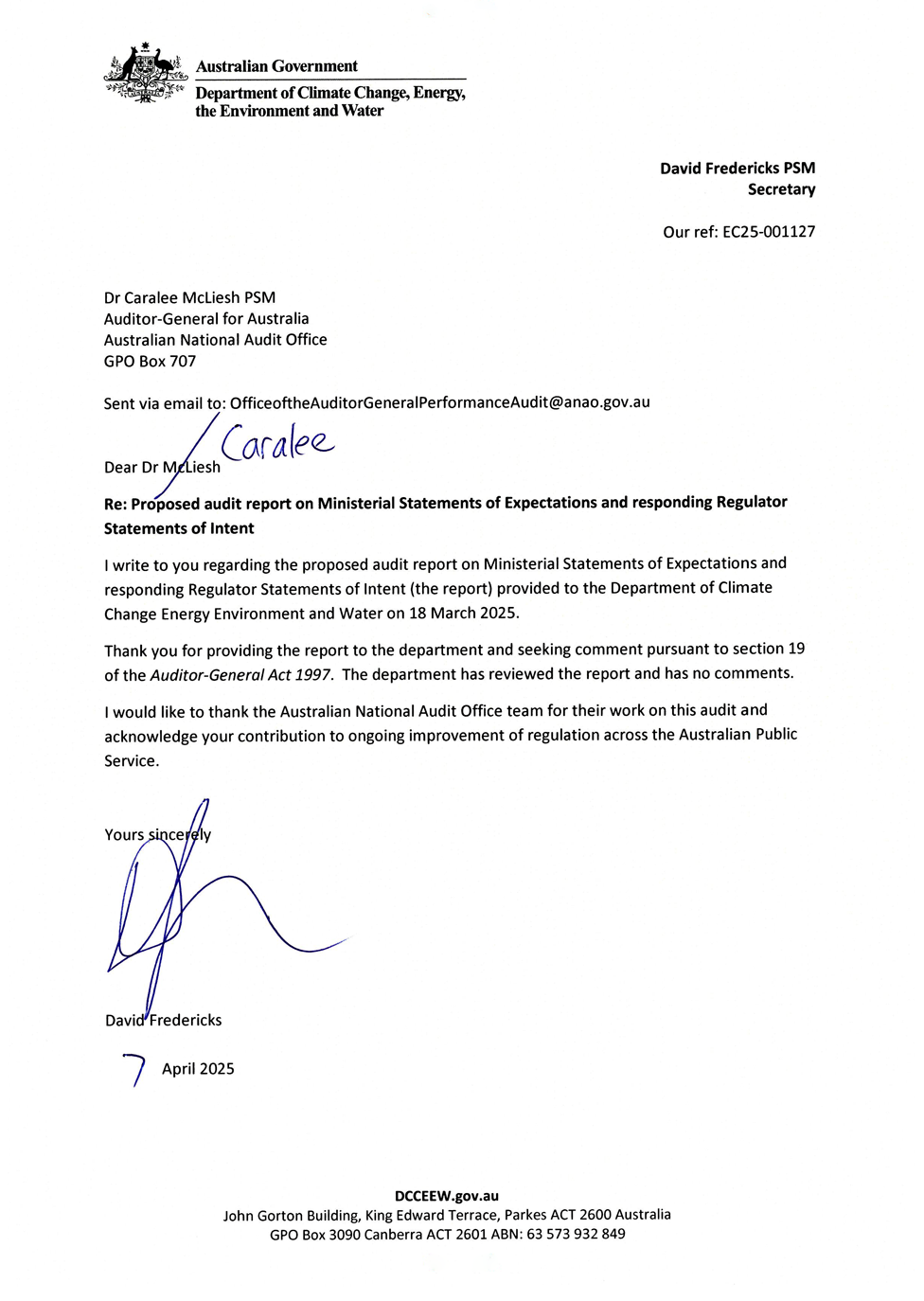
Department of Defence
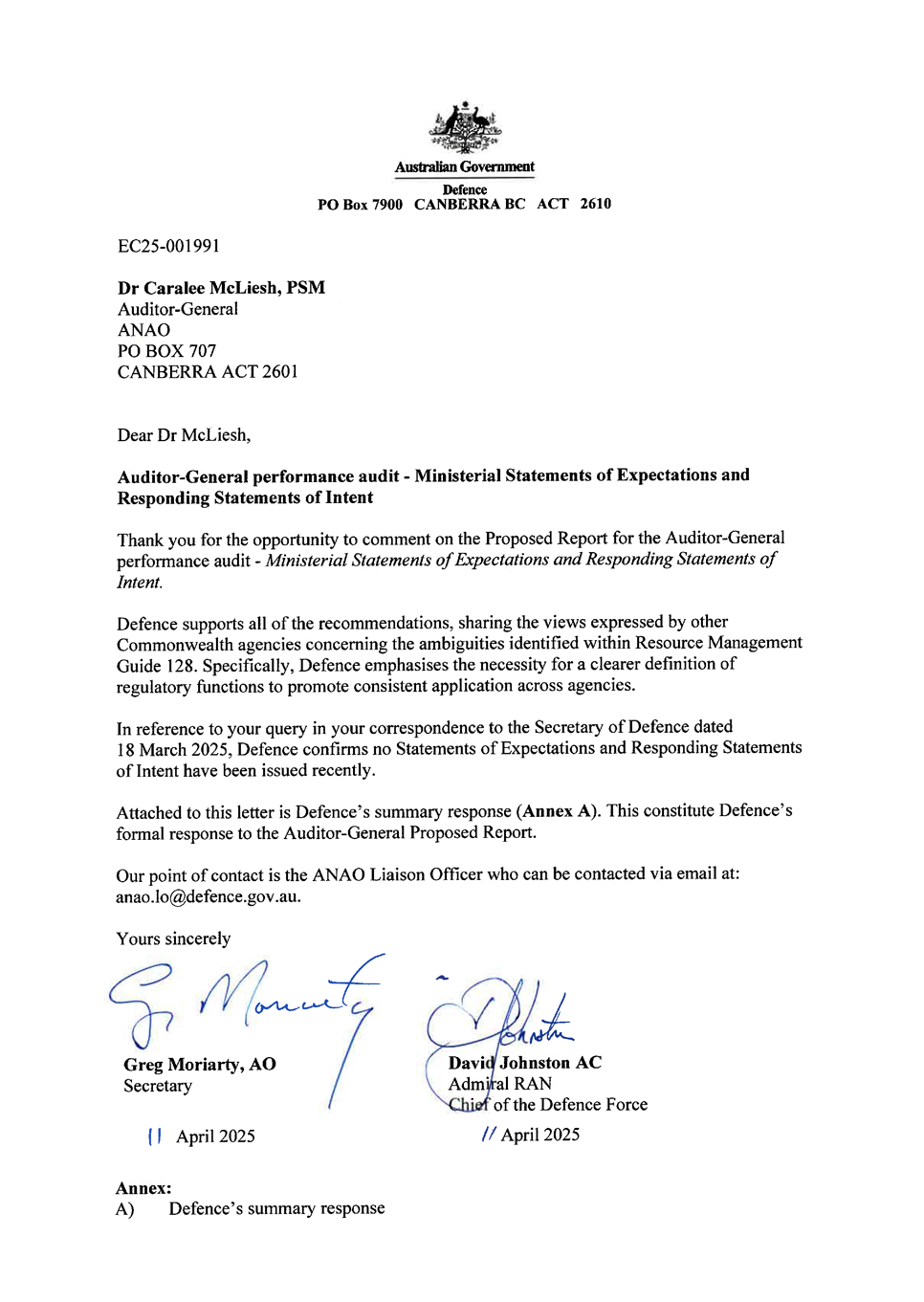
Department of Education
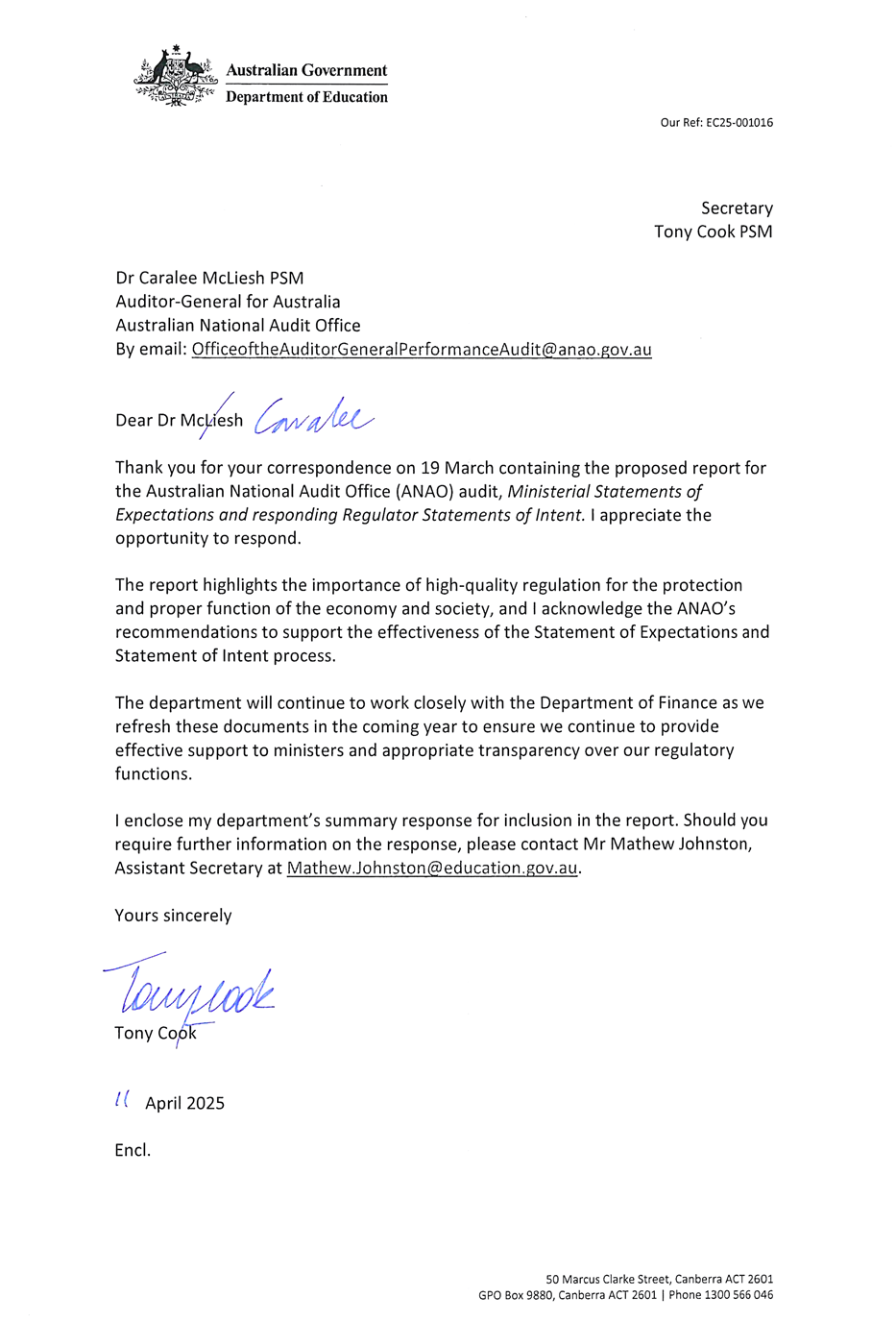
Department of Employment and Workplace Relations

Department of Health, Disability and Ageing
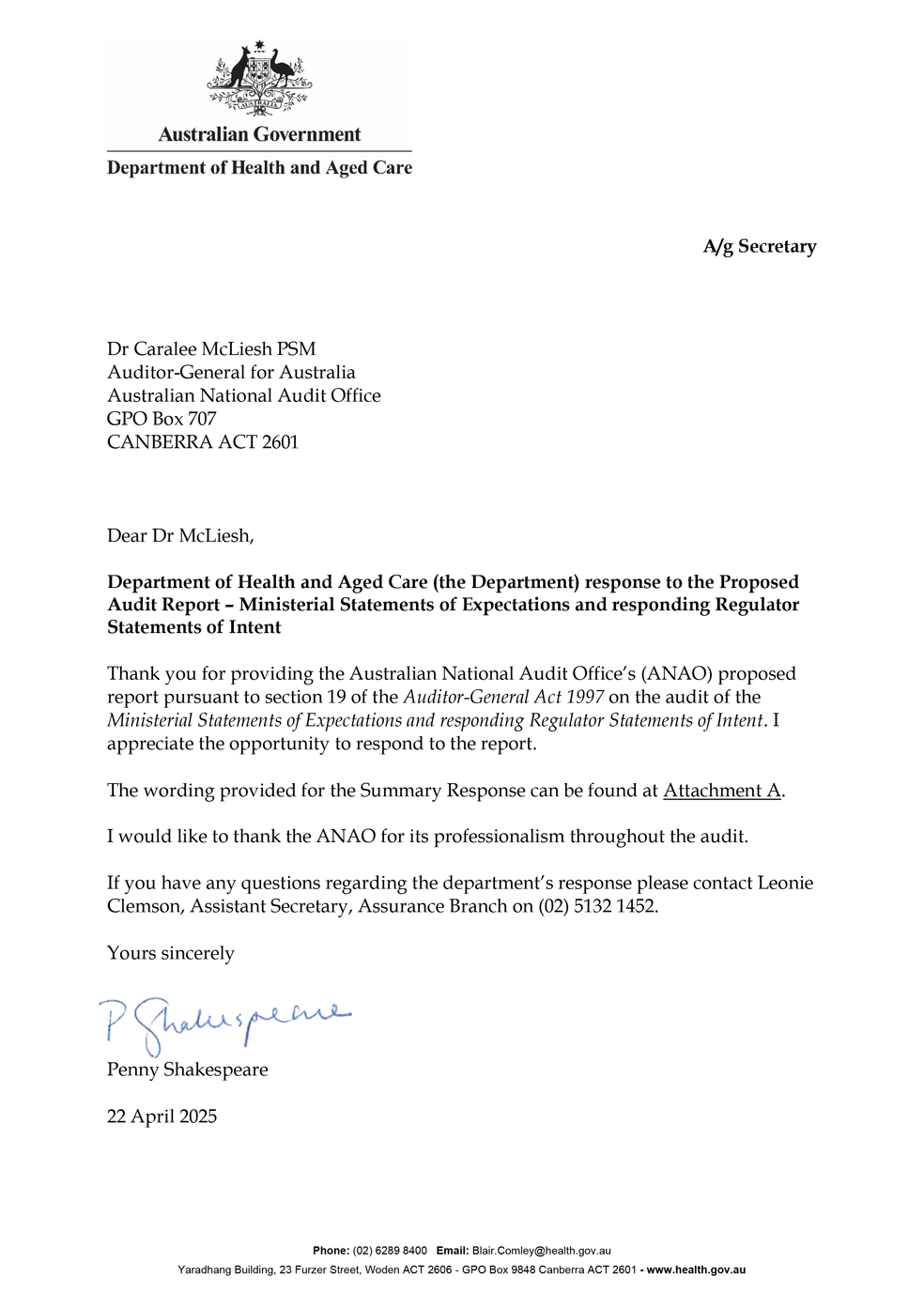
Department of Industry, Science and Resources
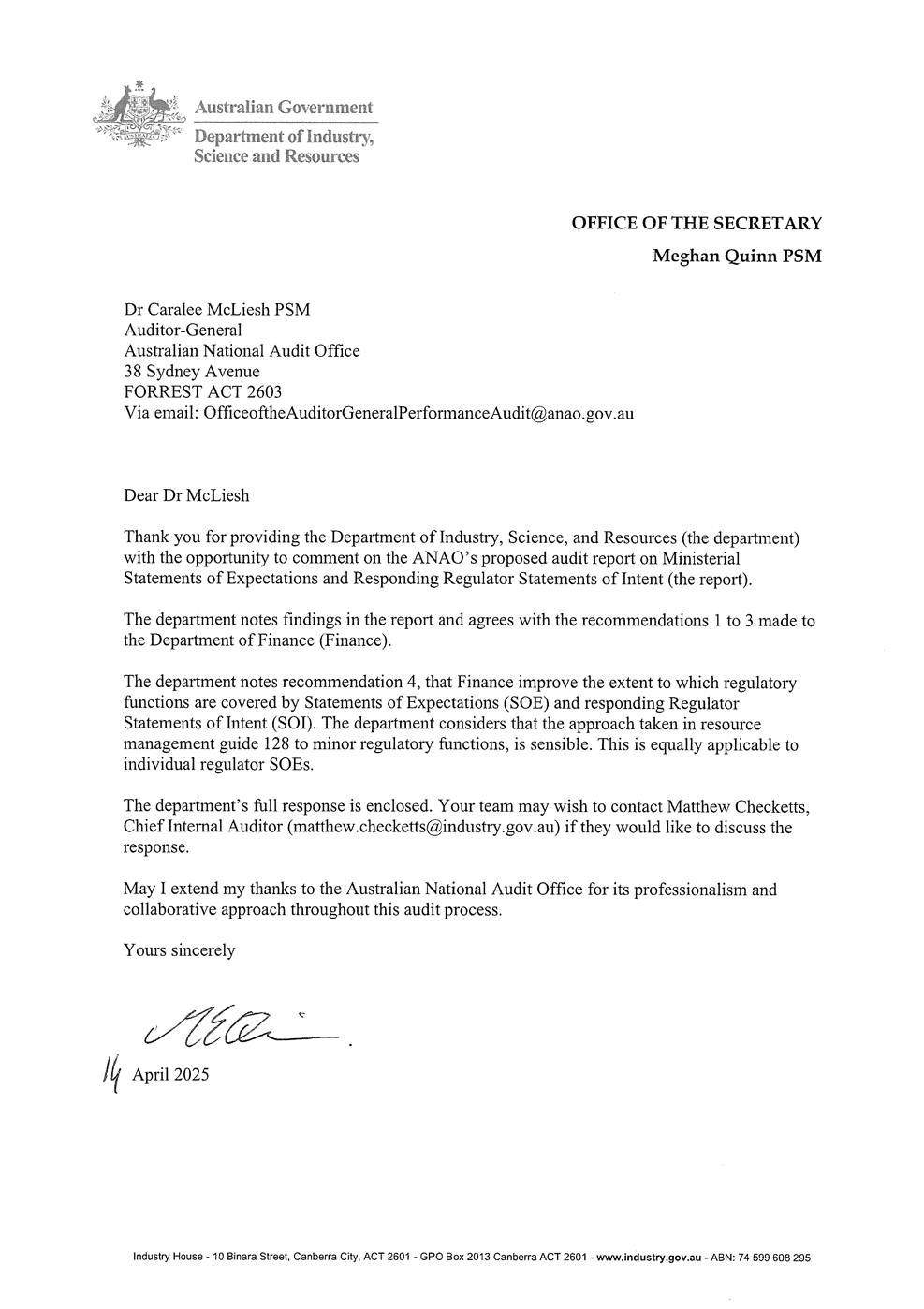
Department of Infrastructure, Transport, Regional Development, Communications, Sport and the Arts
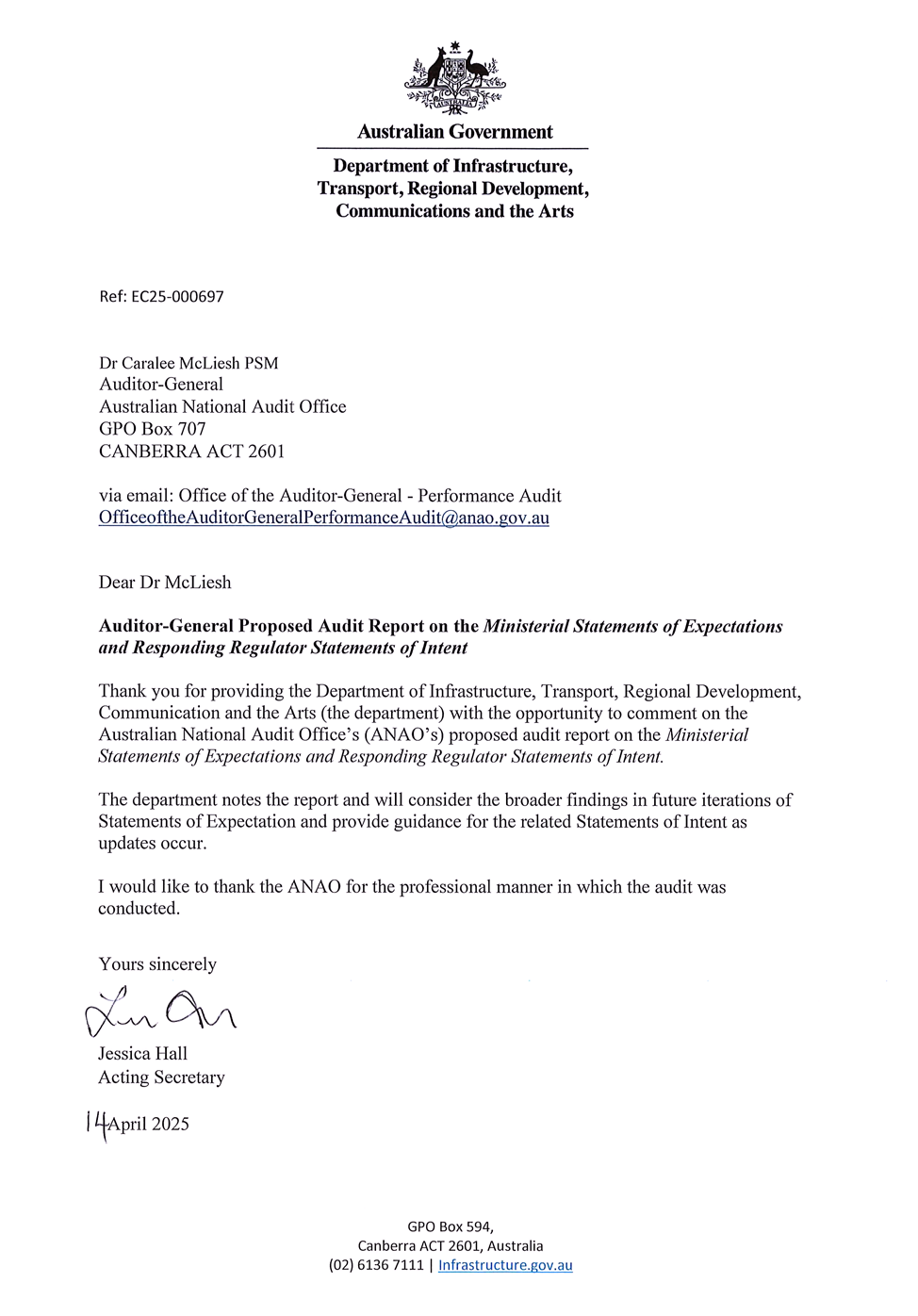
Department of Social Services
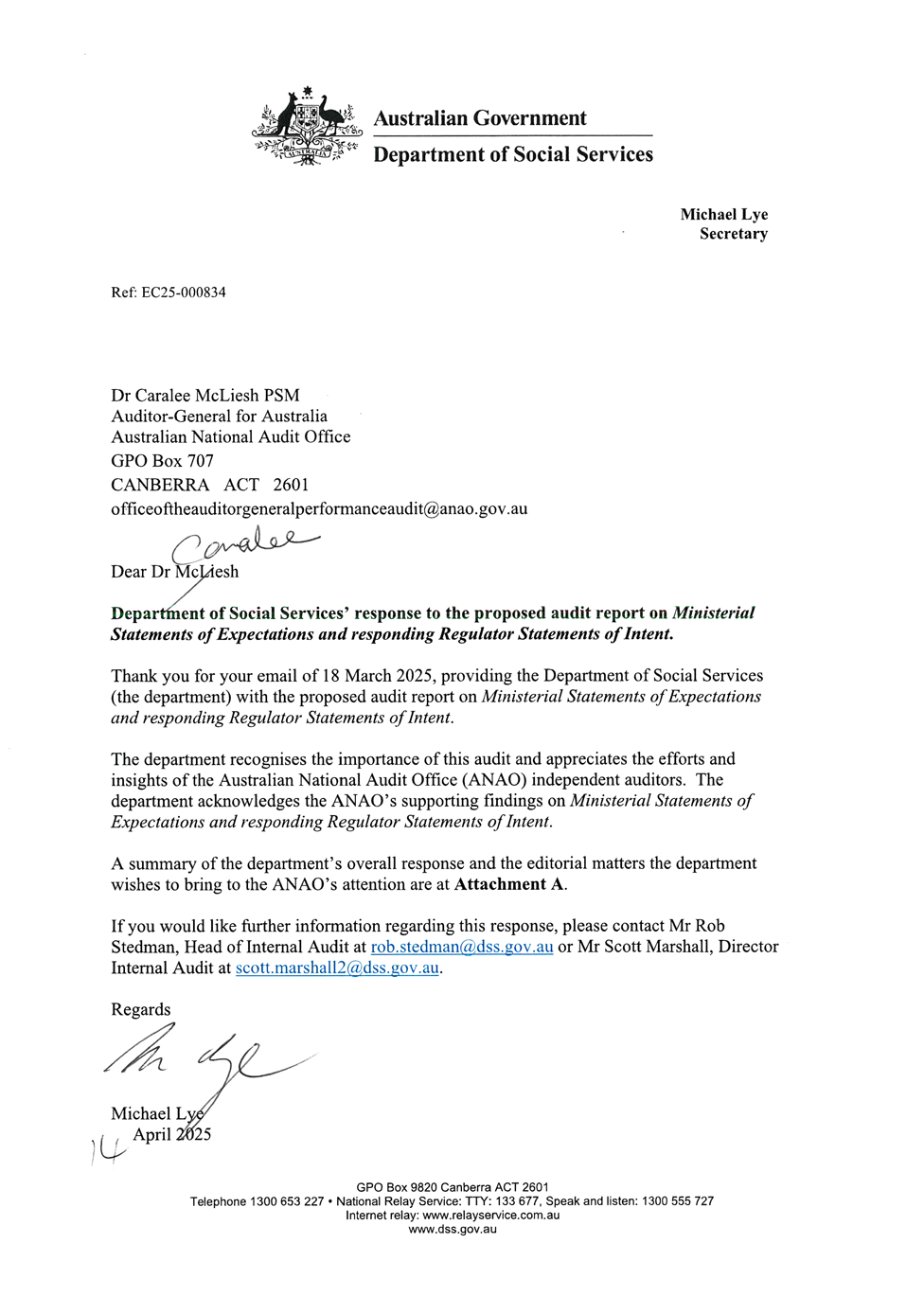
Department of the Treasury
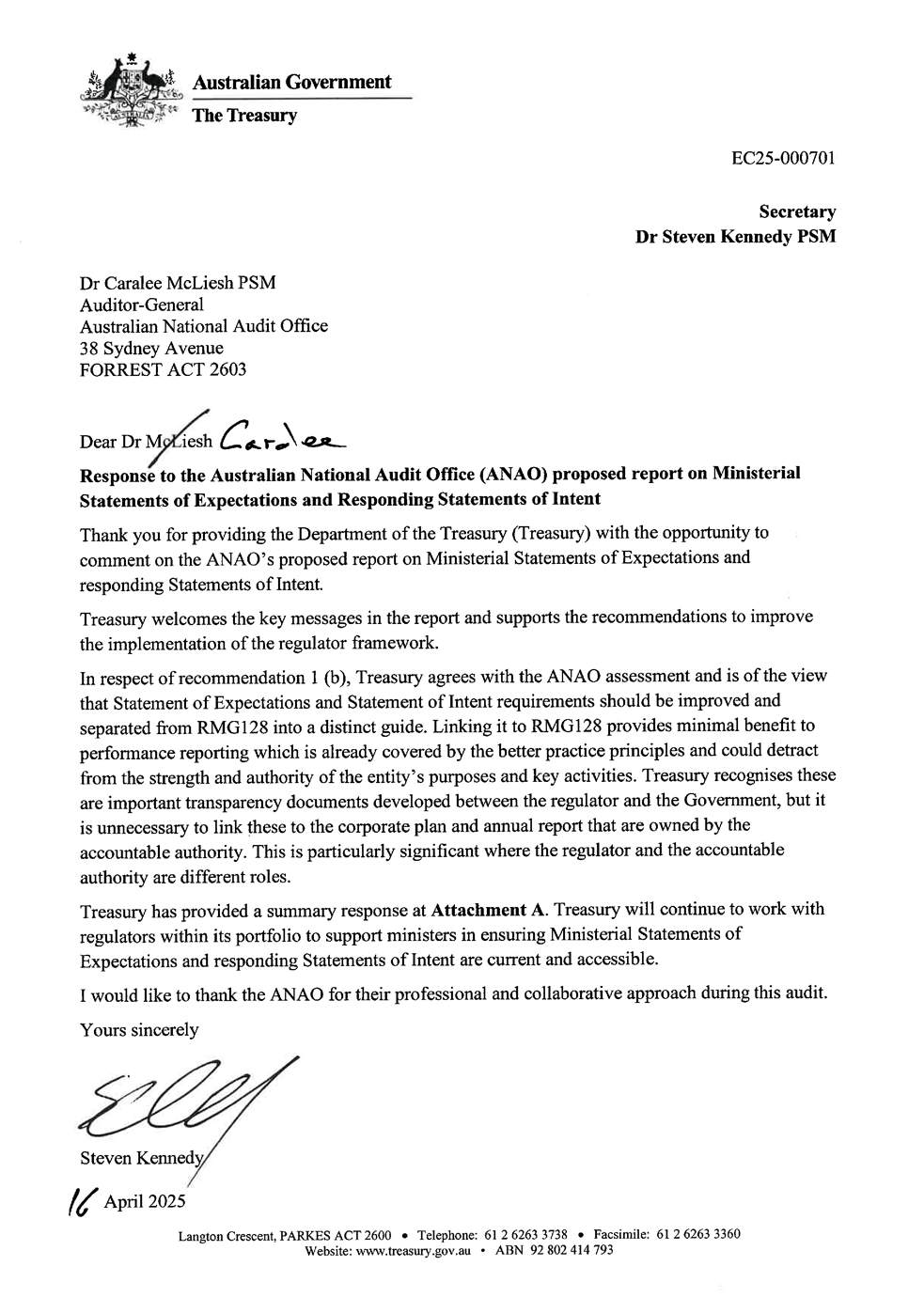
Department of Veterans’ Affairs
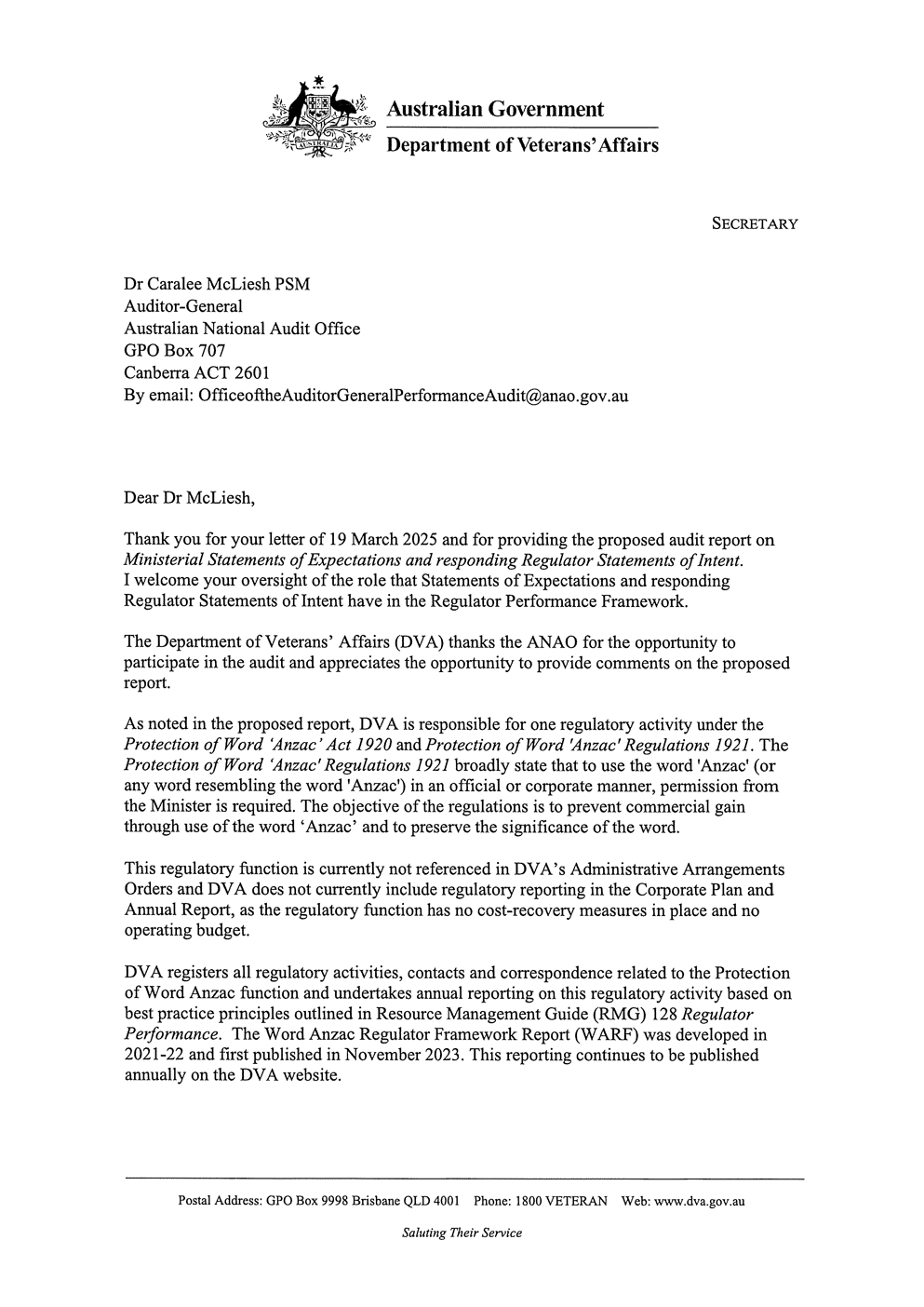
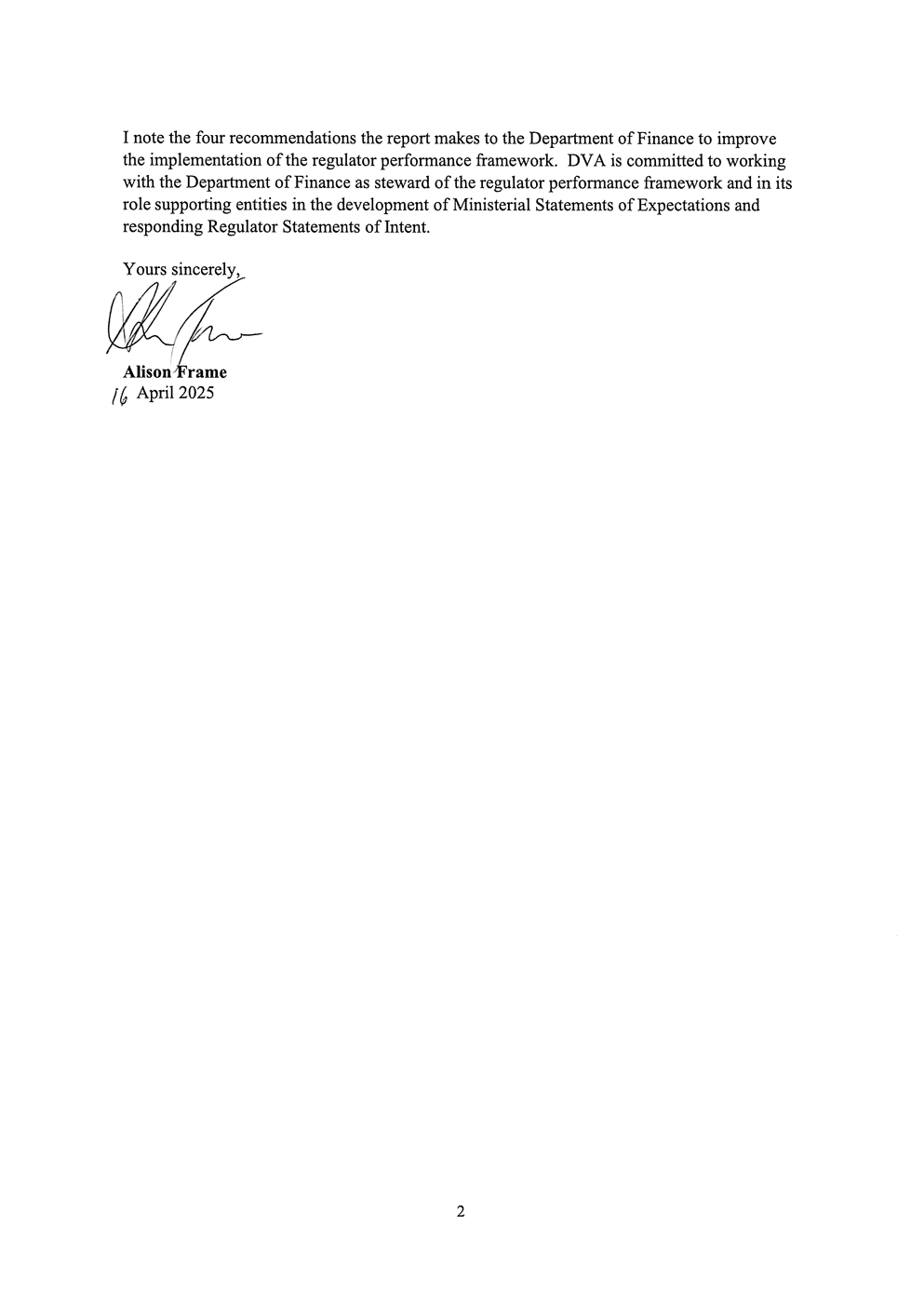
Murray–Darling Basin Authority
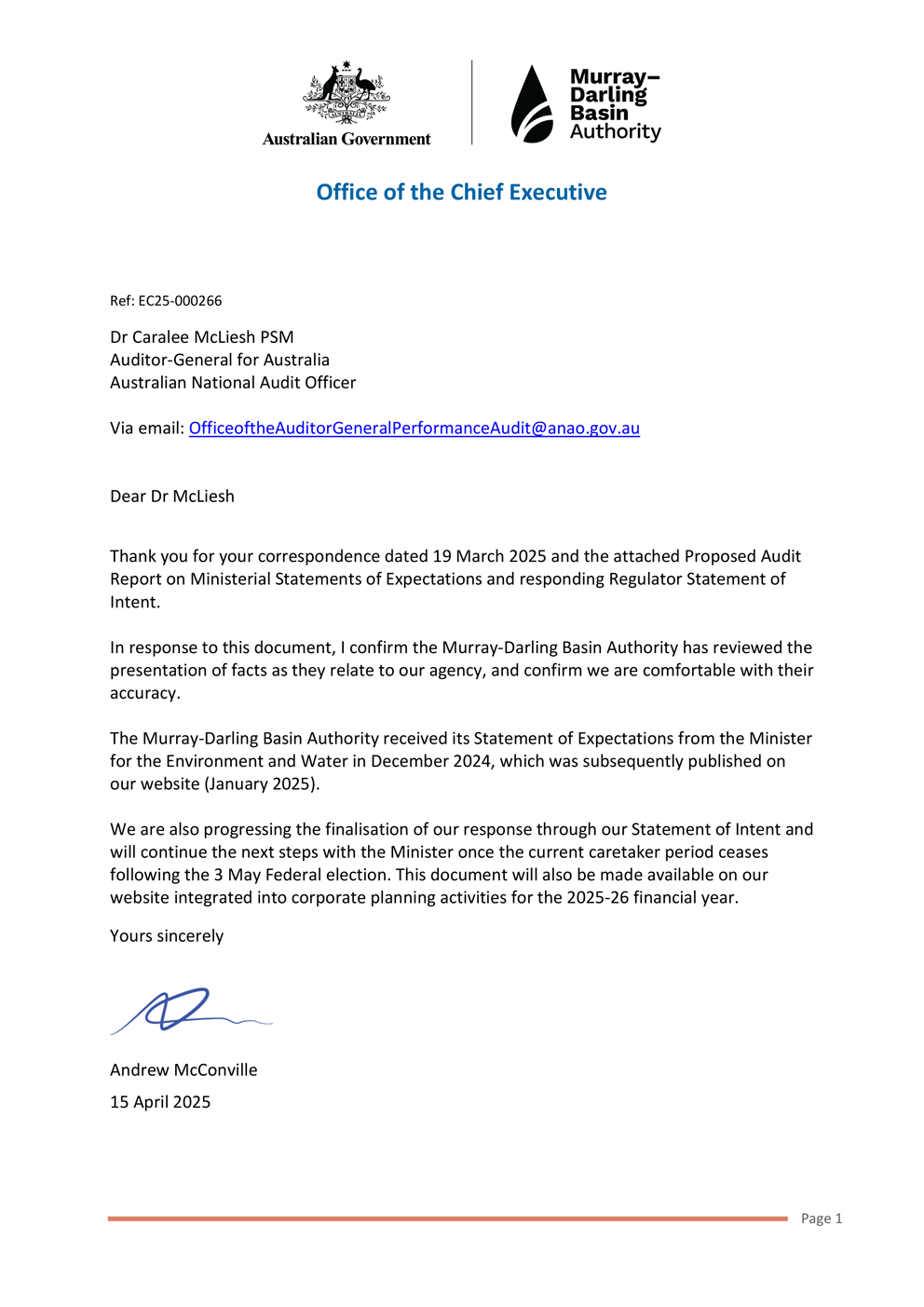
National Anti-Corruption Commission
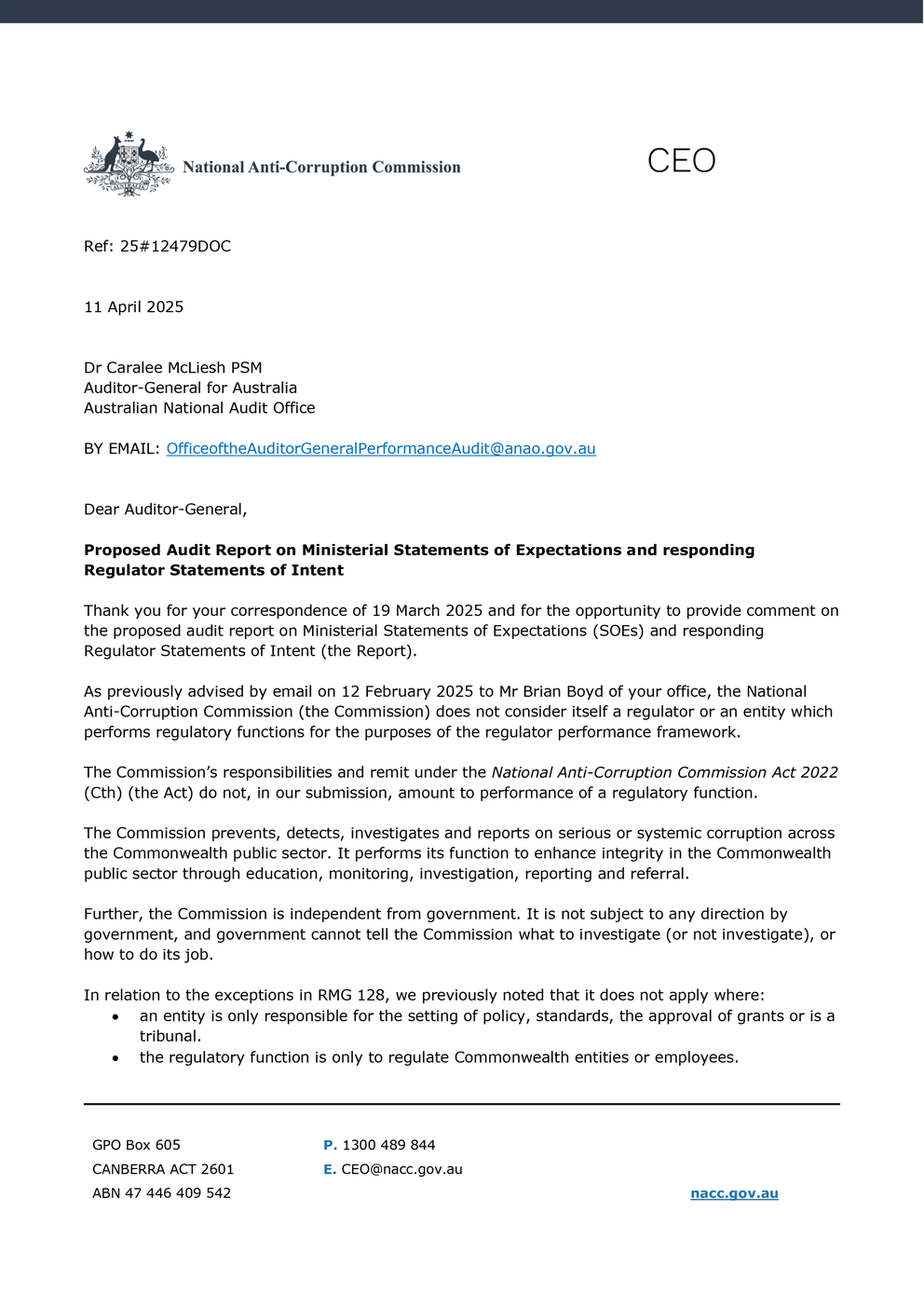
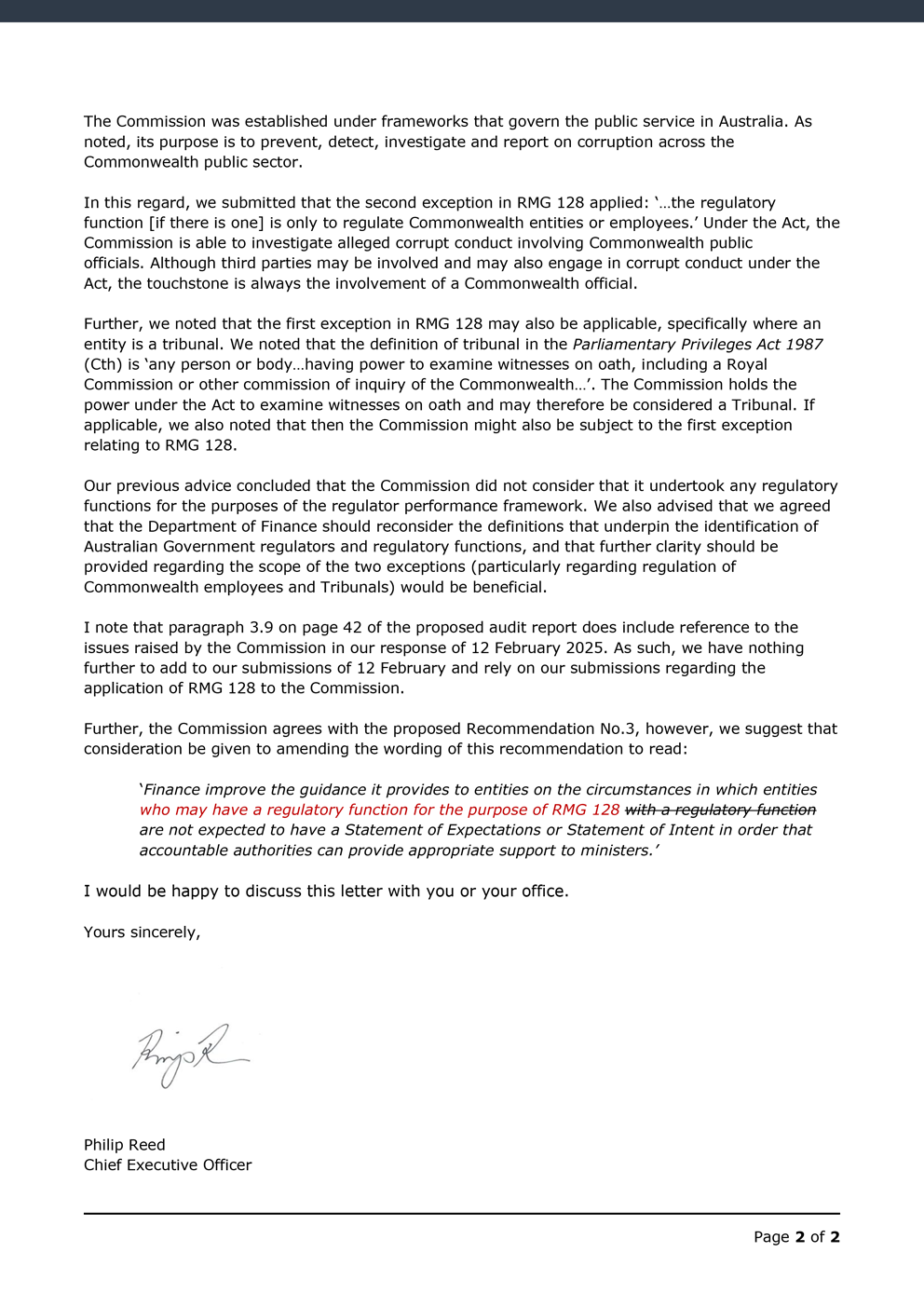
National Disability Insurance Agency
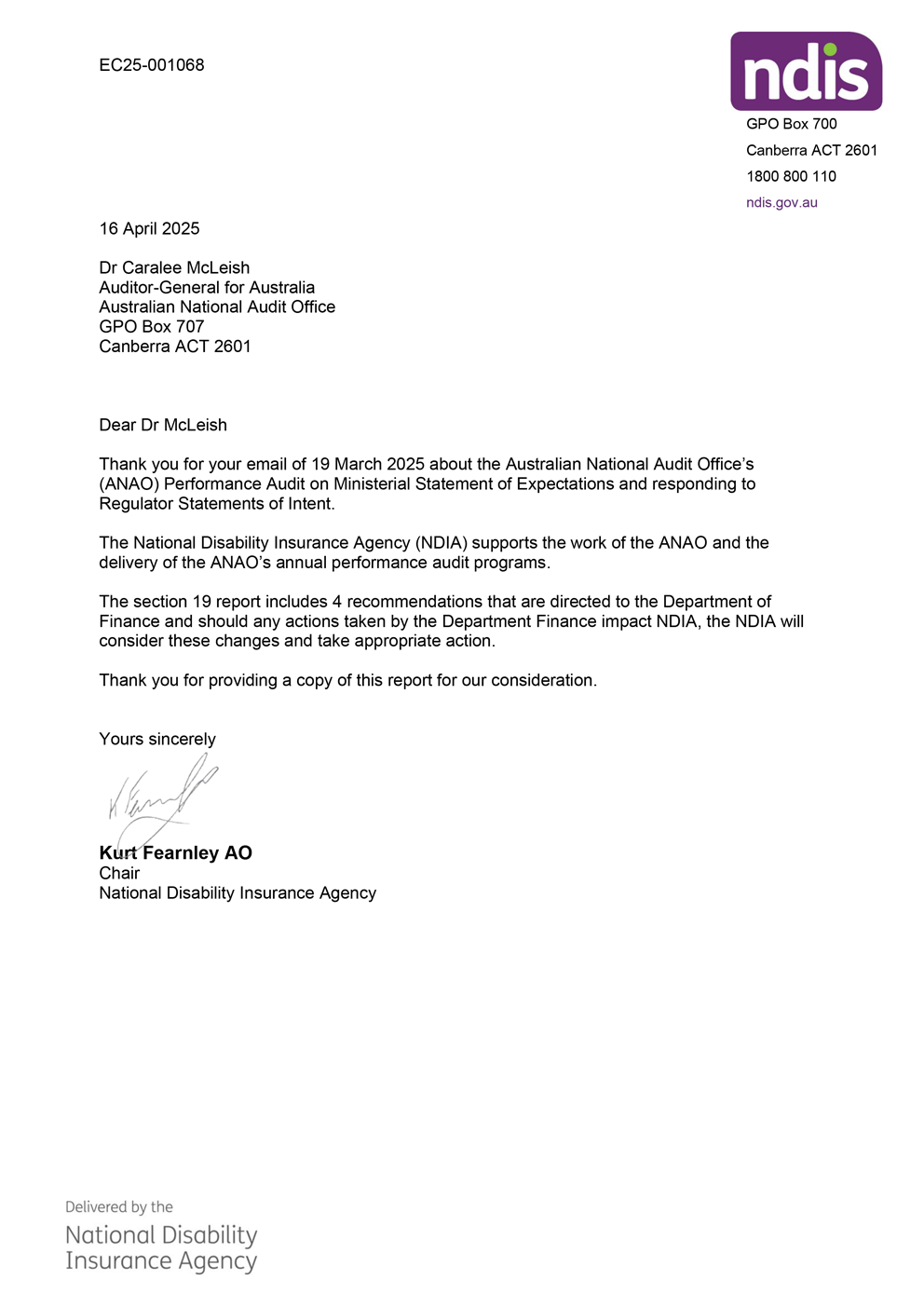
National Offshore Petroleum Safety and Environmental Management Authority
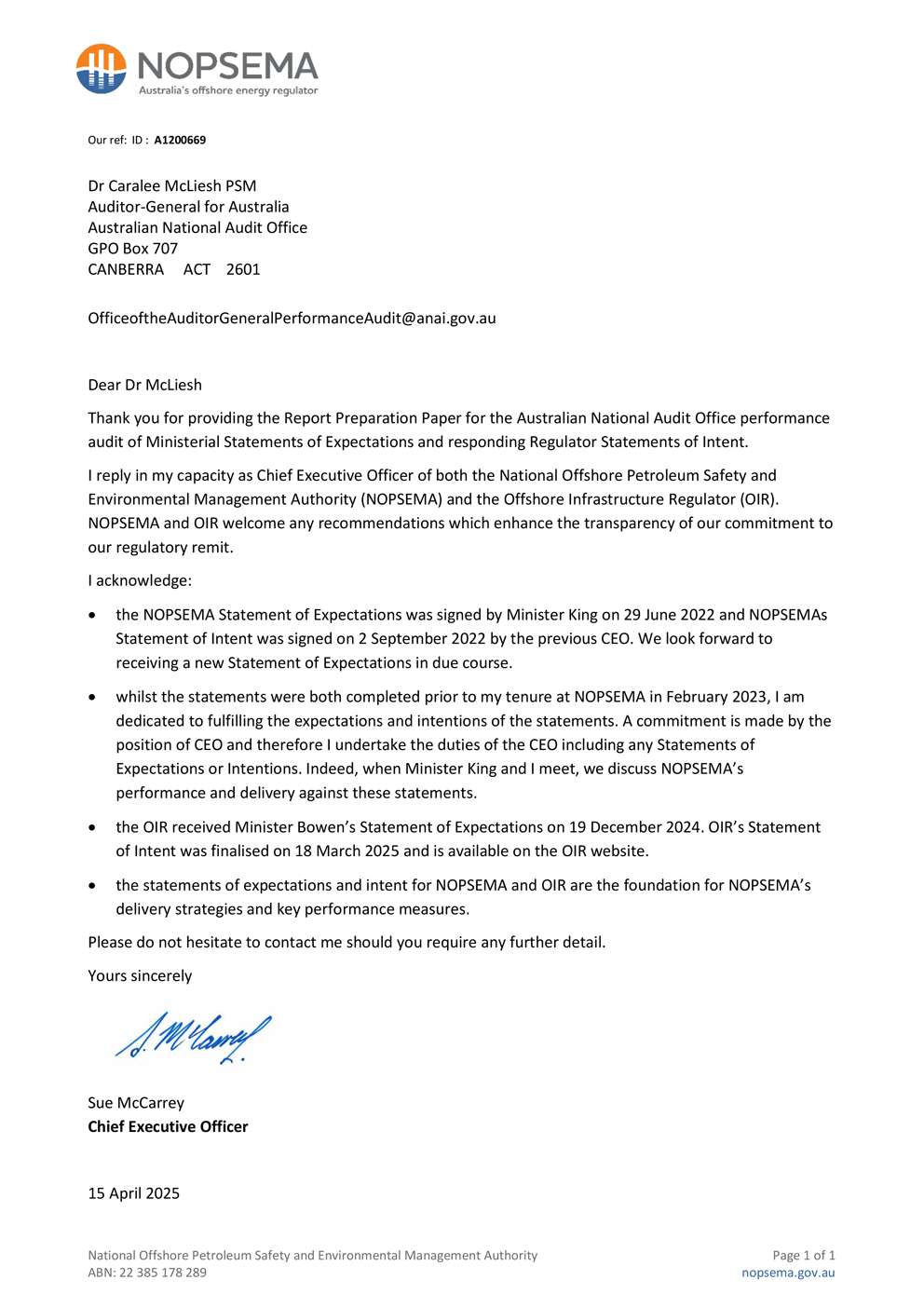
Office of the Special Investigator
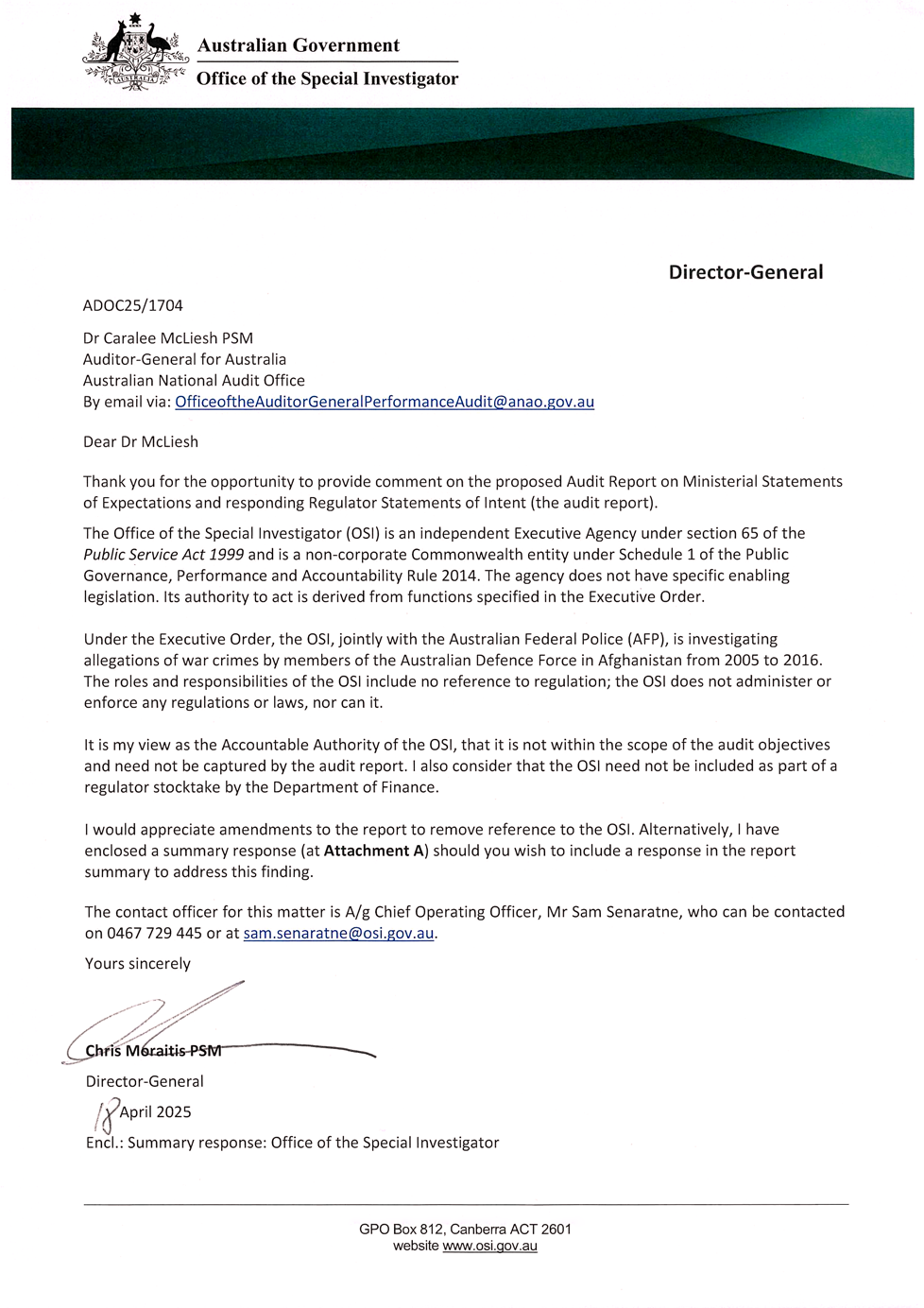
Professional Services Review
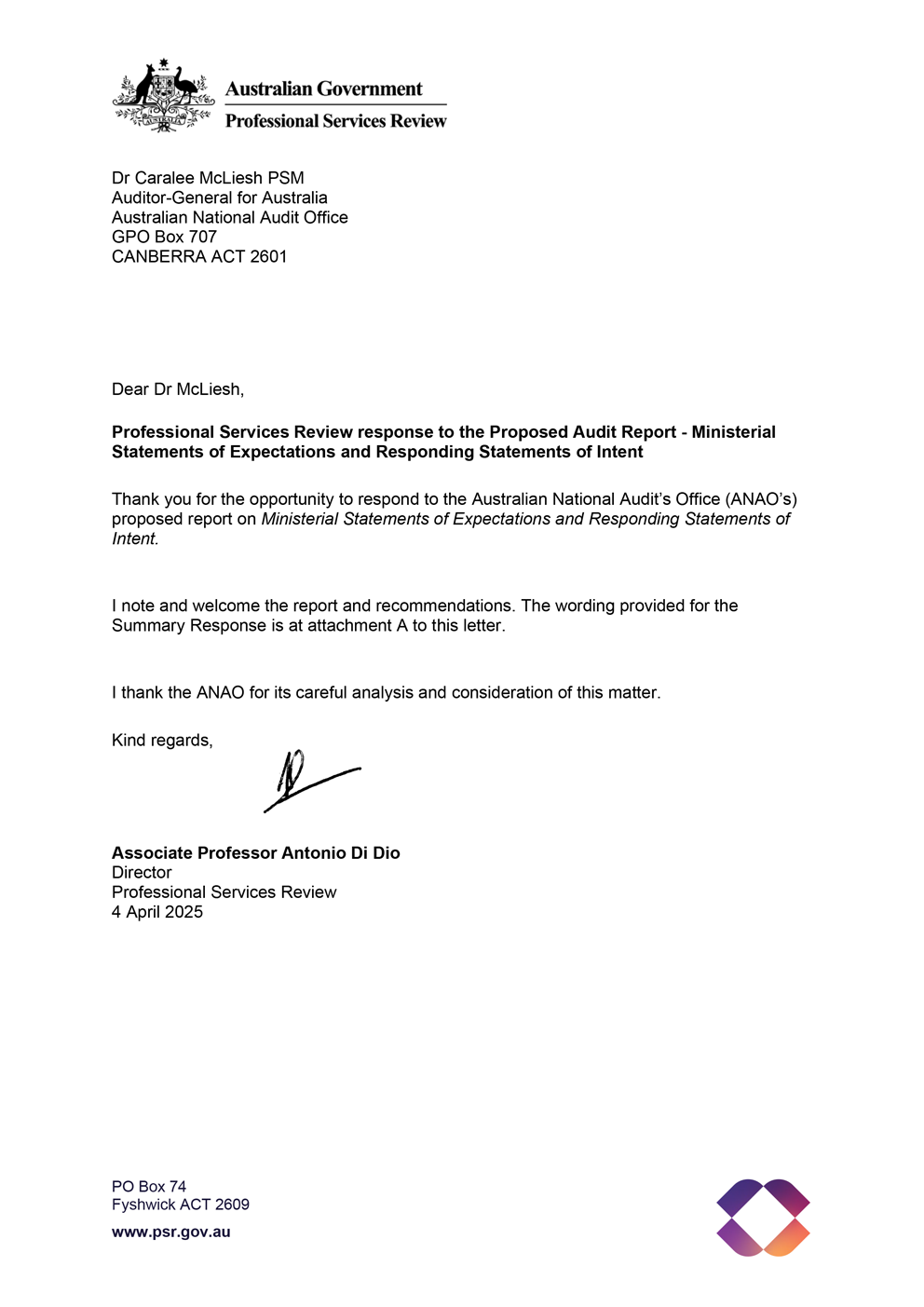
Services Australia
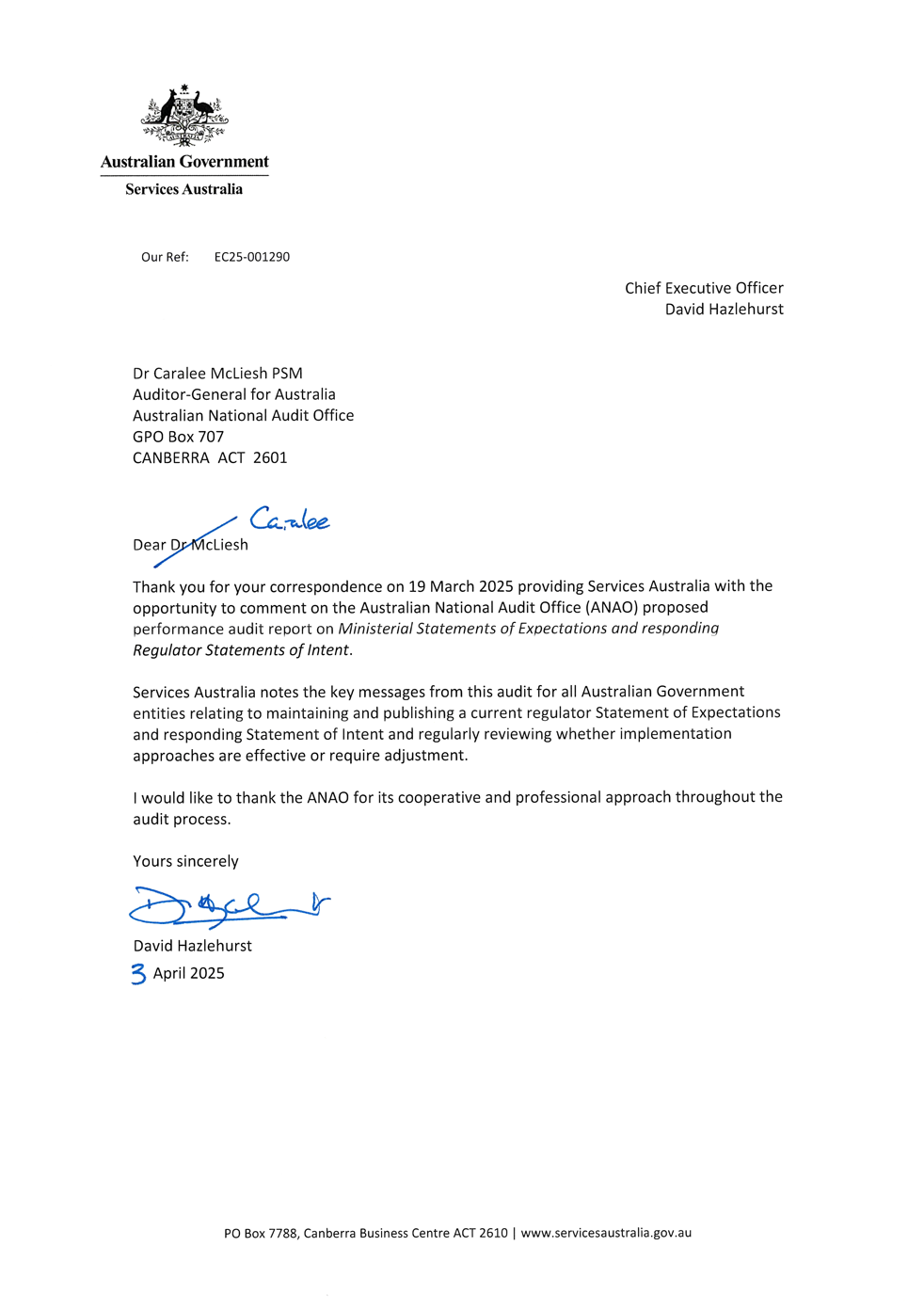
Sydney Harbour Federation Trust
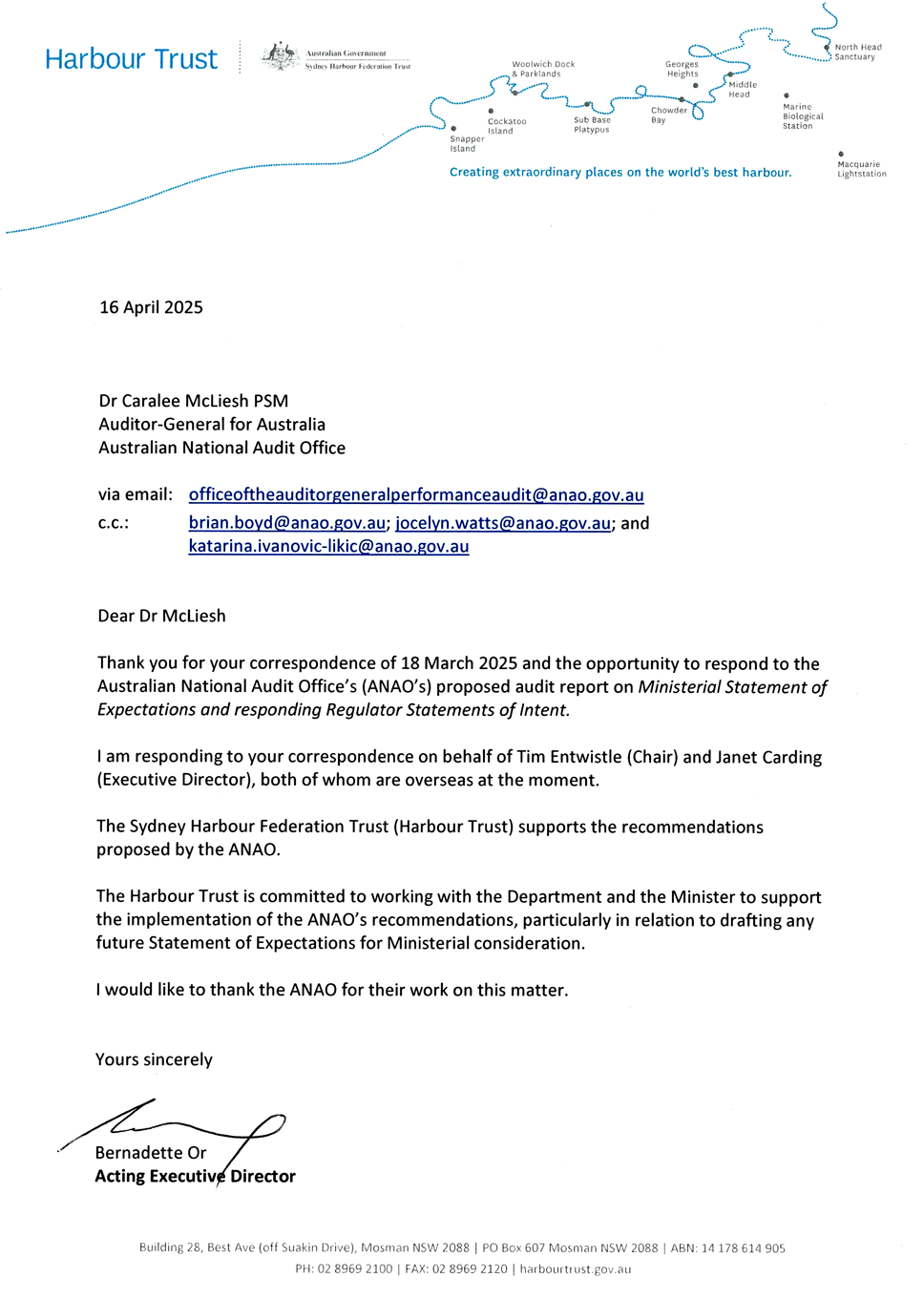
Wine Australia

Appendix 2 Improvements observed by the ANAO
1. The existence of independent external audit, and the accompanying potential for scrutiny improves performance. Improvements in administrative and management practices usually occur: in anticipation of ANAO audit activity; during an audit engagement; as interim findings are made; and/or after the audit has been completed and formal findings are communicated.
2. The Joint Committee of Public Accounts and Audit (JCPAA) has encouraged the ANAO to consider ways in which the ANAO could capture and describe some of these impacts. The ANAO’s corporate plan states that the ANAO’s annual performance statements will provide a narrative that will consider, amongst other matters, analysis of key improvements made by entities during a performance audit process based on information included in tabled performance audit reports.
3. Performance audits involve close engagement between the ANAO and the audited entity as well as other stakeholders involved in the program or activity being audited. Throughout the audit engagement, the ANAO outlines to the entity the preliminary audit findings, conclusions and potential audit recommendations. This ensures that final recommendations are appropriately targeted and encourages entities to take early remedial action on any identified matters during the course of an audit. Remedial actions entities may take during the audit include:
- strengthening governance arrangements;
- introducing or revising policies, strategies, guidelines or administrative processes; and
- initiating reviews or investigations.
4. During the course of the audit, the ANAO was informed of the following changes in Finance’s approach to oversight of the regulator performance framework:
- documenting some of its processes in a Standard Operating Procedure (see paragraph 2.5)
- proposing guidance on RMG 128 be included in the Machinery of Government Changes Guide (see paragraph 3.23); and
- providing information about the government’s regulatory reform agenda including SOE and SOI to newly appointed accountable authorities and heads of regulators (see paragraph 3.23)
5. The ANAO has not sought to obtain assurance over whether these actions have been appropriately implemented, other than observing that the Standard Operating Procedure does not yet address two key processes (assessing whether a Commonwealth entity is a regulator and subject to RMG 128; and reporting on the publication of SOE and SOI).
6. There were also a number of entities that implemented, or updated, their SOE and/or SOI during the course of the audit. In addition, there were entities that advised the ANAO that they are reviewing whether they undertake regulatory functions. Table A.1 sets out the entities which have published or updated SOE since the performance audit commenced in June 2024.
Table A.1: Regulators with updated SOE since June 2024
|
Regulator |
Date |
|
Aged Care Quality and Safety Commission |
27 September 2024 |
|
Australian Communications and Media Authority |
December 2024 |
|
Australian Maritime Safety Authority |
30 September 2024 |
|
Australian Radiation Protection and Nuclear Safety Agency |
8 October 2024 |
|
Australian Skills Quality Authority (National Vocational Education and Training Regulator) |
6 March 2025 |
|
Bureau of Meteorology |
17 January 2025 |
|
Clean Energy Regulator |
SOE signed October 2024 |
|
Coal Mining Industry (Long Service Leave Funding) Corporation (Coal LSL) |
November 2024 |
|
Comcare |
SOE signed 12 December 2024 and published on regulator website 2 April 2025 |
|
Department of Climate Change, Energy, the Environment and Water (DCCEEW) |
30 August 2024 (CCE) 4 November 2024 (EW) |
|
Department of Education |
July 2024 |
|
Department of Home Affairs |
November 2024 |
|
Murray–Darling Basin Authority |
22 January 2025 |
|
National Health and Medical Research Council |
19 November 2024 |
|
Office of the Australian Information Commissioner |
October 2024 |
|
Services Australia |
December 2024 |
|
Anti-Dumping Commission (Department of Industry, Science and Resources)a |
11 March 2025 |
|
Federal Safety Commissioner (Department of Employment and Workplace Relations)a |
December 2024 |
|
Inspector-General of Water Compliance (DCCEW)a |
11 September 2024 |
Note a: Blue shading indicates regulatory functions within departments with external governance arrangements. These regulators were issued with separate SOE to the portfolio department.
Source: ANAO analysis of entities’ records.
7. The following regulators also had their SOI updated since December 2024:
- Australian Communications and Media Authority (March 2025);
- Australian Radiation Protection and Nuclear Safety Agency (March 2025);
- Clean Energy Regulator (draft document dated March 2025);
- Offshore Infrastructure Regulator (February 2025); and
- Coal LSL (March 2025).
Appendix 3 Bodies that were provided with the opportunity to comment on the preliminary audit findings
|
Body |
Input sought on the basis of initial audit analysis |
Response received to preliminary audit findings |
|
Department of Finance (DoF) |
✔ |
✔ |
|
Airservices Australia |
✘ |
✘ |
|
Aged Care Quality and Safety Commission |
✔ |
✔ |
|
Anindilyakwa Land Council |
✘ |
✘ |
|
Attorney-General’s Department |
✔ |
✔ |
|
Australian Communications and Media Authority (ACMA) |
✔ |
✔ |
|
Australian Competition and Consumer Commission |
✘ |
✘ |
|
Australian Criminal Intelligence Commission |
✘ |
✘ |
|
Australian Digital Health Agency |
✔ |
✔ |
|
Australian Electoral Commission |
✔ |
✔ |
|
Australian Federal Police |
✔ |
✔ |
|
Australian Financial Security Authority |
✔ |
✔ |
|
Australian Fisheries Management Authority |
✔ |
✔ |
|
Australian Human Rights Commission |
✔ |
✔ |
|
Australian Maritime Safety Authority |
✔ |
✔ |
|
Australian National University |
✘ |
✘ |
|
Australian Nuclear Science and Technology Organisation |
✔ |
✘ |
|
Australian Pesticides and Veterinary Medicines Authority |
✘ |
✔ |
|
Australian Prudential Regulation Authority |
✘ |
✔ |
|
Australian Radiation Protection and Nuclear Safety Agency |
✔ |
✔ |
|
Australian Securities and Investments Commission |
✔ |
✔ |
|
Australian Skills Quality Authority (National Vocational Education and Training Regulator) |
✘ |
✔ |
|
Australian Taxation Office (ATO) |
✔ |
✔ |
|
Australian Transaction Reports and Analysis Centre |
✘ |
✔ |
|
Central Land Council |
✘ |
✘ |
|
Civil Aviation Safety Authority |
✘ |
✘ |
|
Clean Energy Regulator |
✔ |
✘ |
|
Coal Mining Industry (Long Service Leave Funding) Corporation |
✘ |
✘ |
|
Comcare |
✔ |
✔ |
|
Department of Agriculture, Fisheries and Forestry |
✔ |
✔ |
|
Department of Climate Change, Energy, the Environment and Water (DCCEEW) |
✔ |
✔ |
|
Department of Defence |
✔ |
✔ |
|
Department of Education |
✔ |
✘ |
|
Department of Employment and Workplace Relations (DEWR) |
✔ |
✔ |
|
Department of Foreign Affairs and Trade (DFAT) |
✔ |
✘ |
|
Department of Health, Disability and Ageing (DHDA) |
✔ |
✔ |
|
Department of Home Affairs |
✔ |
✔ |
|
Department of Industry, Science and Resources (DISR) |
✔ |
✔ |
|
Department of Infrastructure, Transport, Regional Development, Communications, Sport and the Arts |
✔ |
✔ |
|
Department of the Prime Minister and Cabinet |
✔ |
✔ |
|
Department of Social Services |
✔ |
✔ |
|
Department of the Treasury |
✔ |
✔ |
|
Department of Veterans’ Affairs |
✔ |
✔ |
|
Fair Work Commission |
✔ |
✔ |
|
Food Standards Australia New Zealand |
✔ |
✘ |
|
Great Barrier Reef Marine Park Authority |
✔ |
✘ |
|
Independent Health and Aged Care Pricing Authority |
✔ |
✔ |
|
Independent Parliamentary Expenses Authority |
✔ |
✔ |
|
IP Australia |
✔ |
✔ |
|
Murray–Darling Basin Authority |
✔ |
✔ |
|
National Anti-Corruption Commission |
✘ |
✔ |
|
National Capital Authority |
✘ |
✘ |
|
National Disability Insurance Agency |
✔ |
✘ |
|
National Health and Medical Research Council |
✔ |
✔ |
|
National Indigenous Australians Agency |
✔ |
✔ |
|
National Offshore Petroleum Safety and Environmental Management Authority (NOPSEMA) |
✔ |
✔ |
|
NDIS Quality and Safeguards Commission |
✔ |
✔ |
|
Northern Land Council |
✘ |
✘ |
|
Office of the Australian Information Commissioner |
✔ |
✘ |
|
Office of the Commonwealth Ombudsman |
✘ |
✔ |
|
Office of the Director of Public Prosecutions |
✘ |
✔ |
|
Office of the Fair Work Ombudsman |
✘ |
✘ |
|
Office of the Special Investigator |
✘ |
✔ |
|
Parliamentary Workplace Support Service |
✘ |
✔ |
|
Professional Services Review |
✘ |
✘ |
|
Reserve Bank of Australia |
✔ |
✘ |
|
Seafarers Safety, Rehabilitation and Compensation Authority |
✘ |
✘ |
|
Services Australia |
✔ |
✔ |
|
Sport Integrity Australia |
✘ |
✔ |
|
Sydney Harbour Federation Trust |
✔ |
✘ |
|
Tertiary Education Quality and Standards Agency |
✔ |
✘ |
|
Tiwi Land Council |
✘ |
✘ |
|
Torres Strait Regional Authority |
✔ |
✘ |
|
Wine Australia |
✘ |
✘ |
|
Workplace Gender Equality Agency |
✔ |
✘ |
|
Wreck Bay Aboriginal Community Council |
✘ |
✘ |
|
Anti-Dumping Commission (DISR)a |
✔ via DISR |
✔ via DISR |
|
Australian Charities and Not-for-Profits Commission (ATO)a |
✘ |
✔ via ATO |
|
Australian Energy Regulator (DCCEEW)a |
✘ |
✔ |
|
Australian Industrial Chemicals Introduction Scheme (DHDA)a |
✘ |
✔ via DHDA |
|
Australian Industry Participation Authority (DISR)a |
✔ via DISR |
✔ via DISR |
|
Australian Safeguards and Non-Proliferation Office (DFAT)a |
✔ via DFAT |
✘ |
|
Australian Space Agency (DISR)a |
✘ |
✔ via DISR |
|
eSafety Commissioner (ACMA)a |
✔ via ACMA |
✔ via ACMA |
|
Federal Safety Commissioner (DEWR)a |
✔ via DEWR |
✔ via DEWR |
|
Gene Technology Regulator (DHDA)a |
✘ |
✔ via DHDA |
|
Greenhouse and Energy Minimum Standards Regulator (DCCEEW)a |
✔ via DCCEEW |
✔ via DCCEEW |
|
Inspector-General of Water Compliance (DCCEEW)a |
✔ via DCCEEW |
✔ via DCCEEW |
|
National Measurement Institute (DISR)a |
✔ via DISR |
✔ via DISR |
|
Office of the National Data Commissioner (DoF)a |
✔ via DoF |
✔ via DoF |
|
Office of the Registrar of Aboriginal and Torres Strait Islander Corporations (NIAA)a |
✔ via NIAA |
✘b |
|
Offshore Infrastructure Registrar (DISR) |
✘ |
✘c |
|
Offshore Infrastructure Regulator (NOPSEMA) |
✘ |
✘c |
|
Safety, Rehabilitation and Compensation Commission (DEWR)a |
✔ |
✔ via DEWR |
|
Tax Practitioners Board (ATO)a |
✔ |
✔ |
|
Water Efficiency Labelling and Standards Regulator (DCCEEW)a |
✔ via DCCEEW |
✔ via DCCEEW |
Key: ✔ Yes ✘ No
Note a: Blue shading indicates regulatory functions within departments with external governance arrangements.
Note b: Preliminary audit findings were not provided by NIAA to the Registrar.
Note c: These bodies were identified following National Offshore Petroleum Safety and Environmental Management Authority’s response to the preliminary audit findings.
Source: ANAO analysis of entity responses.
Footnotes
1 Department of Finance (Finance), Regulatory Policy, Practice & Performance Framework, July 2024, p. 4, available from https://www.regulatoryreform.gov.au/sites/default/files/Regulatory-Policy-Practice-and-Performance-Framework.pdf [accessed 23 August 2024].
2 Finance, Regulator Performance (RMG 128).
3 J. Uhrig, Review of the Corporate Governance of Statutory Authorities and Corporate Governance, Canberra, 2003, p. 8.
4 Finance describes Resource Management Guides (RMGs) as:
guidance documents. The purpose of an RMG is to support PGPA Act entities and companies in meeting the requirements of the PGPA framework. As guides, RMGs explain the legislation and policy requirements in plain English. RMGs support accountable authorities and officials to apply the intent of the framework.
Finance, List of Resource Management Guides (RMGs) – Grouped by topic, Finance, Canberra, https://www.finance.gov.au/government/resource-management/list-topic [accessed 30 January 2025].
5 Refer to Appendix 3 for a list of bodies with regulatory functions contacted throughout the course of the ANAO audit.
6 ANAO contacted entities as part of audit fieldwork and examined the coverage of each SOE for those entities based on regulatory functions they advised to the ANAO and whether these were covered in each entity SOE. Further regulators and further regulatory functions were identified as the audit proceeded. The same analysis was not undertaken of regulators/regulatory functions identified later in the audit process, which is why the numbers in the first two dot points are ‘at least’ and the total number does not add to 91.
7 Department of Finance, Regulatory Policy, Practice & Performance Framework, July 2024, p. 4.
8 SOE are issued to provide greater clarity about government policies and objectives relevant to the regulator in line with its objectives, and the priorities the minister expects it to observe in conducting its operations.
9 Finance, Regulator Performance (RMG 128).
10 J. Uhrig, Review of the Corporate Governance of Statutory Authorities and Corporate Governance, Canberra, 2003, p. 8.
11 OECD, OECD Best Practice Principles for Regulatory Policy – The Governance of Regulators, 2014 pp. 56, 81 and 82.
12 An SOI outlines how the regulator intends to meet the expectations set out in the SOE, including how it will demonstrate progress.
13 The Rule, along with the PGPA Act, outlines various requirements including, for example, for the quality of performance information, and for performance monitoring, evaluation and reporting. See Auditor-General Report No. 25 2024–25, Performance Statements Auditing in the Commonwealth — Outcomes from the 2023–24 Audit Program.
14 Joint Committee of Public Accounts and Audit, Parliament of Australia, Report 512: Report of the inquiry into the administration of Commonwealth regulations (2025), p. 86.
15 ibid., p. 95.
16 Joint Committee of Public Accounts and Audit, Parliament of Australia, Report 502: The never-ending quest for the golden thread (2024), p. 96.
17 Joint Committee of Public Accounts and Audit, Parliament of Australia, Report 512: Report of the inquiry into the administration of Commonwealth regulations (2025), p. 94.
18 New Administrative Arrangement Orders (AAOs) were signed by the Governor-General and Prime Minister on 1 June 2022. The AAOs commenced 1 July 2022.
19 Over 4 years to 2025–26.
20 Australian National Audit Office, Insights: Administering Regulation, ANAO, Canberra [14 January 2021], available from https://www.anao.gov.au/work/insights/administering-regulation [accessed 28 January 2025].
21 See Department of Treasury and Finance, Statement of Expectations Framework for Regulators, July 2024. That document defines a regulator as an entity that ‘subject to primary or subordinate legislation, performs one or more of the following functions: provides regulatory advice to a third party; licensing; accredit; monitor standards compliance; enforcement.’
22 See The Treasury, Guidance for Creating a Statement of Performance Expectations (SPE) under the Crown Entities Act (CEA), May 2022.
23 In April 2025, Finance advised the ANAO that the SOP was approved in February 2025.
24 Department of Finance (Finance), Regulator Performance (RMG 128), Finance, Canberra, July 2023, available from https://www.finance.gov.au/government/managing-commonwealth-resources/regulator-performance-rmg-128 [accessed 17 February 2025].
25 Department of the Prime Minister and Cabinet, Australian Government Guide to Policy Impact Analysis Department of the Prime Minister and Cabinet, Australia 2023, available from: https://oia.pmc.gov.au/resources/guidance-impact-analysis/australian-government-guide-policy-impact-analysis [accessed 21 June 2024].
26 An audit examining the effectiveness of the Department of the Prime Minister and Cabinet’s administration of the Impact Analysis framework was ongoing as of March 2025: Australian National Audit Office, Administration of the Impact Analysis framework, ANAO, Canberra, available from https://www.anao.gov.au/work/performance-audit/administration-of-the-impact-analysis-framework [accessed 4 March 2025].
27 Finance, Progressing Australia’s Regulatory Reform Agenda, Finance, Australia, 2022, available from https://www.regulatoryreform.gov.au/ [accessed 21 June 2024].
28 Finance, Australian Government Regulatory Policy, Practice and Performance Framework, Finance, Australia, 2024, available from https://www.regulatoryreform.gov.au/sites/default/files/Regulatory-Policy-Practice-and-Performance-Framework.pdf [accessed 23 August 2024].
29 The framework was made publicly available in August 2024.
30 Finance advised the ANAO that:
while not specified as a definition, this plain English description of regulation was developed in consultation with Australian regulators and regulatory policymakers, via the Regulatory Reform Interdepartmental Committee and Regulatory Leadership Cohort to capture the diverse objectives of regulation within the Australian economy.
31 Finance, Commonwealth Procurement Rules, paragraph 2.7 to 2.9.
32 Finance, Commonwealth Grant Rules and Principles, paragraphs 2.3 to 2.6.
33 In January 2015, there were two definitions of ‘law enforcement agency’ in the sections 15K and 85ZL of the Crimes Act 1914, applicable only to Part IAC and Part VIIC respectively. The 2015 coverage guidance did not refer to a specific definition.
34 As did the Office of the Special Investigator in its response to the proposed report (see Appendix 1).
35 February 2025 advice from the CDPP to the ANAO included that:
It is understood that ANAO has had regard to the Director’s functions under section 6 of the DPP Act to pursue penalties and civil remedies. However, this is not a function being exercised by the Director in practice.
36 In October 2024, the ATO advised the ANAO that its portfolio department was responsible for arranging an SOE and that:
Treasury requested input from the ATO on a first draft of a refreshed Statement of Expectations, which we provided on 31 May 2023. The ATO is then expecting to receive a copy of the final Ministerial Statement of Expectations, after which we can start preparing our Regulator Statement of Intent.
37 While advising the ANAO it was ‘reviewing’ whether it has regulatory functions, the NDIA has had a Compliance and Enforcement Framework in place since March 2020. The framework references its powers to obtain information, recover debts and bring legal proceedings against a person for non-compliance. The guidance note to RMG 128 provides examples of compliance functions connected to service delivery including recovering debts: National Disability Insurance Agency, Improving Integrity and preventing fraud, NDIA, January 2025, available from https://www.ndis.gov.au/about-us/improving-integrity-and-preventing-fraud [accessed 18 February 2025].
38 See: https://www.regulatoryreform.gov.au/priorities/regulator-best-practice-and-performance/regulator-stocktake.
39 For the purposes of the ANAO’s analysis, individual entries in the stocktake were counted as ‘regulatory functions’, whereas individual entries on the stocktake are referred to by the Department of Finance as ‘regulators’.
40 Refer to Appendix 3 for a list of bodies with regulatory functions contacted throughout the course of the ANAO audit.
41 The ANAO’s analysis indicated that two of the disclosed regulators on the stocktake may not exercise regulatory functions: the Australian Transport Safety Bureau and the Bureau of Meteorology.
42 This analysis excludes four entities that advised the ANAO that they did not agree they had a regulatory function/s within the definition offered by RMG 128. These were the Australian Federal Police (refer to paragraph 2.19), Independent Health and Aged Care Pricing Authority, the Office of the Commonwealth Ombudsman and CDPP.
43 Department of Veterans’ Affairs, World Anzac Regulator Framework, DVA, July 2024, available from https://www.dva.gov.au/about/accessing-information/what-can-i-access/corporate-information-access/reporting/information-publication-scheme/word-anzac-regulator-framework.
44 Food Standards Australia New Zealand Act 1991, subsection 12(1).
45 FSANZ, Food Standards Australia New Zealand Corporate Plan 2024–25, FSANZ, August 2024, available from https://www.foodstandards.gov.au/publications/corporate-plan.
46 FSANZ also provided advice to the ANAO on why it did not consider it was a regulator in relation to other legislated functions of: in consultation with the States and Territories, co-ordinating the monitoring, surveillance and enforcement of activities relating to food available in Australia; in co-operation with the States and Territories, developing food education initiatives, including the publication of information to increase public awareness of food standards and food labels; at the request of the States and Territories, coordinating action by the States and Territories to recall food under State and Territory laws; and developing assessment policies in relation to food imported into Australia.
47 The Act provides that the minister may approve the organisation if ‘the Minister is satisfied that the organisation is willing and able to conduct programs of marriage education’, that approvals may be subject to conditions and may be revoked in certain circumstances, and that approved organisations that receive a grant under the Act must provide annual reports on their marriage education activities as well as an audited statement of receipts and payments.
48 The number of regulatory ‘functions’ disclosed on the regulator stocktake increased from 30 June 2024 from 97 to 103 as at December 2024.
49 The ANAO’s analysis was that, for some entities, the SOE did not address all of their regulatory functions.
50 Finance, Regulator Performance (RMG 128).
51 Regulatory SOE counted for the ANAO’s analysis include those issued to Commonwealth entities and secondary bodies. One Commonwealth entity (the Department of Climate Change, Energy, the Environment and Water) had two SOE issued by its ministers.
52 The completeness of Finance’s stocktake with regards to SOE is further discussed in paragraph 2.39 to 2.40.
53 Refer to Appendix 3 for a list of bodies with regulatory functions contacted throughout the course of the ANAO audit.
54 Finance, Regulator Performance (RMG 128).
55 These were the Clean Energy Regulator, Department of Agriculture, Fisheries and Forestry, the National Measurement Institute and Australian Space Agency (Department of Industry, Science and Resources), Director of National Parks, Murray–Darling Basin Authority and the Offshore Infrastructure Regulator (National Offshore Petroleum Safety and Environmental Management Authority).
56 Finance, Regulator Performance (RMG 128).
57 The NACC’s legislation defines public officials to include contracted service providers (such as consultants, independent contractors, and labour-hire contractors) under Commonwealth contracts administered by Commonwealth agencies, and guidance from the NACC is that this definition will usually include recipients of Australian Government grant funding. See further at: https://www.nacc.gov.au/reporting-and-investigating-corruption/what-investigate [accessed 14 February 2025]. This means that the coverage of the NACC is intended to be broader than solely Commonwealth entities or employees (reflecting that the NACC was legislated to be a broad-based corruption commission).
58 Finance, Regulator Performance (RMG 128).
59 In February 2025, the APVMA advised the ANAO that it received a new SOE on 29 January 2025.
60 In February 2025, the department provided the ANAO with a copy of an SOE signed by Minister Collins on 30 January 2025.
61 Finance, Regulator Performance (RMG 128).
62 Aboriginal and Torres Strait Islander Heritage Protection Act 1984, Competition and Consumer Act 2010, Fair Work Act 2009 and Fair Work (Registered Organisations) Act 2009, and Judiciary Act 1903.
63 Finance, Machinery of Government Changes Guide, November 2024, available from https://www.finance.gov.au/government/machinery-government-changes-guide.
64 Finance, Regulator Performance (RMG 128).
65 This analysis excludes two SOE dated between 2014 and April 2021 as those SOE pre-date the Australian Government decision of April 2021 (see paragraph 1.3). These were SOE for the Reserve Bank of Australia and Tax Practitioners Board.
66 The completeness of Finance’s stocktake is further discussed in paragraph 2.39 to 2.40.
67 The Minister for Communications requested ACMA respond within three months. A previous SOI was available on the entity website from February 2023.
68 In February 2025, the Australian Energy Regulator advised the ANAO that:
With reference to the statement that the Australian Energy Regulator did not issue the Statement of Intent within 6 months of receipt of the Statement of Expectations, I can confirm that the SOI was submitted to Energy Ministers in sufficient time to enable publication within the 6 month period, however due to the length of the agreement process it was decided to hold publication until the 2023–24 period.
69 The time between the SOE and SOI being issued could not be calculated for four regulators as either document was not dated.
70 Finance, Regulator Performance (RMG 128).
71 This analysis excludes three SOI dated between 2014 and April 2021. These were: Australian Radiation Protection and Nuclear Safety Agency, Reserve Bank of Australia and Tax Practitioners Board.